
Charmouth Old School
A History of the Old School in Charmouth by John Broadhurst
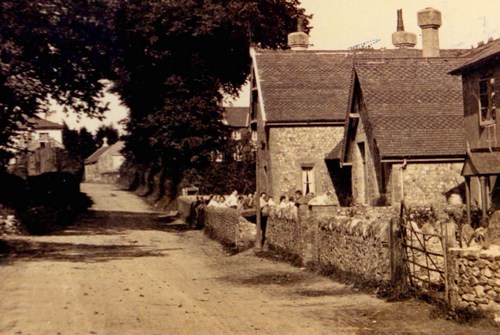
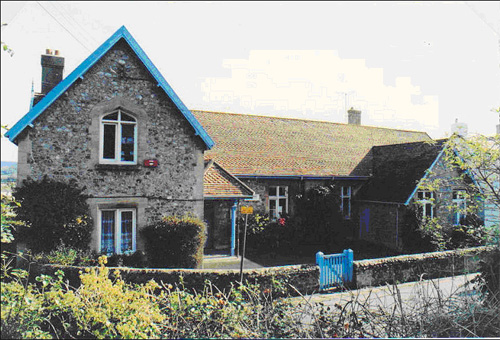
1836 There is a reference to the school being used for church services, during the period when the church was being rebuilt. However, there is no record of the name of the founder or the date of founding.
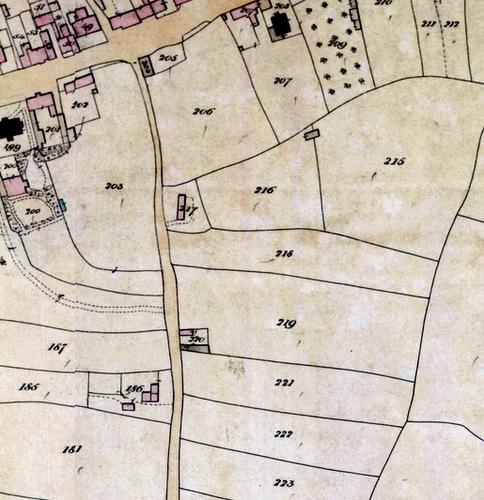

1880 Ordnance Survey Map showing the School
1841 Ordnance Survey map shows school in present position.
1842 The school is described as a ‘National School' and Thomas Richards as `National Schoolmaster' in the church register at his daughter's baptism. The schoolroom was over the schoolmaster's residence, and was reached by an external staircase.
1844 Lane name changed from Sea Side Lane to Sea Lane.
1846 George Miller and James Peck (1851) referred to in the church register as being schoolmasters, but they may not have had any connection with the ‘National School'.
1848 Kelly's Directory mentions a ‘National School' with William Mansfield as Master, and also an Independent School in Charmouth with a Mrs Cousins as Schoolmistress.
1859 David Board, who had been a lodging house keeper, was Master.
1863 The first official records held in the school, the school Log Book, starts in April 1863. Thomas Bunstone was then Master. The Head Teachers since then have been:-
Mr. T. Bunstone - 03.08.1866
Mr. G. Trott 27.08.1866 - 05.07.1878 12 years
Mr. H. Jones 02.08.1878 - 21.12.1916 38 years
Miss D. Knight 09.01.1917 - 22.03.1922 5 years
Mrs. A. Stewart 03.05.1922 - 09.04.1936 14 years
Miss N. Meade 21.04.1936 - 01.08.1961 25 years
Miss T. Pascall 13.09.1961 - 31.03.1977 16 years
Mr. J.N. Broadhurst 20.04.1977 - 31.12.1997 20 years
Mr. C. Vincent 01.01.1998 - 31.08.2012 14 years
Mrs. G. Morris 01.09.2012 -
Mr. Trott had previously been Head Teacher at Monkton Wyld School.
A Deputy Head was first appointed in the 1970s when Wootton and Whitchurch Schools closed. From that date to the transfer to the new building there were three, Mr Don Harris, Mrs Kathy Foot and Mr Mark Stratta.
Most entries below are selected extracts from the School Log Book or the Minutes of Meetings of School Managers, later Governors. Dates apply either to the entries in the Log Book or the dates of the Managers' Meetings.
The early years in particular give a picture, not only of Charmouth School, but also a general view of Local Social History.
1863
1 st April School Log begins.
2 nd April School closed Thursday for Easter.
6 th April Holiday postponed until Whitsuntide.
14-31 st Aug Harvest holiday.
1864 Children went to church every Wednesday during Lent.
13 th July Nothing unusual occurred today.
26 th Dec No Christmas holiday.
1865
10 th July Night school.
9 th Oct Sydney A. Potter awarded a Special Prize for being the best boy in Dorset in Prayer Book and Catechism.
1866 H.M.I. of Schools (W.H. Howard) visited the school. Now becoming recognised that the school building was totally inadequate.
28 th Feb The Pupil Teacher Examination at Honiton took place on the Saturday, and the Fast on account of the Cattle Plague on Friday. This was the last day of the School Year.
14 th March Thomas Bunstone. Certified Teacher 3rd cl. 2nd div. Thomas I. Bunstone. Pupil Teacher, end of 4th year. W.H. Howard. H.M. Inspector of Schools.
6 th Sept Found a boy on the Turnpike Road playing truant.
7 th Sept School let out to see Coastguards Drill.
13 th Sept Some boys kept in. They began to learn two verses of the Psalmsat 3 o'Clock (Written with a `C' in the Log) and didn't say it till 6.15.
1 st Oct Attendance very thin - a revel at Whitchurch.
6 th Nov The Clergyman (Mr Breton) examined the 1st Class reading and Mrs Breton the sewing. In the early days the school was regularly examined by the Rector and his wife. This was probably because the school was originally a church school.
21 st Dec Mrs Breton came this morning and gave prizes to those who had swept the Schoolroom for the last four months.
1867 Many entries in this year are typical of the time
All extracts for this year are taken directly from the Log Book .
2 nd Jan Very wet - no attendance this morning.
7 th Jan Pence taken after twelve o'clock.
16 th Jan A boy came just after the Registers were closed - by the blessing of the "New Code" he was excluded from the number for the afternoon.
23 rd Jan Kept in all the 2nd Class for being rather noisy.
24 th Jan The ex-pupil teacher came to give news of his success in the Examination for Admission into Normal Schools. (He had previously done 5 years as a pupil teacher.)
31 st Jan Punished several this morning who came with their lessons unprepared.
6 th Feb Punished a boy this morning for not saying his home lessons. He roared and attracted the notice of some passers-by.
7 th Feb Two late pupils of mine from Monkton Wyld came here to school for the morning.
8 th Feb Very wet - attendance small.
27 th March The Rector came this morning and inspected the work of the children, and this afternoon examined the 1st & 2nd Classes in Catechism for an hour.
29 th March Some children from 3rd Class kept in at dinner time and this evening to learn their tables.
30 th April Sent a boy, who couldn't tell all his letters, back from the 3rd Class.
3 rd May In consequence of the great fuss and waste of time in hearing the home lessons when they are not half learnt (which is the case every morning) I've discontinued them from today in the 2nd Class.
7 th May Cautioned the children about coming in late in the morning. Commanded those who couldn't come at 9 o'clock to bring a note from their parents.
8 th May Punished three boys of the 1st Class for coming late without a note.
14 th May Put two boys from 2nd Class down with the last class to learn the Apostles' Creed.
16 th May Punished the two boys who were kept in on Tuesday to learn the Apostles' Creed, and had had till this morning to do it, and couldn't.
17 th May Gave the 1st Class an extra lesson on grammar this afternoon.
22 nd May The Rector came this morning and offered to pay for the children (who were big enough to undertake the walk) to go to an entertainment at Lyme this evening.
23 rd May Kept in one boy till one o'clock to learn the 2nd Commandment, and punished him for running about the Schoolroom instead of learning it after school was over.
27 th May Made the children search for a pencil that was lost. We found it.
6 th June During the dinner hour I was obliged, owing to the number absent, to look for some of them.
11 th June Sent the pupil teacher after a boy who was playing truant. He brought him after much trouble.
18 th June A Friendly Society's Annual Day here in Charmouth; consequently attendance very slack this morning. Dismissed at eleven o'clock and gave the rest of the day for enjoyment.
19 th June Attendance very slack. On going to enquire for them I found a great many in bed tired with yesterday's fun.
20 th June Two boys who had been playing truant this morning kept in tonight until eight o'clock, and made to learn.
25 th June In consequence of a little girl falling over the steps yesterday I gave directions to the Monitor to be always near the bottom of the steps on the going out of the children. (The Monitor was a senior pupil paid to carry out similar duties to those now carried by Welfare Assistants.)
26 th June Two girls kept away by their mother because she heard I was going to punish them for pushing down the steps on going out of school.
28 th June Attendance slack this morning. Half holiday - Coronation Day.
4 th July Gave notice to those who came this afternoon of the Quarterly Examination tomorrow.
5 th July Gave them their first Quarterly Examination today.
Results:- Reading:- Examined 45; Passed 29; Failures 10; Doubtful 6.
Writing:- Examined 45; Passed 22; Failures 17 Doubtful 6.
Arithmetic:- Examined 45; Passed 26; Failures 15; Doubtful 4.
1st Standard very weak; 2nd Standard weak in Arithmetic, and 4th Standard very weak in dictation. Scripture and Catechism fair. On the whole I think they've done as well as I expected for this quarter.
11 th July Attendance very thin - The fair still going on.
12 th July Attendance still very thin. Kept the children after time to learn a little song.
23 rd July A boy brought to School by his mother this morning I kept him here till nine o'clock tonight.
25 th July Allowed the pupil teacher to play in a Cricket Match this afternoon. Place supplied by a Monitor.
24 th July The boy who was kept yesterday, kept again today till half past seven.
30 th July Girls sewed from 2.30 to 4.30.
31 st July Children came at ten minutes before two to learn to sing.
13 th August Extremely hot; children very lazy.
14 th August A woman came to School this Morning to make a complaint against one of the boys for throwing her boy's boots in the river last night.
6 th Sept The Rector came this afternoon and made enquiries for the absent ones.
11 th Sept Dismissed 4.45.pm. Second class kept in to learn spelling.
17 th Sept Several kept in to learn tables.
19 th Sept Several gone to a Dissenting tea meeting this afternoon.
24 th Sept Several from 1st Class kept in at dinner time to learn their home lessons.
26 th Sept Rector came in the School this afternoon and took down the names of some absent ones.
2 nd Oct Gave them the Second of the Quarterly examinations today.
Results:- (Interesting that failures rather than passes mentioned.)
Reading Examined 39; Failures 10,
Writing Examined 39; Failures 19,
Arithmetic Examined 39; Failures 10.
All the children in the 3rd Standard but one failed in Dictation. Second Standard also were rather weak in Writing, and the 1st & 4th in Arithmetic, and the 3rd and 4th rather weak in Reading.
3 rd Oct A good attendance this morning and very full this afternoon being the children's annual treat.
4 th Oct Rearranged the Standards and appointed the work for another Quarter.
8 th Oct Gave 1st Class a certain portion of that part of the Catechism relative to the Sacraments to learn as an extra lesson every dinner time till they are perfect.
14 th Oct A father came and took his boy away this afternoon on account of my punishing him for running away yesterday.
16 th Oct The boy who was taken away on Monday, sent back today through the mediation of the Rector.
18 th Oct A gentleman came and announced a reading, to be given by a lady in this schoolroom on Tuesday next for all the children of Charmouth. Admission free.
31 st Oct Kept in the Monitor and his class for inattention and noise this morning.
8 th Nov Several from 1st Class kept in this morning to do their sums.
15 th Nov Teachers and I stayed till one o'clock putting books right whose leaves were loose and out of place.
10 th Dec A stubborn boy severely punished this morning - he has not made his appearance this afternoon.
11 th Dec Several late ones punished.
1868
23 rd Jan Punished children for running about at dinner time and also some boys for smoking tobacco at the same time.
30 th Jan Some children who the Head was afraid of put back to lower classes and Standards.
31 st Jan Last day of School year.
6 th Feb Two boys punished for telling lies.
13 th March 2nd Class so inattentive to their spelling that they and their teacher were ordered to stay and
spell after twelve.
13 th May Those children who bring their dinners were ordered to put some forms down in the playground and eat their dinners every day during the Summer unless it rained.
29 th May The children came dressed up in oak twigs and leaves.
17 th June Very hot - children very sleepy indeed.
18 th June Children still very sleepy. Several allowed to sleep.
23 rd July A parent came to school for his boy and abused the Mistress at half past twelve in the Head's absence.
25 th August Several absent gleaning.
3 rd Sept Children's treat - Attendance ‘uncommonly good.'
7 th Sept Some children who were able to come to the treat absent with the excuse of no boots.
16 th Sept Monitor condemned to write two hundred words for letting his class play.
29 th Sept Confirmation, consequently the children were taken to church.
26 th Nov A parent complained that the boys were breaking down his hedge which is near the school.
10 th Dec Penny Readings took place in schoolroom. Someone stole the School fire-shovel.
1869
20 th May A mother brought her boy and complained because he had lessons to learn at home. She said she could not have the bother of his lessons. Apparently it was only part of a multiplication table.
21 st May Several off catching mackerel.
18 th June Two girls from 1st Class were kept in all the dinner hour to learn a lesson of ten minutes work. At two o'clock they managed to say it and were then allowed to go to dinner.
21 st June Girl who had been kept in (above) was sent by her mother with an `impertinent message' and was not allowed into school without the Clergyman's wish.
25 th June Last day in old school.
28 th June School moved temporarily to an old shop in The Street, opposite the end of Sea Lane, while a new school was being built. The temporary school may have been at, or in part of, The Limes, which is now part of Charmouth Lodge.
16 th July 11 children absent with Scarlet Fever.
4 th August The Clergyman, who lived next door, complained about the children congregating within twenty yards of his door.
5 th August The same Clergyman came again complaining that the children's singing annoyed him. They were only singing the Grace before and after meals!
6 th August A little boy lost his halfpenny.
11 th August Some children were absent attending the men working on the corn harvest.
26 th August The foundation stone for the `new' school was laid by the Rector's wife, Mrs Breton. All the village shops were closed that day.
18 th Oct New Monitor - Levi Love
2 nd Nov Only those children with no mother or sister at home were allowed to stay for dinner.
5 th Nov Several children absent engaged in taking the Pope (Guy) around the village prior to it being burnt.
30 th Nov A child came after the register had been marked, but before the two hours required by the Committee of Council so the register was altered.
27 th Dec School in session.
28 th Dec Children had a treat of a tea and Christmas Tree.
1870
7 th Jan Very dark in school - children could scarcely see to write.
1 st Feb Beginning of school year.
21 st Feb Some children who had been poorly were seen standing about the Churchyard. The mother said she didn't like to send them to school because they were so poorly.
10 th March H.M. Inspectors Report refers to Night School being examined.
30 th March The Church clock was altered which made many children late.
17 th June Last school day in temporary accommodation.
27 th June New school opened. There were not enough desks, and it was `noisy on account of the want of arrangement by curtain or partition for the juveniles.' (Infants)
22 nd July Three or four juveniles screaming made the school noisy and so progress was slow and the need of a division for the infants was again mentioned.
3 rd August Rector called to ask when there would be a holiday for Harvest.
5 th August School closed for a week.
27 th Sept Tea at the Dissenting School where many of the children go on Sunday Afternoons.
13 th Oct Attendance very slack because children were taking up potatoes and gathering acorns.
26 th Oct Children absent picking acorns and gathering apples.
21 st Nov No sewing on account of the confinement of the Master's wife.
1871
31 st Jan Government Returns had to be made up.
28 th Feb A girl was sent home for her money after several cautions. The mother sent for the girl's brother and neither reappeared that day.
1 st March The girl and her brother did not appear so another sister was sent after them and she was also kept away.
2 nd March Children informed the Master that the three would not be returning to school.
6 th March Children mentioned above appeared and brought their money.
24 th March The Master began to examine the hands etc. of the children before beginning work.
30 th May Three children suspended for irregular attendance.
6 th June Suspended children reappeared with a note from the Rector.
30 th June Entries in the Log Book changed from daily comments on the attendance and times of dismissal, to weekly reports on attendance and progress.
24 th Nov Penny Reading held in the evening.
1872
8 th April H.M. Inspector's Report states "More knowledge of special subjects will be required in order to ensure a grant. The offices (Toilets) of the boys and girls must be separated by a wall of
sufficient height. Two more groups of desks, 3 in a group, of about ten and a half feet in length, must be provided. More advanced Reading Books are required for the 1st Class."
3 rd May Monitor replaced for being absent without leave.
11 th Oct Mother kept her two children away because the girl had been put out of her office of school cleaner.
1873
14 th March One of the teachers and her class kept in after time because of the lazy and inattentive work of herself and her class.
21 st March H.M.Inspector reported unfavourably on Arithmetic in the upper class. Two sessions of Geography each week, were changed to Arithmetic for the 1st Class. Geography was also excluded from the Government Examination until better results were obtained in Arithmetic.
4 th July Mumps epidemic.
1 st August Whooping Cough epidemic.
1874
18 th Feb As the children were under Secular Instruction for less than two hours, no attendance could be marked in the Register, and it was, therefore counted as a half-holiday.
1875
16 th Feb H.M.Inspectors report states again that `another set of Offices, either for the use of the Girls, or the Master's House, ought to be provided.' It also said that a Coal House was needed.
3 rd May Pupil Teacher transferred from Bothenhampton Board School.
16 th July Ellan Durrant, Pupil Teacher's father refused to sign the form of agreement issued by the Council Office on account of her being unable to continue her studies for health reasons. She continued as Monitoress.
1876
7 th July Attendance slack because of hay-making.
16 th Nov Concert in school in aid of Charmouth Village Hospital.
1877 Difficulty in maintaining sufficient level of subscriptions, so school becomes a `Board School.' (Provision for Board Schools was made under the Education Act of 1870, which stated that parents were obliged to pay up to 9d per week when they were able. The remainder of the finance was to be met by local rate payers. Children were supposed to attend Board Schools up to the age of 13.)
8 th June A boy was kept in at dinner time to learn his home lessons. His mother came and demanded that he be allowed home and when the Master refused she became abusive and was expelled. He did not reappear the following week.
19 th June The Rector distributed prizes won in the Diocesan Examination. Jane Gordge and Arthur Hunter received 7 pence each in books and Louisa Hyde and Sarah Durrant 5 pence each in books.
21 st Dec Mrs Pavey brought packets of sweets for the children in the morning and cake and oranges in the afternoon.
1878 Charmouth and Catheston School Board was established.
19 th Feb School examined by the Rev.d W.W.Howard H.M. Inspector.
4 th March G.H. Trott Certified Master 1st Clafs. (Where a double `s' appears in the Log, the first is a `f'.
1 st May Schoolroom used for the School Board Election. Polling from 10 a.m. to 5 p.m.
4 th Oct Pupil Teacher in her fifth year transferred to Charmouth Board School from Wool National School.
6 th Dec Several children absent on account of the Herring fishing.
1879
14 th March Attendance Officer appointed.
10 th Oct 1st Class boys tested in Physiology and girls in Domestic Economy.
1880
30 th April H.M.I.'s Report states that another classroom and lights in the roof were much needed.
10 th Dec Reference to the noise made in building a new classroom.
1881 A new classroom built, at a cost of £350. The school could now take up to 140 children.
10 th June New classroom used for the first time.
1882
11 th August Poor attendance put down to Charmouth being full of Visitors which was expected to continue for some weeks.
1883
23 rd Jan Received the result of the Drawing Examination and the school again obtained the mark of `Excellent.'
31 st Jan Copies of H.M.I.'s Reports appear annually, from 1872. Comments are made on the "Standard Subjects" in addition to Geography, Singing, Needlework and Discipline. No mention is made of other subjects.
16 th Nov All `pence' had to be paid on Monday mornings. No child was admitted without the fee.
7 th Dec Improvement in attendance attributed to the action of the School Board in attending weekly into the state of attendance.
1885
31 st August Infants' standards fairly good except 4 year olds.
4 th Sept Mr. Jones, the School Master, was instructed to have washed the hands and faces of all children who come to school with them dirty.
4 th Sept The Hon. Clerk informed the Board that Thomas Fippin refused to flush out the closets more than once a week unless he was paid extra money. The Hon. Clerk was instructed to inform Fippin that his services would not be required after that day. Mr. Tarr informed the Board that he had seen Amy Newton and that she was willing to flush out the closets every day for 6 pence a week. It was resolved to engage her to do the work.
2 nd Oct The Hon. Clerk informed the Board that Mrs Larcombe had complained that her daughter Ellen had been struck on the arm by the Assistant Mistress. The Master was called before the Board and instructed to give a warning to the Assistant Mistress.
9 th Oct The School Master was directed not to admit any child to the school suffering from the Eruption on the Face now prevalent in the village.
1886
5 th Feb Mrs. Edwin Hodges waited on the Board to complain that Miss Coombs, the Assistant Mistress, is continuing striking her son Herbert during lessons. Miss Coombs was called before the Board and admonished to be more patient with the boy, who appeared to be, from his Mother's account, very dull and stupid, since he had the fever.
18 th June Children admitted from a private school, but they were so backward they were put in a lower class and they were even a drag on that class.
6 th August The Hon. Clerk was instructed to write to the Education Dept and report that the Board intended to meet the increased expenses of the School Board, not by increased scale of School Fees, but by a reduction of expenses of the school Staff. It was resolved to curtail the expenses of School Maintenance by the dismissal of Miss Coombs, the Assistant Mistress, after Christmas.
3 rd Sept The Hon. Clerk was instructed to write to the Education Dept. and inform them that the Board in end to dismiss the School Attendance Officer as the fines imposed by the Magistrates for non-attendance are not enforced and the Board consider the payment of an Officer whose services are useless and unnecessary. Teaching staff to be reduced in order to cut down expenditure.
3 rd Dec The Hon. Clerk was instructed to give Miss Coombs three months notice to leave, to date from 28th November, the Board wishing to reduce the school expenses, the Education Dept. not giving such extra grant as was anticipated when Miss Coombs was engaged, and at the same time to state that the Board will be pleased to give a certificate enabling Miss Coombs to take another appointment.
1887
2 nd April The Hon. Clerk informed the Board that the Education Dept. had omitted to include the usual £2 for Pupil Teacher's Education, which had been paid to Mr. Jones as an addition to his salary.
4 th Nov In the absence of the Chairman and Vice Chairman it was proposed by Mr. Gale and seconded by Mr. Oliver that Mr. Hopkinson take the Chair. Mr. Hopkinson declined so doing, and as no other Chairman was proposed the meeting broke up without any business having been transacted.
2 nd Dec Mr. Bradford attended the Board Meeting and stated that his boy had been sent home by the School Master this day fortnight. The boy had not been to school since as Mr. Jones has said he was a bad boy and was not wanted. Mr. Jones was called before the Board and stated that the above was a fabrication either on the part of the boy or his father. About a fortnight since the boy was playing and talking in school hours. He gave him a pat on the back with a short stick (which Mr. Jones produced) whereupon the boy burst into tears and said he would go home and tell his father, but he, Mr. Jones, had not sent the boy home.
1888
6 th Jan Letter read from Mrs. William Horly respecting the dirty state some children came to school. The Hon. Clerk was instructed to authorise Mr. Jones to send any child home who came to school dirty with directions to clean the child.
31 st Jan The end of year H.M.I.'s Report states ‘The falling off in the general work of the school must not be attributed to the Master who is an indefatigable worker, but to the action of the School Board in not maintaining an efficient staff."
9 th March Progress is impeded through insufficiency of staff.
4 th May Mrs. Jones be appointed Assistant Mistress at the yearly salary of £10, to date from 25th March last as Mrs. Jones had been performing duties for several months. Mr. Jones, on being informed by the Chairman of the arrangement, stated that he only wished sufficient salary for Mrs. Jones as would recoup him for the payment of a servant whom he was obliged to employ to do the housework, as Mrs. Jones was occupied in the school, and that £7 per annum would cover the expense. It was, therefore, proposed that Mrs. Jones be appointed Assistant Mistress in the school at £7 per annum.
1889
7 th June Rector of Catheston insinuated, at a Clerical Meeting, that no religious instruction was given in Board Schools, including Charmouth. A copy of the Time-table, showing the amount of religious instruction given, sent to the Rector requesting him to retract his statement.
1 st Nov Miss Rendall from National School, Whitchurch appointed.
1891
29 th May Several children who attend very irregularly were so retarding the progress of the rest of the class that they were warned that if they could not keep up, they would be put in a lower standard.
1 st Sept School fees abolished.
30 th Nov A School Penny Savings Bank established to encourage thrift. The Board decided to add a penny to every shilling deposited.
24 th Dec Because there was to be a Drawing Examination on the 7th January the Christmas Holiday was withdrawn.
1892
31 st Jan H.M.I.'s Report states that a porch was required for girls to hang their bonnets.
28 th Oct Concert given at which sufficient funds were raised to pay the interest on the School Bank Deposit Account and to buy Prize books to encourage regular attendance.
4 th Nov Nearly £20 deposited in the School Bank in the first year.
23 rd Dec School presented with a complete set of Window Blinds with Rollers.
1893
25 th August New ventilator fixed.
8 th Sept Lecture given by Mr C. Fletcher, Fellow of Magdalen College, Oxford. Funds devoted to erection of a swing for the Infants.
10 th Nov Major General Hales promised prizes to the most regular and proficient boys and girls in each class.
1894
15 th May New forms (benches) received.
22 nd August Entertainment given in the Evening to raise money for prizes to be given to Scholars for regular attendance.
9 th Nov Board expelled a boy whose parent violently abused the master.
4 th Dec Annual Drawing Examination. Two boys absent through want of boots.
1895
21 st June Very irregular attendance owing to the Lambert's Castle Festival.
1 st Nov Money from Penny Savings Bank placed in the Post Office Saving Bank.
1896
31 st Jan Annual H.M.I.'s Report states that "a system of physical exercises should be developed."
1 st May Being May Day girls paraded through the village decked with flowers and carrying banners and floral wreaths.
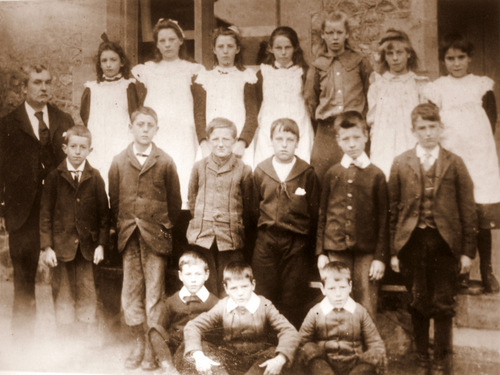

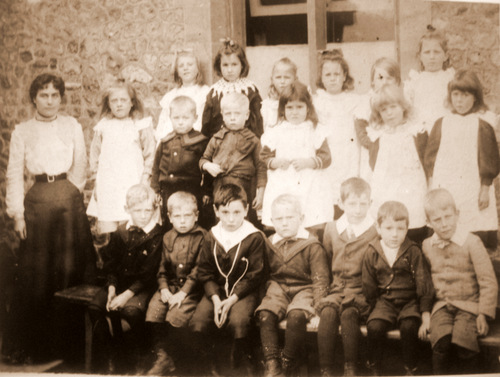
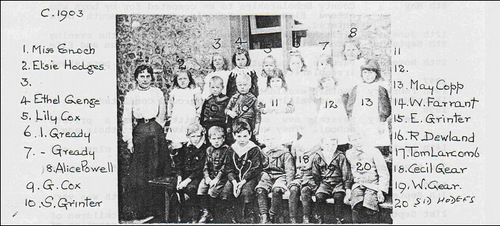
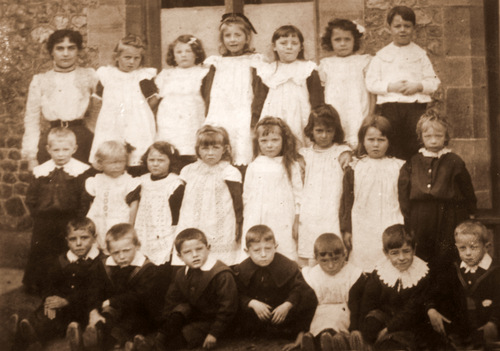
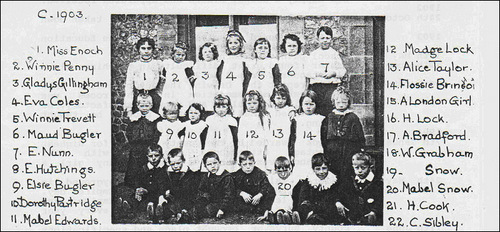
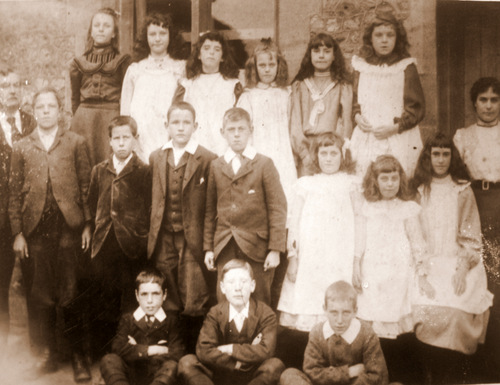
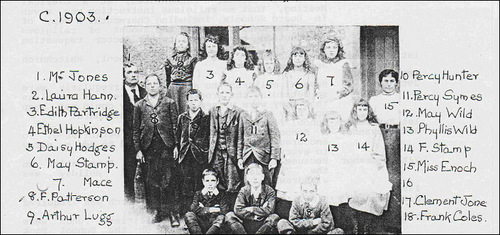
Below are pictures of the 4 schools whose children joined Charmouth School when they were closed
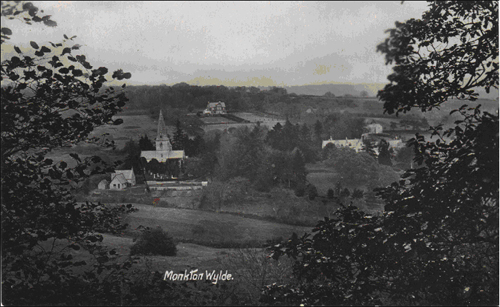
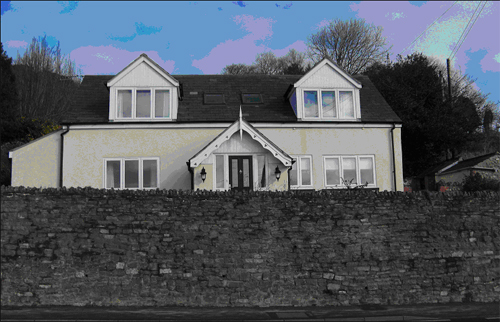
Monkton Wylde Primary School closed in April 1908. The school was demolished and there is now a privately owned bungalow on the site.
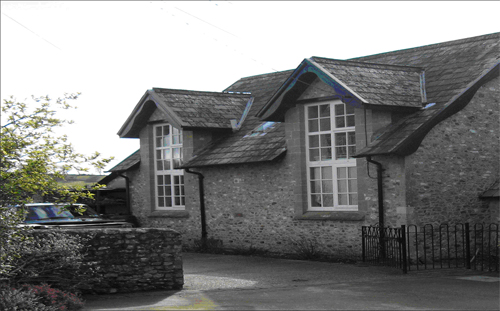
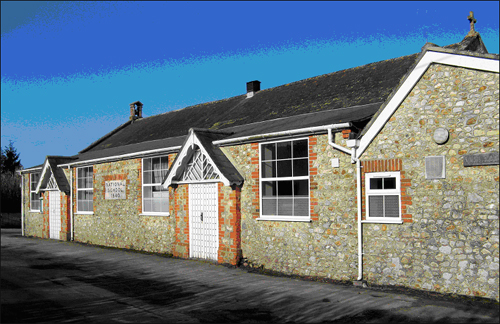
Whitchurch Canonicorum National School, founded in 1840, closed in September 1970. 22 children were admitted into Charmouth School. The building was converted into the Village Hall by Mr Ronnie Izod.
With the exception of Stanton the above schools have a cross on the roof indicating that, at some time, they were probably church schools. Charmouth is one of only two primary schools in the area that are not church schools. The other one being Bridport County Primary School.
8 th May County Scholarships to be competed for by boys who attend Elementary Schools. Some Charmouth boys entered.
12 th June Girls held their Flower Class Treat in the evening
9 th Sept A Concert held in aid of the School Drum and Fife Band.
20 th Nov Parents prosecuted for their child's persistent irregularity.
1897
19 th Feb Monthly examination held.
18 th June The gravelling of the playground completed.
1898
14 th Feb Several new scholars admitted from a private school. They were found backward for their age.
1899
14 th April Reading books received for the first class and slates for the lower standards.
3 rd Nov The Master's Salary was increased by £15 per annum in recognition of 21 years service.
1900
7 th Sept Attendance much reduced because Charmouth was very full of visitors.
21 st Sept A case of diphtheria reported and the children of the family ordered not to attend until sanction of the Medical Officer was obtained.
12 th Oct The School Board appointed a committee for weekly ‘Supervision of attendance'. Improvement noted.
1901
22 nd March New supply of books, slates and apparatus received.
1902
24 th Oct The School chimney, being unsafe, was taken down and rebuilt.
1903 The School Board dissolved following the Education Act 1902.
15 th May School painted externally.
19 th June Master found great difficulty in teaching alone all standards from 3 to 7.
20 th Oct In his report the Drawing Inspector stated that the desk accommodation in both rooms was insufficient, obsolete and very unsatisfactory. He also stated that the Infants should be taught drawing.
1904
7 th Jan Shields awarded by the County Council for highest percentage attendance. Any boy with full attendance was awarded a medal and any girl a brooch.
24 th May Children saluted the flag, on the playground in front of the school on Sea Lane, on Empire Day. Special lessons on the British Empire and patriotism. This practice continued every year until 1933.
11 th June County Surveyor brought plans and specifications for new buildings.
17 th June Many children absent at the Lambert Castle Race Day.
24 th Oct New cloakrooms completed on front of the school.
1905
31 st Jan Only sufficient desks for half the Infants.
29 th Sept A pupil left to go to the Bridport Pupil Teacher Centre.
1906
1 st June Four new desks received.
8 th June Attention of Sanitary Committee drawn to the shortage of water at the school.
14 th Sept A new water tank and fresh water supply brought to school.
1908
27 th April Children admitted from Monkton Wylde. They were transported by Mr. R. Morgan, Coach and Horses Hotel at a cost of 5 shillings each return journey
19 th June Attendance poor because of festivities at Monkton Wyld.
4 th Sept A new skylight fitted in roof.
18 th Sept Inadequacies of playground space mentioned.
1909
19 th March Coastguard Station closed. Nine children left as a result.
9 th July A start made on construction of new playground.
3 rd Sept New playground completed. A swing presented.
8 th Oct New playground needed draining. It was considered to be dangerous to health.
1910
18 th March First Medical Inspection of scholars.
1912
4 th June 14 changes of staff in six months.
1913
14 th Feb Cookery classes started.
12 th Sept School repainted and play shed asphalted.
1914
21 st Oct Trafalgar Day commemorated by special lessons.
1915
1 st June Collection for Empire Day Soldiers and Sailors Fund. (11 shillings)
1916
23 rd June Queen Alexandria Day. Collection made for Lyme Regis Hospital.
21 st Dec Public Meeting in the School Room at which the Rector presented the Head Master (H.L.Jones) with a cheque for £67 on his resignation.
1917
9 th Feb Due to lack of fuel all the children taught in one room.
3 rd Sept New school year. Children put into fresh classes and new work commenced.
1918
18 th March A Cargo Boat was torpedoed in the Bay. The German Submarine was within sight and the whole village went onto the cliffs to watch the operations.
1919
18 th Feb Dancing classes commenced in the Church Hall. Two classes in the morning and two in the afternoon, for half an hour each.
21 st Nov Several children were excluded, some for Impetigo others for dirty heads.
1922
10thJuly 'Terminal' Examinations were started throughout the Upper School.
11 th Nov The Gardening Inspector gave the boys a whole afternoon's instruction.
1923
15 th Jan Two children excluded with scabies.
1924
28 th Jan Rev. Markby took the Senior Class in Scripture.
24 th March Land purchased at the rear of the School for £300.
1925
17 th March All the children, Infants included, took part in the Choral Competition in Bridport.
27 th July School opened after Scarlet Fever epidemic. Had to wait several days for the fumigation to take place.
23 rd Oct A partition was erected in the big room.
5 th Nov Prize awarded by Aboricultural Society for an essay on the Larch Tree.
1926 Playground opened on land at rear of school purchased from the Church.
21 st June Supervisor for Physical Education visited the school.
10 th Nov A copy of the Gardening Report stated that the Head Teacher and scholars were interested and active in the garden. Attempts to control pests were made with paraffin emulsion. A Gardening Examination was also held each term.
1927
16 th Feb A 13 year old boy died of double pneumonia after one day's illness.
22 nd June Girl excluded suffering from ringworm.
13 th July First report on the Inspection in Religious Knowledge.
4 th Oct A new Time Table received approval from the County Office.
1 st Dec The children gave an Entertainment in the Church Hall in the evening to raise funds for Sports and Christmas Prizes.
1929
4 th March Miss Churchill, Supplementary Teacher, received notification that she had passed the Preliminary Certificate Examination and was therefore recognised as an Uncertificated Teacher.
5 th March First Junior Schools Examination, forerunner of the 11+ Examination.
26 th April Presentation made by Mr. Pavey to two children for the best collection of wild flowers made during the Easter Holiday.
11 th May 1st Class gained a 1st Class Certificate at the Folk Dance Festival at Bridport, and the Juniors a 2nd Class Certificate for Singing Games.
1930
14 th Feb Miss Wild, Uncertificated Assistant dislocated her knee whilst taking astride jumps during the Physical Exercise period.

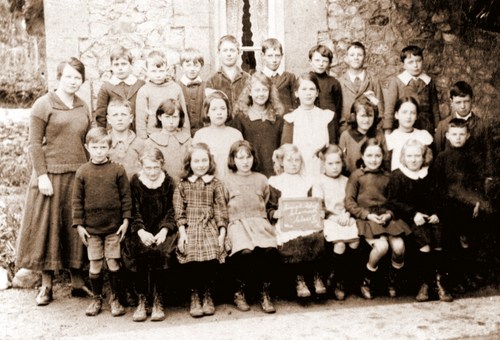

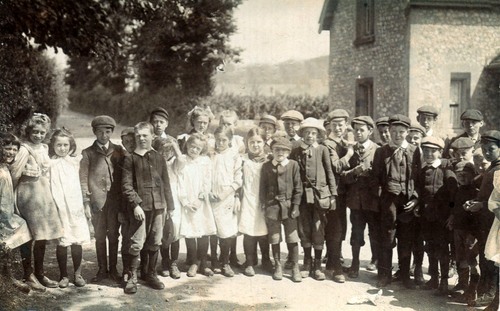

Back Row Miss Wyld, Dorothy Dampier, Herbert Newton, ? Austin, Norman Farrant, ? ?, ? ?, Fred Turner, Gladys Dampier, Effie Stewart, Mrs Stewart ( Head Teacher).
Middle Row Stanley Stapleforth, ? Harris, Margaret Stoodley, Crystal Lenthal, ? ?, Jim Culley, Tilly Graham, ? ?.
Front Row Eddie Austin, Geoffrey Row, Stanley Lugg, Betty Grinter, ? ?, ? ?, ? ?, ? ?, William French.

Back Row William Elliot, Jack Elliot, ? ?, Stanley Newton, Gerald Turner.
Middle Row Miss Pitt, Bernard Lane, Gilbert Stamp, Ernie Lenthal, ? ?, Daisy Kish, Jacob Farrant, Mrs Stewart ( Head Teacher).
Front Row Stanley Rowe, Queenie Quock, Rosy Lane, Lily Austin, ? ?, ? ?, Charlie White.

Back Row Milly Stamp, Phyllis Lenthal, Doris Dunn, Wilfred Holman, Emanual Newton, George Larcombe, Ralph Rowe, Andrew Findlay, ? ?,
Middle Row Mrs Stewart ( Head Teacher), Hilda Culley, Ruth Quick, Gwen Lane, Ruth Gillingham, Vera Turner, Miriam Brake, Vera Culley, Hilda White,Joan Edwards, Freda Childs, Winnie French.
Front Row Ruth Edwards, Brenda Austin, Robert Dyke, Denis Lezzard, Gordon Findlay, Donald Dampier, Sidney Jezzard, ? ?, William Jolliffe, Jack Turner.
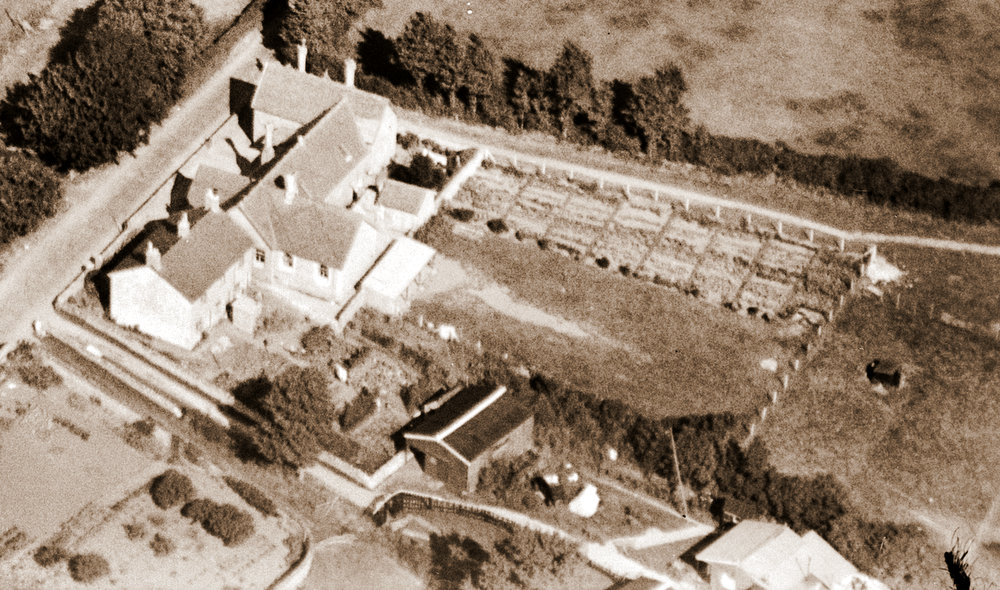
An aerial view of the school taken in 1927
1932
19 th March A brother and sister died through Measles.
4 th July Correspondent to the Managers unpaid from this date.
18 th July 10 year old girl died of heart trouble following pneumonia.
21 st Dec School held a Mothers' Day.
1933
11 th Jan School received notification from a Doctor in Dorchester that one little girl had to lie down every afternoon. An improvised couch was made.
7 th Feb School gardens closed down.
15 th May Two very backward boys admitted aged 12 and 13. Neither could read and the younger one did not know the letters of the alphabet.
24 th May Empire Day. Rev. Bennet gave the elder scholars a talk on the relief of Lucknow.
14 th July A Sports Evening was held in the Playing Fields from 5.30 to 7.30 p.m.
1935
18 th Jan H.M.I.'s Report stated that about one third of Class 2 were "probably dull and certainly backward."
22 nd Jan Two boys attending Woodwork Classes in Lyme Regis had to pay for their own transport.
1 st Feb Notification received from County Medical Officer that under the Milk Scheme for Schools, Mr. P.J. King, Rax Dairy, Bridport, was approved for supplying pasteurised milk for consumption by the pupils.
30 th May First District Council's inoculation against diphtheria.
11 th Nov The children observed 3 minutes silence and listened to part of the Service from the Cenotaph. A wreath of Flanders poppies was put on the local War Memorial.
1936
28 th Jan To commemorate the Funeral of King George V the children were taken to a memorial service in the Church.
14 th July First end of year examinations mentioned.
1937
21 st July Five children tested in swimming and given certificates.
8 th Dec Owing to snowy weather buses were unable to take children to Woodwork and Cookery classes.
1938
10 th March Monkton Wyld bus replaced by a taxi. As children from Penn were then expected to walk since they lived within the two and a half mile radius one little girl was kept away from school until July 11th when the bus was reintroduced.
16 th March Managers' lent their cars to transport 25 children to Whitchurch to look around the church.
7 th April Mr. Keeley, a local gardener, agreed to take the boys for gardening. Allotments were rented from the Parish Council.
29 th July Slow combustion stoves installed.
8 th Sept A Mr. Westlake inspected the hive of bees.
29 th Sept Instructions for Air Raid Precautions in Schools were sent to all schools.
5 th Oct An Education Official visited the school to enquire into plans for the provision of A.R.P. trenches in the field behind the school.
1939
3 rd Feb Rev. Moss, Rector of Monkton Wyld, to give Religious Instruction for first half hour of day.
11 th Sept 36 evacuated children ranging in age from 4 years to 14+ admitted from St Peter's C.E. School Paddington accompanied by 3 certificated teachers, led by F. J. Thornton Esq. One class occupied the shelter behind the school. Later the coal store.
13 th Sept The Government commandeered all halls for Army purposes, so there was no woodwork class at Lyme for the boys, and the girls, who had been having Cookery classes, are taking Housewifery in the School-house.
21 st Sept Some evacuees began to return home.
6 th Oct Older boys boarded up the play shed to make it weather proof.
9 th Oct Doctor and nurse inspected evacuees and found one verminous head and two cases of impetigo.
23 rd Oct Air Raid Drill taken.
30 th Oct Mr. Thornton took three days for his half-term holiday this week. His class combined with Class 1 under the Head Teacher.
7 th Dec Mr. Thornton's class had to share Class 1 room as the weather was too cold for work in the play shed. In the cold weather the whole school went into Lower Sea Lane and the boys ran 100 yards, either towards the sea or The Street, and the girls ran 100 yards in the opposite direction.
18 th Dec Mr. Thornton commenced his Christmas holiday this week and returned on January 1st to take charge of evacuees during that week.
1940
8 th March 59% attendance due to German Measles Epidemic.
31 st May Meeting to consider Air Raid Precautions. Children to lie on the floor under the desks. Cellophane strips on windows, and fine mesh wire fitted to all windows, skylights and glass doors.
17 th July County Architect visited the school to discuss the possibility of constructing trenches in the school playing field.
26 th July School closed for one week of Summer Holiday. The Teachers appear to have taken holidays on a rota basis while the children remained in school.
28 th August Classes 1 & 2 walked to Whitechurch Canonicorum to look over the church.
29 th August Children picking and selling blackberries to augment the school contribution towards the Spitfire which Dorset hoped to provide.
9 th Sept One child won a Scholarship to Lyme Regis Grammar School.
17 th Oct Children taken to gather acorns for pig keepers.
1941
13 th Jan Mr. Thornton returned to London. His house had been bombed.
5 th Feb Respirators inspected by A.R.P. Wardens.
7 th Feb County Architect called to enquire if sand and buckets of water had been placed in each classroom
20 th May Letter from Dorset Education Committee regarding holidays, and children helping in hay, corn and potato harvesting. Letter should be sent to local farmers asking for their requirements and stating terms on which children might be employed.
22 nd May In connection with the War Weapons Week at 3.0p.m. the children formed a procession at the top of the hill and marched to the Playing Field where Children's Sports were held.
12 th Sept Use of school by troops for weekly dance - month's trial.
24 th Oct One case of Infantile Paralysis reported.
1 st Dec Because of dark mornings school opened at 9.30a.m.
1942
6 th Jan Mr. Thornton joined His Majesty's Forces.
27 th March At 3.00 p.m. and 7.30 p.m. a Warship Week Entertainment was given in the school. Most of the children took part. £12.15.0d given to Exchequer.
1 st May A discussion of behaviour of troops at dances. Mr. Toyne interviewed the C.O. and asked for the attendance of a senior N.C.O. at dances.
1 st July H.M.I. Inspections were carried out Annually even during the War. All were full of praise for the excellent work being done in very difficult conditions.
1 st Sept 18 children sent flax pulling at Befferlands Farm, and for the following 4 afternoons at 8d per hour.
21 st Sept Classes 1 & 2 picked rose hips in the afternoon. 31 lbs were sent to Bristol.
25 th Sept School collected £100 in National Savings towards the effort being made by Dorset to replace H.M.S. Dorsetshire.
25 th Nov Architect called to discuss Air Raid Shelters.
7 th Dec A.R.P. to be notified daily of attendances. Anyone hiring school must provide own fuel. Military occupied Church Hall.
1943
29 th March Annual report on teachers made by Head Teacher. Managers commented on Head. Easter holiday to be fixed to coincide with potato planting. Other holidays to be fixed at short notice with reference to local individual needs. Mrs. Little expressed regret that children were paid for agricultural work when they should be encouraged to give willing help to their country.
27 th May Mayor of Bridport presented Certificate awarded to the school for the part played in the successful H.M.S. Dorsetshire Replacement Campaign. School contributed £245.7.6d
11 th June The school target for Wings Week was £80. £160 was raised.
21 st June School Meals Service being organised throughout the County.
20 th Sept One girl left on being invited to attend the new school at Monkton Wyld where she would receive free education.
10 th Nov School meals commenced. A mobile canteen brought hot meals from the Bridport Centre.
1 st Dec The Commanding Officer of the American Forces Company stationed in Charmouth gave a talk on America. The children thanked him for the 30 lbs of sweets the Americans had given them.
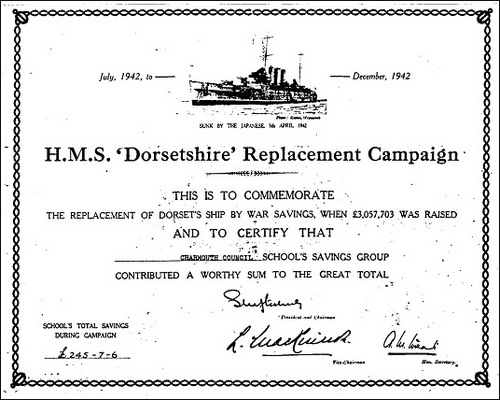
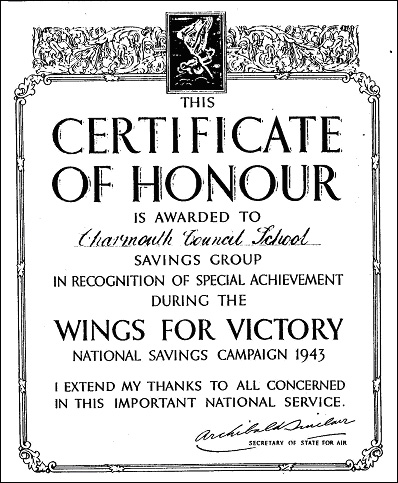
1944
11 th Jan 2nd Lt. Thornton, who came to the school in Sept. 1939 in charge of the evacuees from Paddington, was killed in action in Italy on Nov 23rd 1943.
13 th March The Rev. Ross gave lantern slides on Canada.
20 th March Holiday dates to be fixed by County for School Meals and transport. Still some flexibility to fit in potato harvesting.
12 th June Murphy Wireless supplied by L.E.C.
19 th June The school raised £350 towards "Salute the Soldier week.
26 th June Two official evacuees from London readmitted. They left London to escape the danger of Pilotless (V1) airplanes.
31 st Oct The senior boys attended their first Woodwork class in Bridport.
1945
7 th May The Cessation of Hostilities was officially announced on the Monday evening.
8 th May Tuesday was V.E. Day. School closed for two days.
10 th May Ascension Day. Children attended church at 9.30 a.m. and given a picnic on the beach in the afternoon.
29 th May Mrs. Way, teacher, congratulated on walking from Marshwood in severe weather.
11 th June Last official evacuee readmitted.
18 th June A Ministry of Labour representative interviewed the school leavers to help them in finding suitable employment.
9 th July Last official evacuee returned home.
4 th Sept Parish Council asks Managers to organise a victory tea.
23 rd Oct The total collected by the School Savings Group from the beginning of the War until the end of Thanksgiving Week amounted to £3,021.10.6d.
13 th Nov Caretakers' wages raised from £26 to £36 a year.
1946
1 st March Caretakers' wages raised from £36 to £42.2.0d.
8 th May Miss Jex called to discuss girls Cookery Classes at Lyme Regis Grammar School.
15 th July Class 1 had their first swimming lesson: evidently in the sea.
10 th Sept 15 children admitted from Stanton St Gabriel.
12 th Sept H.M.I. Mr. Matthews called to make arrangements for a school canteen and kitchen to be started in Charmouth. 50 children had to be fed in a room with seating accommodation for 30 children.
24 th Sept Club Room in Church Hall used for School Meals instead of classrooms.
1947
24 th Feb The question of the danger in Lower Sea Lane from fast traffic was discussed. A speed limit of 10 m.p.h. was suggested. Class 1 was taken to the beach at low tide to see the fossilised remains of the submerged forest lying off Charmouth beach. They found fossilised hazel nuts and acorns. Mr. Pavey pointed out the spot where two mammoth tusks were found in 1820.
8 th March The 10-11 age group attended Lyme Regis Grammar School to take the Examination for entry to Secondary School.
20 th May Cleaner resigned because of heavy work entailed connected with the stoves. It was suggested stove be converted to gas.
6 th Oct The school Canteen opened in the Church Hall.
22 nd Oct Dufay Chromax Film Projector provided by County.
9 th Dec While the Dentist administered gas to 16 children, the remaining children were taken to the Playing Fields for games.
1948
1 st March The 11+ boys and girls spent the day working on the school allotments. (The allotments were where No. 6 Parkway now is.) A load of farmyard manure was wheeled in and one plot was planted with potatoes.
12 th July Miss Z.P. Furnis, a 1st year student of St Katherine's College, Tottenham started two weeks' school practice.
13 th Sept The Principal of Weymouth Training College called to make arrangements to send trainees for teaching practice.
18 th Oct The senior children travelled by train to the Dorset Industrial Exhibition at Dorchester.
1949
5 th April Miss Spark sent to take charge of Whitechurch Canonicorum School in the absence of the Head Teacher.
29 th June Throughout June all children, except Infants, taken swimming daily.
4 th July New stoves to be fitted. Gas would cost £200, which was considered too much.
30 th August School became a Junior School. 11 older children and one teacher transferred to Lyme Regis Senior School.
1950
10 th Jan 11 washbasins fitted into cloakrooms.
8 th May Stoves were badly in need of repair.
1951
7 th Feb Dr. Lang gave a short talk on an octopus which the boys found dead on the beach.
12 th March Stoves fitted! First ‘Parents Day' held.
17 th Sept Land adjacent to playground purchased at a cost of £1500.
2 nd Oct Mr. Dodd sent to take charge of Wootton Fitzpaine School owing to illness of Head Teacher.
20 th Oct Class 1 taken to Bridport for West Dorset Children's Festival. Pauline Turner received a Certificate for Elocution.
1952
6 th Feb No school Broadcasts owing to the sudden death of the King. George V1
27 th Feb The field, purchased in September, between our school field and the new Council Houses was ploughed and became the new School Gardens. The school gave up the Allotment Gardens. The wall on the North West corner of the school premises was taken down and rebuilt closer to the School House to give a wide entrance to the new road leading down to Wesley's Close.
4 th April Class 1 planted potatoes in the new School Gardens to act as a ‘smother' crop.
1953
22 nd Jan Bramley apple tree in new field pruned and sprayed
28 th Jan Nine cases of German Measles in the Infants.
2 nd March School dinners increased to 9d, 8d & 7d
9 th March Fencing installed around new field. W.I. Hut was inspected and found unsuitable for a School Canteen.
12 th March An official drought announced. Children busy every afternoon in the new garden.
31 st March Hedge dividing old school field from new one taken out. School canteen closed. Hot meals brought from Lyme Regis Canteen.
21 st May Class 1 presented a Coronation Play entitled "Our Flag", and Mr. Pavey presented each child with a Coronation Souvenir Spoon.
14 th July The Education Committee arranged a showing of the Coronation Film in the new W.I. Hut.
1954
1 st Feb Every tap frozen on school premises.
30 th Sept School playing field ploughed and sowed with 84 lbs of grass seed.
1955
25 th Oct County presented school with seven dozen spring bulbs.
1956
22 nd Feb Dr. Armit told Mr. Steven not to attend school as his son aged 7 years old had suspected Para Typhoid.
19 th March Even though stoves were lit at 6.00 a.m., it was still cold at 9.00 a.m. in bad weather. New stoves were to be installed.
23 rd March Class 1 taken into School House to see the Queen lay the foundation stone of the new Coventry Cathedral on Television.
14 th May Poliomyelitis Vaccination Clinic.
27 th Sept First Harvest Service. Produce sent to Lyme Hospital.
10 th Oct School redecorated externally. New floor laid in Class 1, which was also redecorated.
1957
21 st Feb New wireless set received.
14 th May New wireless proved unsatisfactory, new set received.
22 nd May Emergency meeting held - Mr. Woods, the only qualified teacher other than Miss Meade, was to be transferred to the Midlands area, where there was a great shortage of teachers. Dorset had to provide 63 teachers. Deputation sent to Dorchester - supply teacher to be appointed to teach either mornings or afternoons.
11 th Nov One case of Scarlet Fever.
1958
8 th Jan Seven children attended weekly classes for poor posture and foot defects.
1959
30 th Nov School meals taken in classrooms again as there weren't enough to warrant hiring the Church Hall.
1960
21 st March Children had lunches in school instead of Church Hall.
2 nd June Toilets renovated and connected to Charmouth Drainage. Central Heating (solid Fuel) to be installed.
12 th Oct Central Heating started.
1961
9 th Oct Major renovations began on the School House.
19 th Oct First meeting after school of Children's Club for Juniors, 3.45-4.45 p.m. Country Dancing and games.
26 th Oct Upright Steinbeck piano delivered.
27 th Oct An Autumn Sale held in school to raise funds for Christmas tree presents and start a School Fund. £26.5.0d was raised.
16 th Nov Two netball posts received. The field has been marked out for football.
30 th Nov Two fire extinguishers delivered.
6 th Dec School uniform introduced. A badge for cap and blazer would depict a seagull. School decorated internally.
1962
10 th Jan Main classroom redecorated.
23 rd Jan A record player, with speaker incorporated, delivered.
2 nd May Football posts erected on the school field.
12 th July School decorated externally.
20 th Sept A new wooden boundary fence was erected on the South side of the playground.
23 rd Nov School warning signs erected on Lower Sea Lane.
1963
25 th Jan School functioned for first time since term began on January 9th, due to severe weather conditions.
12 th March The front school playground was resurfaced. Children were taken to the beach for a short recreational period as they were unable to go out in the playground and the field was too wet to use
21 st March Part of the School House garden wall collapsed on the East side.
15 th May Woodroffe School declared that detailed results of the 11+ would not be published, on the advice of the Educational Psychologist.
2 nd July A report by H.M.I. gives interesting information about the school stating that ‘the accommodation consists of a large room, 950 sq. ft., divided into two teaching areas by a glass partition which can only be moved back by the caretaker and with considerable difficulty. There is a second room, about 400 sq. ft., in area used by the Infants.
Another very small room is used as the canteen wash-up and also has to do service as a staffroom. The supply of washbasins is sufficient, but there is no running water. The sanitary accommodation is detached and is not in good condition. There is a good grassed play area, but only a minute hard surfaced playground. The large indoor space cannot be used for P.E., partly because of the immobility of the screen and partly because the junior classroom is furnished with locker desks which are too heavy for the children to move and cannot be stacked...The final solution to these difficulties must await the remodelling of the school.' This was the last full H.M.I. Inspection carried out in the School.
22 nd July New furniture for the Junior and Infant rooms delivered.
6 th Nov School used for Catheston election.
12 th Dec All 62 children and 3 teachers went to Whitchurch School Concert. They went by Mr. Powell's vans. Each child paid 3d towards the cost of transport.
1964
8 th Jan The Youth Club has agreed to the school using their premises for one hour daily for P.E. and dancing.
19 th Feb The School Nurse carried out routine skin tests.
18 th March The Rodent Officer put down poison under the floorboards, as it was suspected that there was a rat under the kitchen floor.
29 th April A Kershaw Filmstrip projector delivered.
21 st July All 11+ children transferred to Woodroffe School which had had become ‘bi-lateral'.
9 th Sept New floor laid in Infant room.
10 th Nov Extra lights fitted in the three classrooms, 14 instead of the previous 4, and a Sadia electric water heater supplying hot water in cloakrooms.
17 th Dec A T.V. aerial installed.
1965
11 th Jan First Television set installed - Baird 23 inch.
14 th Jan Rodent Officers came to investigate persistent unpleasant smell in main classroom. They discovered two dead rats under the floorboards.
23 rd Feb Water heater fitted in kitchen.
22 nd March Staff toilet installed.
14 th June Larger water heater fitted in kitchen.
12 th July Bottom part of play area tarmaced, but no suitable path provided. Peripatetic violin tuition provided
6 th Dec Path to playground ‘muddy'.
1966
10 th Feb Children having violin tuition free of charge.
24 th March A meeting held to discuss I.T.A.(Initial Teaching Alphabet) the new reading scheme for the Infants.
20 th May Concrete posts and wire removed from part of the field which had previously been the School House Garden and school allotment. It was later seeded.
24 th May Old decorative coping stone removed as several pieces had fallen off.
1 st July Paved path to playground provided.
7 th Sept Area used as a classroom during the war, made into a coal store.
25 th Oct Collection made in school for Aberfan Disaster.
1967
21 st March Second hand sewing machine provided.
27 th April Outside light fitted at the back of the school.
3 rd July Classrooms used for lunches; very difficult.
7 th Nov Paper towel dispensers fitted. Lunch time cut to one hour. School therefore finishes at
3.30 p.m.
20 th Nov Head reported on unsatisfactory toilet facilities.
1968
15 th Jan Pedestal type toilets fitted in boys toilets.
30 th April First Open Assembly of hymns and prayers. 12 parents attended.
15 th May County Officials called to discuss proposed closure of Wootton and Whitchurch Schools.
27 th May New Measles vaccination given to youngest Infants.
28 th June The George Social Club presented the school with a Grundig Tape Recorder.
11 th Sept South side of School House roof retiled. One school chimney removed from the front. New guttering fitted
17 th Sept Telephone installed.
25 th Sept Plans for three temporary classroom delivered.
30 th Sept I.T.V. aerial fitted. Managers' meeting held to discuss siting of temporary classrooms.
24 th Oct Secretary appointed for two hours per week.
7 th Nov County Officials met parents about new classrooms. Covered ways between classrooms and main building were requested by parents.
1969
10 th Jan Wendy House received for Infant Room.
21 st Jan Small gate constructed on the North side of the chain link fence to give pedestrian access to Wesley's Close.
3 rd March Mobile classroom scheme in abeyance as Charmouth parents lodged an objection. The objection was noted by the Education Minister and the local M.P.
21 st April Minister of Education stated that the proposed enlargement of Charmouth School and subsequent closure of Wootton and Whitchurch Schools would take place, despite protests from parents of all three schools.
1 st May Meeting held to discuss safety of children boarding buses outside new gate.
10 th Sept Secretary's hours increased to five and a half hours per week. Extra teaching hours allocated to allow Head Teacher to make regular visits to Wootton and Whitchurch Schools to get to know the children before they join Charmouth School.
2 nd Oct Wootton and Whitchurch children visit on alternate weeks.
20 th Nov Sites for mobile classrooms marked out.
24 th Nov County were informed that classrooms were being wrongly sited due to error in survey.
3 rd Dec The County informed the Head Teacher that to rectify error would be expensive and cause delay.
10 th Dec Two members of staff withdrew their labour.
1970
7 th Jan Zalpon soap dispensers fitted in all cloakrooms.
20 th Jan Three parts of the mobile classrooms delivered to Lower Sea Lane Car Park because the ground was waterlogged.
6 th Feb New temporary toilet block delivered to car park.
3 rd March Work began preparing site for mobile classrooms. It could not continue because crane was too near to electric cables.


This photograph of the South side of the School house roof being retiled in 1968, was taken from a slide kindly given by Mrs Olivia Hole. Older photographs of the school indicate that the tillers kept to the original attractive pattern of the roof dating from 1870.
1970
11 th March Work began again on mobile classrooms after much difficulty with muddy field.
13 th March Work ceased again owing to mud and rain.
23 rd April Mobile classrooms completed.
8 th May Furniture for new classrooms delivered.
11 th May Children moved into new classroom. This enabled meals to be taken in rooms previously used as Junior classrooms. First time for many years all classes were able to eat in a different place from their own classroom.
18 th May Kitchen modernised.
10 th July Children from Wootton and Whitchurch came and were given provisional places in their new rooms, ready for the next term.
17 th July Some furniture transferred from Wootton and Whitchurch.
20 th July A red acacia bush was planted by Mr. Pavey, Manager for over 40 years, and Mr. Bastin, near the school door to mark the centenary of the building.
9 th Sept 22 children admitted from Whitchurch Canonicorum School and 23 from Wootton Fitzpaine. Main building redecorated internally and old screen removed. Steps leading to temporary classrooms remodelled.
24 th Sept Mr. Manners, from Woodroffe School, took the Head's class for Music for half an hour a fortnight.
1971
21 st April Boarding fixed along the base edge of playground fencing. School milk provided for Infant children only.
7thSept Work began on staff toilet and conversion of boys' cloakroom into a staff room.
9 th Nov Frosted glass fitted in South facing windows of kitchen and Upper Junior Classroom, because extensions to an adjacent house overlooked those rooms.
1972
21 st Jan Carpet laid in Staffroom and floor of the kitchen tiled.
17 th March Electricity put in staffroom.
19 th April Tarmac area extended to school gate.
3 rd May Fencing erected on Eastern boundary of playground.
15 th May Preparations started for another mobile classroom.
28 th June New mobile classroom erected.
16 th Nov Miss Pascall moved out of school house.
1973
10 th Jan Solid fuel central heating boiler fitted.
8 th Feb Two fire bells fitted. Replaced 1st March 1988.
25 th May Central heating completed.
5 th Sept Night store heating fitted in school house. One room for the Head Teacher, one for remedial groups.
1975
19 th Nov Inaugural Meeting of the P.T.A.
26 th Nov First P.T.A. Committee Meeting.
1976
27 th April Curtains fitted across Hall to allow better T.V. viewing and an extension area for the Top Junior Room.
17 th July First School Fete held in school grounds. £280 raised.
9 th Sept School began to use two football pitches on land designated for new school at Double Common.
20 th Sept Colour T.V. installed.
2 nd Nov Listeners' Groups began.
1977
1 st Feb Climbing frame, now in village playing field, delivered.
9 th May The boys were joint winners, with St Mary's, Bridport, of the Kenway Cup, an 11 a side football competition open to all schools in the area.
17 th June First cycling proficiency sessions started by Constable Monty Harris.
13 th July Parents and staff erected display boarding on the Hall walls.
6 th Sept Gas central heating boiler fitted. Shelving installed in Hall for reference library. T.V. moved from hall to School House making room to use hall for indoor P.E.
17 th Oct First residential London visit. £34 for 4 day trip
21 st Dec First Carol Service held in Charmouth Parish Church.
1978
26 th Jan P.T.A. A.G.M. agreed that committee be open to all interested parents.
4 th March First Jumble Sale raised £132
8 th March Climbing frame installed in Hall. Transferred to new school.
14 th March Stephen Krywold first recipient of Chess Trophy.
20 th July Mrs Spicer special guest at the first Leavers' Concert.
24 th Nov Charmouth Coat of Arms adopted by school as crest.
1979
8 th Jan Severe weather in the holidays caused burst pipes in all temporary classrooms, the toilets and the boys cloakroom in the main building.
22 nd Jan 52 children absent with influenza.
23 rd Jan Due to influenza and heavy snow only 55 out of 148 children in school.
30 th Jan P.T.A. A.G.M. to be held in September in future.
26 th April School House rewired.
14 th May Catheston Leweston Parish Council held their meetings in the Hall.
4 th June Sterilising sink and new hatch between kitchen and Hall installed.
4 th July Children visited the exhibition of the proposed Charmouth by-pass, eventually completed in
1990. During August the kitchen and cloakrooms were redecorated.
1980
12 th Feb Cuts in Dorset Education budget discussed at P.T.A. Meeting - Things haven't changed!
29 th Feb Cleaning hours 26 hours per week. It is 23 hours per week in new school with nearly twice the area.
7 th March Dinner ladies hours cut from 10 to 7 3/4 hours per week. It is 5 1/2 per week in new school.
10 th March Seven trees planted in school grounds as part of Charmouth Society's initiative to plant trees all round the village. 4 were planted on playing field, present site, and 3 between fence and playground on the South side.
26 th March Joint Schools' P.T.A. set up to fight Education cuts.
15 th April School lunches increased to 45p per day. Many started to bring sandwiches. Only 48 out of 133 on roll had school dinners compared with 77 before the increase.
1 st Sept School lunches ceased to be provided in Dorset Primary Schools.
4 th Sept Three temporary classrooms re-roofed.
10 th Sept First P.T.A. A.G.M. held in September. New video recorder demonstrated, costing £600+.
26 th Sept Re-roofing of temporary classrooms unsatisfactory. To be re-done.
8 th Oct School flagpole taken down, unsafe.
13 th Nov Infant temporary classroom roof still leaking.
19 th Nov Managers become Governors.
1 st Dec More leaks appeared in temporary classrooms. Ceiling in school house bedroom fell in.
1981
9 th Feb Under 5's Group started, taken by three parent volunteers.
16 th Feb Infant classroom roof re-done. The girls were runners-up in the County Netball
finals at Weymouth, open to all schools in Dorset.
24 th July Due to falling rolls, a teacher is redeployed to Dorchester. P.T.A. present all children with commemorative mugs for the wedding of Prince Charles to Lady Diana Spencer.
17 th Sept More plaster fell from walls of the school house bedroom.
7 th Oct Prizes presented to winners of the Royal Wedding Scrapbook Competition.
15 th Dec Christmas Production was a Nativity Play as it was not possible to have a Carol Service due to staff illness.
1982
6 th Jan Further leak in Infant Classroom roof reported.
8 th Jan Due to heavy overnight snow only 43 out of 102 children present.
1 st April School became one of only nine schools in Dorset to have their Capitation paid into a bank account. Forerunner of Local Management of Schools.
20 th July First appointment system Open Evening.
1 st Sept School decorated externally. Teacher redeployed from Bournemouth.
9 th Oct Smiths Crisps six-a-side football tournament held on our field, and every year until 1991.
1983
11 th Feb 57 out of 94 present due to heavy overnight snow.
16 th July First Fun Run, 160 entrants. Cleaners hours reduced by 5 hours.
21 st Oct Security system fitted.
1984
1 st Feb A large hole discovered under path leading to girls' toilet when a new fence was being erected. 2 cubic metres of concrete were required to fill the hole caused by faulty plumbing under outside toilets.
27 th Feb First ‘Superschools' with Brian Hooper, World Super Star Champion as celebrity. Our school was the one which raised most money per pupil since Super Schools began.
17 th Nov First Christmas Bazaar and Coffee Morning. £200.81 raised.
This whole school photograph was taken by Mr Mike Davis, the village chemist, on 6 th May 1983.
The school sign on the wall was designed and painted by Mr Horace Colby, who was the representative from Whitchurch who served on the School Managers when the schools were amalgamated in September 1970. The sign was then transferred to the new school and placed on the East wall above the Head Teacher's office window.
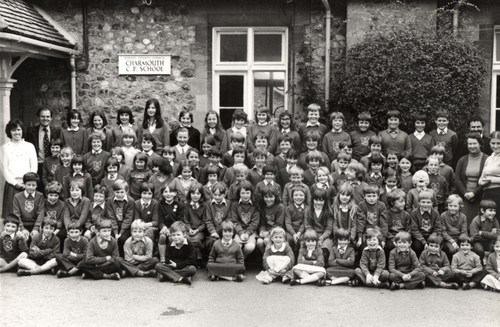
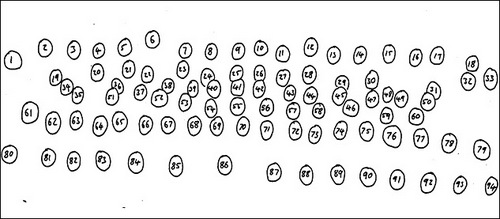
This whole school photograph was taken by Mr Mike Davis, the village chemist, on 6 th May 1983.
The school sign on the wall was designed and painted by Mr Horace Colby, who was the representative from Whitchurch who served on the School Managers when the schools were amalgamated in September 1970. The sign was then transferred to the new school and placed on the East wall above the Head Teacher's office window.
Key to the photograph below:
| Name | Year | Home | Name | Year | Home | |||
| 1 | Miss Giles | 51 | Lorraine Holmes | M.I. | Charmouth | |||
| 2 | Mr. Broadhurst | 52 | Heulwen Powell | L.I. | Wootton | |||
| 3 | Maria Norman | 4th | Charmouth | 53 | Hayley Ruffle | M.I. | Wootton | |
| 4 | Catriona Cater | 4th | Charmouth | 54 | Charlotte Cook | M.I. | Charmouth | |
| 5 | Ruth Saphorghan | 4th | Charmouth | 55 | David Young | L.I. | Charmouth | |
| 6 | Julia Eaton | 4th | Whitchurch | 56 | Tim Fowler | M.I. | Wootton | |
| 7 | Jackie Kolich | 4th | Charmouth | 57 | Michael Churchill | M.I. | Whitchurch | |
| 8 | Margaret White | 4th | Charmouth | 58 | Kirsty Penman | L.I. | Ryall | |
| 9 | Amy Tucker | 4th | Wootton | 59 | Sasha Ray | L.I. | Whitchurch | |
| 10 | Lisa Craddock | 4th | Morcombelake | 60 | Richard Legg | L.I. | Whitchurch | |
| 11 | Michelle Bowditch | 4th | Charmouth | |||||
| 12 | Mark Tarry | 4th | Charmouth | 61 | Paul Hill | 3rd | Charmouth | |
| 13 | Darren Smith | 4th | Charmouth | 62 | David Cormack | 3rd | Charmouth | |
| 14 | Richard Poulton | 4th | Charmouth | 63 | Neil Ruffle | 2nd | Wootton | |
| 15 | James Holmes | 4th | Charmouth | 64 | John Luxton | 2nd | Morcombe | |
| 16 | Daniel Saphorghan | 4th | Charmouth | 65 | Steve Minchin | 3rd | Charmouth | |
| 17 | Tony Broadhurst | 4th | Whitchurch | 66 | Anita Smith | 2nd | Whitchurch | |
| 18 | Mr. Harris | 4th | 67 | Clair Banting | 3rd | Charmouth | ||
| 4th | 68 | Jennifer White | 2nd | Charmouth | ||||
| 19 | Julia Conway | 4th | Charmouth | 69 | Catherine Poulton | 2nd | Charmouth | |
| 20 | Karen Thomas | 3rd | Charmouth | 70 | Phillipa Forsey | 3rd | Charmouth | |
| 21 | Sarah Matteson | 3rd | Charmouth | 71 | Sara Bentley | 3rd | Whitchurch | |
| 22 | Sharon Aburrow | 3rd | Charmouth | 72 | Laurence Patterson | 1st | Ryall | |
| 23 | Susan Legg | 3rd | Whitchurch | 73 | Donna Edwards | 1st | Ryall | |
| 24 | Polly Duplock | 3rd | Charmouth | 74 | Maya Ray | 1st | Whitchurch | |
| 25 | Simon Hughes | 3rd | Whitchurch | 75 | David Bentley | 1st | Whitchurch | |
| 26 | Sean Gillings | 3rd | Charmouth | 76 | Jack Duplock | 1st | Charmouth | |
| 27 | Kieron Harris | 3rd | Charmouth | 77 | Kyle Minchin | 1st | Charmouth | |
| 28 | Kieron Price | 3rd | Charmouth | 78 | Cecil Thompson | U.I. | Whitchurch | |
| 29 | Robert Hall | 4th | Charmouth | 79 | Robert Pitt | M.I. | Charmouth | |
| 30 | Oliver Larcombe | 4th | Whitchurch | |||||
| 31 | Hansford | 4th | Charmouth | 80 | Alan Luxton | U.I. | Morcombe | |
| 32 | Miss Bird | |||||||
| 33 | Mrs Varndell | |||||||
| 34 | Joanne Craddock | 2nd | Morcombelake | 81 | Simon Hill | U.I. | Charmouth | |
| 35 | Davina Hansford | M.I | Charmouth | 82 | Craig Prosser | U.I. | Charmouth | |
| 36 | Georgina Bearpark | 3rd | Charmouth | 83 | Edward Brooks | 1st | Wootton | |
| 37 | Tracy Prosser | 3rd | Charmouth | 84 | Ben Cooper | U.I. | Charmouth | |
| 38 | Helen Peach | 3rd | Charmouth | 85 | Simon Gillings | U.I. | Charmouth | |
| 39 | Mark Bulgin | 2nd | Charmouth | 86 | Caroline Bay | U.I. | Whitchurch | |
| 40 | Jonathan Butler | 3rd | Morcombelake | 87 | Charlotte Wyatt | M.I. | Charmouth | |
| 41 | James Gorfin | 3rd | Charmouth | 88 | Clare Phillips | L.I. | Charmouth | |
| 42 | Larcombe | 2nd | Whitchurch | 89 | Michelle Cook | M.I. | Ryall | |
| 43 | Kolich | 2nd | Charmouth | 90 | Simon Forsey | L.I. | Charmouth | |
| 44 | Berger | U.I | Uplyme | 91 | Martin Larcombe | L.I. | Morcombe | |
| 45 | Mark Hill | 1st | Charmouth | 92 | Paul Chapman | L.I. | Monkton W | |
| 46 | Michael White | M.I | Charmouth | 93 | James Cook | L.I. | Ryall | |
| 47 | Karen Thomas | U.I | Charmouth | 94 | Lucy Gorfin | L.I. | Charmouth | |
| 48 | Jeffrey Bulgin | 4th | Charmouth | U.I. = Upper Infant | ||||
| 49 | Laura Gorfin | 1st | Charmouth | M.I. = Middle Infant | ||||
| 50 | Emma Blake | 1st | Lyme Regis | L.I. = Lower Infant | ||||
Mr. Broadhurst Head Teacher.
|
Miss Giles Head of Infants |
1985
9 th Jan Only 50 out of 104 children present due to snow.
21 st June Sinks installed in outside toilets.
2 nd Sept County imposed charges for children travelling from villages on school transport.
4 th Oct Lyme Regis pyramid of schools formed.
18 th Nov County Councillors called to discuss transport.
29 th Nov County representative called to discuss problems arising from various parents refusal to pay for school transport.
11 th Dec Christmas production put on video for first time
1986
4th Feb In-service teacher training organised in pyramids. Bids have to be made for school based in-service.
24 th Feb Pipes frozen in main building. Not thawed out until lunchtime.
14 th April Cleaner put her foot through the floor of one of temporary classrooms.
3 rd Sept All temporary classrooms strengthened externally by putting timbers up the sides and across the tops of the classrooms.
1987
15 th Jan Only 42 children out of 135 attended. Pipes and toilets frozen.
4 th March ShortTennis Club started in Village Hall.
6 th April The girls won the West Dorset Netball League for the second year in succession.
27 th April Leaks in Infant Classroom roof repaired.
9 th May The girls won the Thorncombe Shield at the Netball Tournament held at Woodroffe School.
13 th May Position of new temporary classroom discussed.
2 nd June An exchange trip with 4th year children from a school in Exeter. Our children spent four days in Exeter and slept on the school premises.
7 th July First Annual Governors' Report to Parents, demanded by the Education Act, held in the school hall. 9 Governors and 4 parents attended.
7 th Sept First In-service Training Day under the Pay and Conditions of Service Act. New temporary classroom put on site. All other temporary buildings re-roofed and redecorated at a total cost of approximately £20,000.
5 th Oct Fire drill held. Both fire bells found to be faulty.
2 nd Nov Carpets fitted in temporary classrooms at a cost of £1013.
1988
14 th Jan Children entertained Senior Citizens at their Christmas Dinner in the W.I. Hall.
16 th Feb School Hall used for a Public Enquiry in connection with the proposed Charmouth by-pass.
29 th Feb Whole school went to Youth Club Hall to see a 33ft Ichthyosaur found on the cliff near Stonebarrow before it was taken to Bristol Museum.
5 th March The boys were runners-up in the County 6-a-side Football Tournament held at Wareham.
25 th April The boys football team were outright winners of the Kenway Cup, beating Bridport C.P. School in the final.
21 st Oct Fittings removed from school house bathroom to make a Deputy Head's Office.
31 st Oct 4" by 4" props fitted to the centre of all the temporary classrooms for safety reasons.
16 th Dec Christmas Production disrupted by influenza. 38 children absent, but the show went on!
1989
20 th Feb P.T.A. volunteers completely redecorated the Hall.
14 th March Representatives of the designers and builders of the by-pass, recently started, came to talk to the children about safety.
28 th April Fire Drill held - bells ineffective.
1 st Sept National Curriculum in English, Mathematics and Science came into force.
30 th Oct Hall floor completely sanded down to make it more suitable for indoor Physical Education.
1990 Several extra meetings held. See New School data.
1991
15 th Jan Booked by Dorset began. An extraordinary meeting of Governors held to discuss Grant Maintained Status. No decision was taken.
8 th Feb Only 54 out of 151 present due to heavy snow.
18 th Feb The school opened after half-term to find burst pipes in all temporary classrooms.
28 th March An extra Training Day given by the Government to familiarise the staff with the new Standard Assessment Tasks for 7 year olds.
1 st April School Cleaning put out to private tender. Carried out by Dorset Direct, using same personnel, but paying them for 4 less hours per week.
13 th May First Year 6 Activity Week.
14 th May First Government Tests for 7 year olds held.
26 th June Inspection of teaching styles - Favourable report.
12 th Oct Last Smiths Crisps six-a-side Football Tournament held on our field, now the new school.
25 th Oct County Architect's representative called to discuss work to be done on old school. It was due
to be redecorated, but it was decided to defer this in view of the possibility of the new school being built.
1992
7 th July First Musical Evening.
23 rd Oct Lay-by constructed inside fence parallel with Wesley Close for school transport, because Wessex Water closed the lower part of the main street. A separate pedestrian access was made across the grass to the playground.
4 th Dec Year 6 entertained the Blind Association Annual Christmas Party at the Alexandra Hotel, Lyme Regis
1993
10 th March Packing crates delivered.
11 th March Library reclassified in Dewey system.
15 th March Whole staff had first visit to the new school!
2 nd April Last full day for children in old building. The children watched a video film in the afternoon
with ice-creams during the interval. The school closed at 3.30 p.m. after 123 memorable years in the beautiful old building.
3 rd April The windows and doors of the old building were all boarded up. A very sad sight.

The old school building has been converted into four habitable units for letting, first occupied Easter 1995. With that begins a whole new story.
Some Interesting Additional Reasons for Closure taken from the School Log Book.
Closures were for one day unless otherwise stated.
Closures were for one day unless otherwise stated.
1863
6 th April The usual Holiday postponed until Whitsuntide.
14 th August Harvest ‘Holy-day'.
29 th Sept C.C.C. playing a match.
17 th Nov School inspected by Rev. R S Hutchings. Children behaved nicely and are given a
‘holy-day'.
1864
26 th Oct Head's wife had scarlet fever - 6 weeks.
26 th Dec No Christmas vacation this year, only half a day.
1865
14 th June The Club Anniversary.
14 th Sept Regatta.
1866
11 th June The burial of the Head Teacher's son, John Henry.
1 st Oct Attendance very thin – Revel at Whitchurch.
1867
4 th July Very wet.
10 th July Charmouth Fair - half day.
15 th August Regatta at Lyme.
1868
24 th Dec ‘Broke up today for a fortnight's holiday, because tomorrow is Christmas Day.'
1869
29 th July Volunteer encampment at Burton Bradstock.
21 st Sept Measles was so bad in the Parish - three days
1870
2 nd June Club Day
5 th August 1 week for the Harvest at the request of the Rector.
3 rd Oct Circus at Lyme Regis.
1871
4 th April Circus at Lyme Regis.
11 th Sept Penny concert in the village.
1872
19 th Feb Examination by H.M.I. - half day.
15 th Nov Visit of the Diocesan Inspector - half day.
1873
28 th Feb Deep snow.
8 th August Lyme Regatta - half day.
1874
12 th June Anniversary of the Charmouth Branch of the Manchester Sick and Burial Association.
10 th July Charmouth Fair - half day.
1875
9 th June Charmouth Club Anniversary. ‘It being useless to attempt to keep school on the Club Day or the day after.' - 2 days
27 th Oct Master absent.
1876
3 rd Feb Polling Place.
29 th Sept Harvest Festival at Wootton - half day.
6 th Oct Measles epidemic - 1 week.
16 th Nov Concert in aid of Charmouth Village Hospital.
1877
26 th July Scarlet Fever epidemic - 3 weeks.
5 th Oct Wild Beasts Show at Lyme.
1878
6 th Dec Herring fishery.
1880
1 st Oct To see a Menagerie - half day.
1883
5 th Oct Measles epidemic - 3 weeks.
1884
10 th Oct Scarlet Fever - 3 weeks.
1886
26 th March Confirmation Service - half day.
1887
22 nd Dec Mistress attending Certificate Examination - 2 weeks for Infants.
1888
18 th Feb New Cemetery consecrated by the Bishop of the Diocese.
11 th March Whitewashing the School walls - 1 week.
17 th June Queen's Jubilee Festivities - 1 week.
23 rd Dec Scarlet Fever epidemic - 1 week.
1889
11 th Jan Measles epidemic - 2 weeks.
1890
28 th Feb Influenza epidemic - 1 week.
1892
12 th July General Election.
1893
17 th Feb School walls cleaned and coloured - 1 week
6 th July Royal Wedding – Prince George, Duke of York (later George V) to Princess Mary of Teck
1 st Dec Whooping cough epidemic – 6 weeks
1894
14 th Dec Measles epidemic - 2 weeks.
1895
14 th May West Dorset Election.
26 th August School's Annual Festival
14 th Feb Construction of paths around the school - 1 week.
9 th Sept Concert in aid of School Drum and Fife Band.
1897
18 th June 60th Year of Queen Victoria's reign - 1 week.
17 th Sept District Council Election.
23 rd Nov Government Enquiry re Water Supply.
1898
2 nd May Confirmation - half day.
1899
24 th May Queen Victoria's 80th Birthday.
1900
24 th May Relief of Mafeking - medals presented to children.
1901
5 th July Funeral of a little boy at the school - half day for children to attend.
30 th August Flower Show Day.
4 th Oct Teachers and some children had their Annual Choir Outing to Weymouth.
1902
28 th Feb Measles - 5 weeks.
2 nd June Ratification of peace in South Africa.
17 th Oct Choir outing.
1903
17 th July Annual Choir Festival.
1904
24 th May Empire Day. Children given an address on the British Empire, sang the National Anthem and had a half day.
9 th June Teachers went to Lyme Regis Choir Festival - half day.
29 th August Alterations in premises - 1 week added to Summer Holiday.
1905
12 th June Charmouth Club festival.
15 th Dec Scarlet Fever - 5 weeks.
1906
15 th Feb Scarlet Fever - further 5 weeks ordered by Medical Authority.
6 th July Scarlet Fever - further 6 weeks under Medical Authority.
1908
13 th Nov School Room used for a Local Government Board Inquiry respecting Loan for Parish.
1909
12 th Feb Meeting of School Managers.
1910
20 th May Funeral of King Edward VII
3 rd June Charmouth and neighbourhood Club Festivals - 2 days.
1911
16 th June Coronation Holiday - 1 week.
1913
16 th May Measles - 5 weeks.
1915
12 th Nov Scarlet Fever - 8 weeks by order of the Medical Officer.
1918
24 th June Whooping Cough - 2 weeks.
19 th Sept Picking blackberries for Government. 109 lbs.
11 th Nov Peace declared with Germany. Children lined up in playground at 11 o'clock, sang "God Save the King" and had the rest of the day off.
1919
3 rd March Inflenza in the village - 2 weeks.
7 th April Influenza - 3 weeks.
21 st July Children's Sports to celebrate Signing of Peace of the Great War. Held then because school had been closed on original date.
1 st Sept ‘Colouring of the walls' not completed - 1 week added to Summer Holiday.
1922
20 th Feb Influenza and Whooping Cough - 4 weeks.
14 th July Sanger's Circus in Lyme Regis - half day.
1923
17 th April Singing Competition at Beaminster.
15 th May Choral Festival at Weymouth.
1924
5 th March Influenza - 1 week.
17 th July Reward for good attendance and to enable the children to go on the choir outing.
1925
11 th Feb To enable Teachers to attend an Educational Meeting in Dorchester.
7 th July Scarlet Fever - 3 weeks.
1926
17 th June Village Outing.
1927
20 th July Suspected case of Scarlet Fever. Chairman of Managers wired the County Medical Officer who replied by telegram to close the school immediately. School only remained closed for one week as many of the reports relating to cases were found to be false.
4 th Nov Ceiling fell in.
1928
2 nd April School used as a Polling Station.
1929
30 th May Polling Day
1932
24 th Feb County Medical Officer instructed that the Infants be excluded because of Measles.
1933
21 st June Police Sports and Lambert's Castle Fair.
1934
7 th June Elder children visited Oxford.
29 th Nov Wedding of Prince George, Duke of Kent and Princess Marina of Greece and Denmark.
1935
6 th May King George V's Silver Jubilee - 2 days.
27 th June Senior pupils visited Hampton Court.
6 th Nov Wedding of Prince Henry, Duke of Gloucester to Lady Alice Montagu-Douglas-Scott.
1936
18 th June Rounders Team took part in a Physical Training Demonstration at Bridport - half day.
7 th Sept Whooping Cough - 4 weeks.
1937
9 th April Suspected leakage in the sewer outside the school - 10 days by order of District Medical Officer.
11 th May Coronation of King George VI - 3 days.
1938
21 st March Chicken Pox epidemic - Infants excluded.
23 rd June Guides and Brownies attended a Rally at Canford.
8 th July 22 children conducted over Fry's Cocoa Factory at Somerdale.
17 th Oct Staff A.R.P. training.
1940
7 th Feb To allow children to see the King as he passed by car through Charmouth.
1941
26 th Sept Second half of the Summer Holiday.
1943
29 th March Potato planting.
1944
15 th Sept Potato picking.
1945
29 th Jan Icy roads and frozen taps.
8 th May V.E. Day - 2 days holiday.
1946
1 st April Charmouth Parish Council elections.
1947
30 th Jan Very snowy morning. Children from Monkton Wyld and Morcombelake unable to attend.
20 th Nov Wedding of Princess Elizabeth to Lieutenant Phillip Mountbatten.
1948
26 th April Silver Wedding of the King and Queen.
1949
19 th May Children competed in West Dorset Athletic Sports - half day.
11 th Oct Teachers attended a Conference on the Agreed Syllabus of Religious Instruction.
1950
23 rd Feb General Election.
4 th July Occasional holiday - 3 days.
15 th Dec Heavy fall of snow with deep drifts.
1951
25 th April Head Teacher attended the Diocesan Syllabus Conference.
1 st June Head Teacher took her class to Bath & West Show.
26 th Sept Head Teachers' Conference.
25 th Oct General Election.
1953
2 nd June Coronation of Queen Elizabeth II - 3 days.
24 th June Children taking part in Bridport Royal Charter Pageant 1253-1953.
1954
3 rd Feb Lack of water.
26 th March Teacher attending course in Bridport.
7 th April Teacher's child developed Scarlet Fever, so teacher had to stay away and Head Teacher felt too unwell to carry on alone.
1955
26 th May General Election.
1956
3 rd Feb Frozen tanks. Stoves lit at 6.00 a.m. and room temperature at 9.00 a.m. was 32 degrees.
29 th June Class I visited Cheddar Caves and Wells Cathedral Clock.
2 nd Oct Teachers attended one day Conference on the Agreed Syllabus of Religious Instruction.
1958
18 th June Head Teachers' Conference.
1959
7 th Oct General Election.
1960
6 th May Wedding of Princess Margaret to Anthony Armstrong-Jones.
8 th July Head Teachers' Conference.
1961
18 th Oct Cuisenaire Conference.
1963
9 th Jan Severe weather conditions - 1 week.
1964
3 rd July Upper Juniors went to London accompanied by the teaching staff and kitchen staff.
15 th Oct General Election.
1965
18 th June Upper Juniors went to Bristol Zoo.
1966
10 th May Rural District Council Elections.
10 th June Juniors visited Plymouth.
1967
16 th June Juniors visited the River Dart and Paignton Zoo.
1968
7 th May R.D.C. Elections.
21 st June Older children went to Southampton Docks, a small zoo and Poole Park.
1969
6 th May R.D.C. Elections.
16 th May Upper Juniors and top group of Class 2 were taken to Longleat.
1970
5 th June Upper Juniors, teaching and kitchen staff went to the Bath & West Show at Shepton Mallet.
1971
18 th June 3rd & 4th Year Juniors visited Poole Pottery, quay and had an hour's boat cruise around the harbour.
1972
16 th Feb- Power Strikes - Classes stayed away for 2 days each week on a rota system.
1 st March
12 th May Junior classes (61 children) went on trips to the River Dart Railway and Paignton Zoo.
20 th Nov The Silver Wedding of the Queen and Prince Philip.
1973
11 th May 2nd, 3rd and 4th year Juniors (57 children) went to the Exeter Maritime Museum and Exmouth Aquarium
14 th Nov Princess Anne's Wedding to Captain Mark Phillips.
1974
28 th Feb General Election.
1978
20 th Feb All schools in Dorset - one week after half-term because of severe weather conditions.
1 st May First Labour Day Bank Holiday.
1985
8 th Jan Heavy snowfall - half day.
1987
15 th Jan Pipes and toilets frozen.
Comparison of Costs of Running the School between 1893 and 1993.
1893 |
1993 |
|
£.s.d. |
£ p |
|
| Teachers' Pay | £159 | £142,445.00 |
| Monitors | £3-14-6 | |
| Secretaries & Ancillaries | £11,686.00 | |
| Mid Day Supervision | £4,727.00 | |
| Books, Apparatus & Stationery | £5-9-8d | £6,339.00 |
| Fuel, Light & Cleaning | £11-18-0d | £6,506.00 |
| Repairs | £1-19-6d | £329.00 |
| Telephones | £596.00 | |
| Rent, Rates & Taxes | £5-15-4d | £837.00 |
| Total: | £187-17-0d | £173,465.00 |
| Number of Pupils | 113 |
143 |
| Cost per Pupil | £1-13-3d | £1,213.00 |
| Days open in Year | 231 |
190 |
In 1893 the Head Teacher earned three times as much as the Assistant Teacher.
The repairs amount for 1993 was very low because only essential maintenance was carried out prior to moving to the new school.
N U M B E R S O N R O L L
In the early days the N.O.R. was very rarely mentioned. The first recorded was 126 in February 1865.
The school was originally an all age school and only became a Primary School on 30 th August 1949 when 11 older children and one teacher transferred to Lyme Regis Senior School.
In the 1880's and 1890's the numbers fluctuated between 90 and 115, and reached 134 in the early 1900's.
By the end of the First World War the numbers fell to between 70 and 80.
In July 1939 the number was 69; but with the onset of the Second World War, in September 1939 had risen to 124 with the addition of evacuees from St Peter's C. of E. School, Paddington, London.
By 9 th January 1940 the numbers had fallen again to 99. Official and unofficial evacuees were admitted almost daily. Some returned home and were later readmitted depending on the conduct of the war.
Miss Meade, the Head Teacher at the time, kept a very regular record of the number on roll, which at its highest during the war reached 130. That averages 43 per classroom! From August 1942 it fluctuated between 70 and 85.
On 16 th September 1959 the N.O.R. fell to an all-time low of 47; but increased slowly to 62 in December 1963, 91 on 6 th September 1970, and 136 on 7 th September 1970 with the closure of Whitchurch Canonicorum and Wootton Fitzpaine Schools.
During the early 1970's the numbers remained in the 130's and 140's rising to a maximum in June 1978 of 173. This is the highest number recorded in the old building.
The numbers fell dramatically in the early 1980's to as low as 88 in September 1983, rising again to between 130 and 155.
143 children made the move into the new building and then rose to 186 in January 1996. (See figures on the next page)
In January each year every school has to complete a Pupil Count. This now takes place on the third Thursday after the start of the Spring Term, but previously it took place on a date, in January as specified each year by the government.
Data from this pupil count is used nationally by the Department of Education for funding, planning and statistical purposes and this is mirrored by the local Authority. January numbers are used in forecasting, place Planning and for school funding.
Prior to 2001 data was collected at school level. Schools completed a form called Form 7 listing how many pupils were in the school at each age group. From 2002 onwards the paper Form 7 return was replaced by an electronic return called the Pupil Level Annual School Census, but has subsequently evolved into a more extensive return called the School Census. The Local Authority receives details of pupils from the electronic database of each school and this is aggregated to provide the Number on Roll Summary, which it uses to calculate allowances to schools.
The Local Authority allocates a sum of money per pupil. At primary school there is a sum for infant age children, Years R, 1 & 2, and a slightly larger sum for Junior age children, Years 3 to 6. These sums, multiplied by the number on roll forecast for the September on the Form 7, made up the sum the school had to spend for the year.
Slight adjustments were made if the numbers in the September proved to be different from the projected figures.
Secondary Schools receive a considerably larger sum per pupil and the amount allocated by central government to each Local authority varies from authority to authority enormously, with Dorset being near the bottom of the list.
Listed below are the Form 7 figures for Charmouth School from 1973 to 1997.
Year. N.O.R. Year. N.O.R. Year. N.O.R.
1973 139 1974 128 1975 130
1976 144 1977 143 1978 148
1979 148 1980 129 1981 114
1982 103 1983 94 1984 91
1985 104 1986 113 1987 135
1988 140 1989 145 1990 153
1991 151 1992 150 1993 144
1994 177 1995 180 1996 186
1997 182
From the introduction of children from Whitchurch and Wootton until 1980 the numbers remained reasonably static, but then fell dramatically until 1987 when numbers increased due partly to the fact that, under the government's policy of parental choice, children came to the school from Lyme Regis Infant and Junior Schools and Symondsbury Primary School.
In the 1970s the Form 7 numbers were used by the Education Department at County Hall to decide the allocation of staffing for the coming school year, September to August. Usually that decision was not made until the end of the Spring Term making class organisation difficult.
From 1982, when Charmouth became one of the nine schools to pilot the new method of funding whereby the school had its own bank account, decisions about how the money should be spent were made by the school. This was the forerunner of Local Management of Schools.
Whilst LMS made things much easier because staffing could be decided earlier, there wasn't so much room to manoeuvre as the teachers' salaries were such a high proportion of the overall budget.
TEACHERS and OTHER SCHOOL STAFF
To become a teacher in the eighteen hundreds, according to references in the Log Book, it was necessary to serve as a Pupil Teacher for 5 years and then pass an examination. When Thomas Bunstone was Head Teacher, his son was recorded as being at the end of his 4 th year in March 1866.
As well as pupil teachers the school also employed ‘Monitors'. These were senior pupils, possibly thirteen or fourteen, paid to carry out duties similar to ancillaries today, except that monitors were given class responsibilities as on 31 st October 1867 when the monitor, and his class were kept in for ‘noise', and again on 16 th September 1868 the monitor had ‘to write 200 words for letting his class play'.
There were two occasions mentioned when the teacher and the class were kept in: first for poor standards and second because the teacher and the class were ‘lazy'.
In 1886 Miss Coombs, the Assistant Mistress, was dismissed to save money, nothing changes! In May 1888 Mrs Jones, the Head Teacher's wife, was appointed Assistant Mistress at £10 per annum. Her salary was to be back dated as she had been doing the job for several months. Mr Jones stated that £7 would be sufficient to cover the employment of a maid to do the housework, so Mrs Jones was paid £7 per annum!
There are few records of the numbers in classes in the early days, although there are several occasions when classes had to be put together when a member of staff was ill, and sometimes the Head Teachers mentioned that they had to take the whole school, either on their own or with the help of a Monitor.
From the school photos in 1903 there appear to have been 2 teachers to 73 children, assisted by one or two monitors monitor. The top photo on page 8 shows a senior girl in a different uniform, called Laura Hann, who was probably a monitor. The school is split into four groups for those photos, but this may have been more to do with the limits of photography than class sizes as there were only three separate teaching areas at that time. Mr Jones states in June 1903 that he was finding it difficult to teach standards 3 to 7 on his own.
However in the 1922 photos on page 14 the children appear to be in class groups with their teacher, with the Head Teacher, Mrs Stewart, having the largest class of 30.
The school employed an uncertificated teacher in the 1920s although she had had to pass an examination to achieve that status. In April 1937 the Head Teacher had 38 in her class, with the rest of the 77 children split between two other teachers.
During the war the teachers took their holidays in a rota system while the children remained in school. Reference is made, in March 1943, of the Head making an annual report on the teachers whilst the Managers commented on the Head. The school also began taking student teachers from St Katherine's, Tottenham, London and Weymouth teacher Training Colleges in 1948.
In May 1957 there was only Miss Meade, the Head Teacher, and one other teacher, Mr Woods. He was one of 63 Dorset teachers transferred to the Midlands because of staff shortages in that area of the country. After a deputation was sent to Dorchester a supply teacher was sent, for half days, leaving the Head to cope with the whole school on her own at all other times. No mention is made of the number of children at that time. By December 1962 there were 62 children and three teachers and in February 1971 the class sizes were 36, 36, 40 and 28 following the closure of the schools at Whitchurch Canonicorum and Wootton Fitzpaine.
Until October 1968, when a secretary was appointed for two hours a week, there was no administrative help. This was increased to 5 ½ hours in September 1969.
No reference is made in the Log Books as to the Caretaker/cleaner's hours until February 1980 when it was 26 hours a week, reduced to 21 hours in July 1983. School cleaning was put out to private tender on 1 st April 1991. The contract was awarded to Dorset Direct. They used the same personnel, but payed them for 4 hours less, i.e. 17 hours a week. That was only increased to 23 hours a week in the new school with nearly twice the area to clean.
In March 1980 the Dinner Ladies hours were cut from 10 to 7 ¾. When Dorset ceased to provide school lunches in all their primary schools in September 1980 the number of Dinner Ladies was cut from six to three. The dinner ladies hours were further reduced to 5 ½ in the new building.
Due to falling numbers in July 1981 a teacher had to be redeployed to Damers Road First School in Dorchester. When a vacancy for a teacher came up the following year a teacher was redeployed from Winton School in Bournemouth rather than the school being allowed to make its own appointment.
In the late 1970s and early 1980s the staff would hold a meeting voluntarily on the day before each term began to discuss plans for the term's events, and then spend time in their classrooms. From September 1987 In-service training became part of Teachers' Pay and Conditions of Service making the days' attendance before each term compulsory. This took away much good will and seemed to change the atmosphere of the days.
The ‘Training Days' became known as ‘Baker Days' after Kenneth Baker, who was Minister of State for Education who introduced them. Five such days each year were set aside for In-service Training, the timing and content left largely to the discretion of the school.
Monitors, Welfare Assistants, Ancillaries were all names for those people who assisted the teacher in the classroom. In the 1970s there was one ancillary for a few hours a week based in the reception classroom. Her duties were to help with the preparation of lessons, clearing up afterwards, assisting the children as they changed for PE and hearing children read, all under the supervision of the teacher.
Occasionally, after a recommendation by the Education Psychologist, a child with special educational needs was allocated a welfare assistant, but that would be for a specific child rather than a group.
A second ancillary was appointed in the late 1980s and as she was a fully qualified teacher she could legitimately take charge of a class in an emergency. As the use of audio visual equipment increased she also took charge of radio and TV recordings as well as assisting generally in classrooms. The second ancillary spent time with some of the Junior classes where extra help was needed.
This picture, taken under the porch leading to the school house, shows some of the staff members just before they moved into the new school. From the left: Mrs Jacki Bollen, Assistant Teacher; Mr Mark Stratta, Deputy Head; Mr John Broadhurst, Head Teacher; Mrs Avril Smith, Caretaker; Mrs Judith Mallabone, Head of Infants; Mrs Alison Bloxham, Secretary & Dinner Lady; Mr Paul Curtis, Assistant Teacher; Mrs Mandy Wiscombe, Assistant Teacher. Not in the photo were Mrs Vivien Smith, Ancillary; Mrs Myra Sealy, Assistant Teacher; Miss Sue Johns, Ancillary; Mrs Rose Wheeler & Mrs Gill Poulton, Dinner Ladies.
At that time Mrs Bollen and Mrs Sealy shared Class 3, 2 ½ days a week each and Mrs Wiscombe and Mr Broadhurst shared the top group, Class 5, Mr Broadhurst taking the mornings and Mrs Wiscombe the afternoons. Mrs Mallabone took Class 1, Reception, Mr Stratta, Class 2 and Mr Curtis, Class 4.

SCHOOL BOARDS, MANAGERS and GOVERNORS
At first Charmouth was probably a church school, but from 1878 it was governed by an elected Board, and referred to as a Board School. The Managers took over their role, their first meeting was mentioned in 1909, and the first Chairman appears to have been Mr Pavey, from a well known Charmouth family. Mr Don Dampier was the next Chairman, followed by Mr Norman Sturgess, Mr Tony Stevens and Mrs Molly McAuley, who was Chairman during the transfer to the new school. She handed over to Mr Howard Wickes.
Managers became Governors on 19 th November 1980. The Governors were made up of representatives from the County, three members, the Parish Council, one member, parents, the number depending on the size of the school and elected by a secret ballot, an elected member of the staff and the Head Teacher.
The first Parish Council representative, elected by the Council, was Mr Don Dampier, followed by Mr Stan Scivers, who was also Clerk to the Council and he was succeeded by Mrs Margaret Bettes, who stayed on as a County Council representative when she left the Parish Council. Parent Governors were first elected under the Education Act of 1980. The County has a pool of suitable people who have indicated that they would be willing to act as a Governor. These people are then allocated to a school when a vacancy appears.
The Governors were very well represented at school events, particularly the Leavers' Concerts and the Christmas Productions at which one of them always gave a vote of thanks to the children and staff.
School Photographer
The school used the national school photography firm H. Tempest to come into school annually to take individual and group photographs according to the wishes of parents. Parents were also given the opportunity to bring in pre-school children if they wished to have them included in a family group. Class photos were taken every other year as it was felt that it would prove too expensive for parents to have them taken annually.
In the late 1980s whole school photos were taken at the same time as the individual and family photos, but these were later done by a team specialising in large groups.
SIGNIFICANT EVENTS LEADING UP TO THE NEW SCHOOL
1946
24 th Sept Mr Pavey, Chairman of the Managers, informed the meeting of a proposed scheme to build a new school in Charmouth. No details were given.
1947
24 th Feb The Correspondent to the Managers presented the plan for the new school which he had received from the Education Office.
20 th May Meeting held to discuss proposed new school. Representatives from the County Council, R.D.C. and Parish Council were invited. No manager was invited to attend. Mr Dampier reported that it was being recommended to convert present building.
1952
22 nd July Charmouth Development Plan discussed – re-planning of school.
1964
28 th March Report by H.M.I. following inspection - school needed remodelling to allow P.E. in Winter.
1967
11 th July Meeting to discuss proposed extension to the school - two floored building considered.
1968
15 th May A letter from County stated that, due to financial situation, there was no chance of any improvement to school.
1972
3 rd May A letter was received from County to confirm that a new Primary School had been included by the Secretary of State in the 1972/73 preliminary list for the School Major Building Programme.
12 th Dec Letter from County stating that they had been notified by the Department of Education and Science that a replacement school for Charmouth had been included in the 1973/74 Design List at a gross cost of £78,428.
1974
10 th Jan Letter from County informing the Head Teacher that all primary replacement projects in the 1973/74 and 1974/75 Starts Programme had been deferred until further notice.
1975 The Charmouth Draft Village Plan showed the site "reserved for a new County Primary School, to replace the small and unsatisfactory accommodation with vehicular access off Lower Sea Lane. There was to be a footway provided in a programme of road improvement schemes for 1981/82.It also stated that the old building should be maintained as an attractive feature, converted to dwellings or put to community use. The remainder of the site was to accommodate about 12 houses."
1978
10 th Oct Discussions about turning old coal store into work areas. Decision deferred for 6 months, by which time the County may have a clearer picture about the date of the proposed new school.
1988
14 th Nov Governors' Committee set up to investigate the replacement of the outside toilet block.
18 th Nov Governors' Committee met to discuss suggested plans for an extension toilet block to be added to the T.V. Room. This was to be the 1st stage in a three phase development to improve the existing premises.
25 th Nov Governors' Committee met to see final plans to be submitted to County for a new toilet block and eventual redevelopment of the school.
1989
24 th Feb Governors' Committee met to discuss redevelopment plans prior to a meeting with County Officials. This was 42 years to the day from when plans for a new school were first presented to the Managers.
28 th Feb Meeting held to show plans and discuss the redevelopment, attended by the Chairman of the Education Committee, County Councillors, County Officers and all Governors. It was agreed that a feasibility study should be carried out by the County Architect.
3 rd Nov A meeting was held with representatives of Education Planning and Development to discuss proposed redevelopment plan. The principle of selling existing land, to pay for redevelopment, established.
13thDec The Governors' Committee met representatives of Education P.and D. to discuss the completed feasibility study. The project was viable and County decided to apply immediately for planning permission.
1990
8 th Jan Full Governors' Meeting discussed feasibility study
11 th Jan Governors' Committee discussed further progress of redevelopment plan and submitted formal recommendations to County.
22 nd Jan Mrs Cotterill, Chairman of the West Dorset Planning Committee called to discuss the planning application for the land on Double Common which, if sold, would provide the money for redevelopment
23 rd Jan Mr Terrett, County Councillor, called to discuss the planning application.
30 th Jan A full Governors' Meeting was held to discuss the choice between the redevelopment of the old site and an entirely new building on the playing field.
1 st Feb Staff Meeting held to discuss redevelopment. Staff decided unanimously in favour of a new building as there was insufficient information about what would be done to the old building. The County had said that what was done depended on the money available.
2 nd Feb A representative from Education P.& D. met with the Governors' Planning Committee to discuss the various options. He was unable to give definite details of what would be gained by redeveloping the existing site.
5 th Feb A further Staff Meeting, at the request of the Chairman of Governors, was held to acquaint staff with the information provided at the meeting of 2nd February. The Staff decided that there was nothing to make them alter their original decision.
6 th Feb Full Governors' Meeting to discuss points put to Sub Committee. After lengthy discussion it was resolved to write to the County telling them that the Governors and Staff had unanimously decided to ask for a new school rather than redeveloping the existing site.
6 th April Sir James Spicer M.P. called to discuss the progress made on the school's redevelopment.
5 th Nov Sir James Spicer, Mrs Seaton, Chairman of the Education Committee and officials from the County attended a meeting to discuss the progress of the new school. The County Officials tried to assure the Governors that they were doing everything to make the project possible. The Governors did not share their optimism. Sir James asked to be kept informed.
1991
25 th Jan Governors' Planning Committee met to discuss a response to the County's letter indicating that there was likely to be still further delay in the new school development. The meeting was attended by the local County Councillor.
5 th March Mr Robson, Education P. & D., who had taken over the new school project, came to discuss the Governors' requirements for the planning of the new school.
21 st March Governors' Planning Committee met to discuss the draft for the Project Architect for the new school
25 th March A meeting was held to discuss the re-routing of the public right of way from the North side of the new school site to the South side. Parish and County Councillors and Governors attended.
14 th May Governors' Planning Committee had their first meeting with Mr Stephen Forsythe, the Architect appointed for the new school.
3 rd June Governors' Planning Committee had another meeting with the Architects who submitted detailed plans of the proposed new school.
11 th June Staff Meeting held to discuss new school plans.
12 th June A meeting of Governors and Staff was held to formulate a response to the plans presented by the Architect.
18 th June Governors and Staff met Architects to discuss response to the plans before they were submitted for planning permission.
23 rd July Governors and Staff went by minibus to see some of the schools in Hampshire which had been designed by the Architects responsible for the new school.
28 th August A site meeting was held on the Lower Sea Lane Sports Field to discuss the access/exit point for the new school. County and Parish Councillors and Governors attended. It was decided to stick to the County's suggestions.
10 th Sept Governors' Planning Committee met to discuss the developments that had occurred during the holiday.
26 th Sept A further site meeting was held on the Sports Field at which County representatives met the Managing Director of I.M. Properties who were developing Hammonds Mead, to discuss the access/exit to the new school. I.M. Properties wanted both the entrance and exit to be onto Lower Sea Lane instead of using the Hammonds Mead access road. No firm decision was reached.
16 th Oct The Landscape Architect showed his plans for the grounds around the new school. Much consideration was given to plants that would withstand salt air and strong winds.
19 th Nov The footpath leading through the school playing field was blocked off and re-routed through Hammonds Mead in readiness for the building of the new school.
These elevation plans, and those overleaf, were drawn up by Mrs Elizabeth Fortescue, a Parent Governor, as part of the three phase development plan of the old building, when serious consideration was being given to the possibility of redeveloping the old site.
The plans were presented to the County following a Meeting of the Governors on 25 th November 1988. They show the layout of the school at the time of closure.
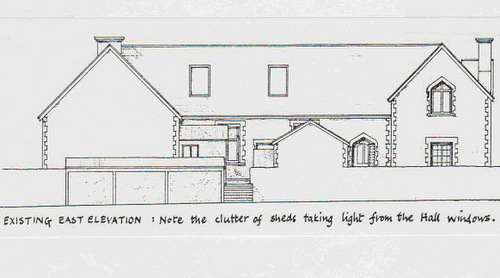
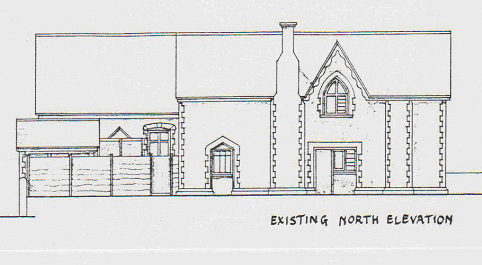

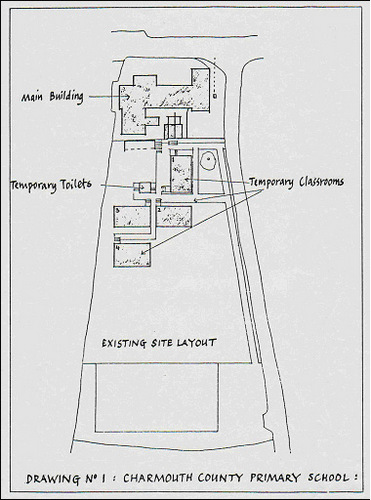
1992
13 th April A pre-contract meeting was held in Dorchester. Knapp Construction of Exeter was to be the main contractor, and was to commence on 27th April, with a completion date of 19th March 1993, at a cost of £758,892.
27 th April As promised, a J.C.B. moved onto the new school site.
30 th April A furniture and Fittings Plan for new school was discussed.
12 th May A Turf Cutting Ceremony was carried out by Mrs Pamela Seaton, Chairman of the Education Committee watched by the whole school, Governors and invited guests. Refreshments were provided in school, with a special cake to mark the occasion. Alterations to Furniture and Fittings Plan discussed.
More Details about the Old School Buildings.
The building, below, was not the first on this site. The Ordnance Survey map of 1841 shows the school in this position. It is referred to as a National School in church registers, but in the early days the school was regularly inspected by the Rector and his wife suggesting that it might have originally been a church school. The first building was two storey with the Head teacher living on the ground floor with the schoolroom above. Mr W H Howard, H.M.I. stated in 1866 that the school building was becoming totally inadequate. They moved out of that building on 25 th June 1869 and moved into part of the Lodge at the end of Lower Sea Lane. The foundation stone for the new school was laid on 26 th August 1869 by Mrs Breton, the Rector's wife. All the shops in the village closed for the day to celebrate. They moved into the new building, below, on June 27 th 1870. It did not then have the extension that later was used for the girls cloakroom and staffroom. There are no old photos of the back of the school, but the Log Book states that an additional classroom was added in 1881 at a cost of £350. This enabled the school to take 140 children.
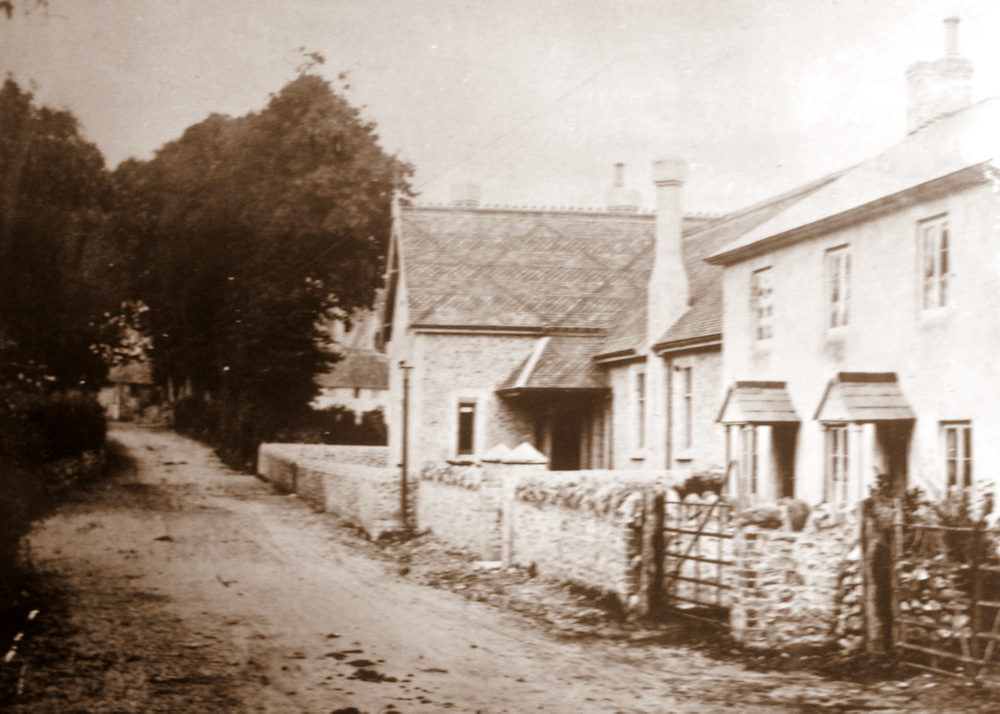
On 31 st January 1892 the H.M.I.'s report states that ‘a porch was required for girls to hang their bonnets.' The subsequent boys' and girls' cloakrooms (below) were completed on 24 th October 1904. Washbasins were not fitted into these cloakrooms until January 1950. The chimney in the centre of the school was taken down in September 1968.
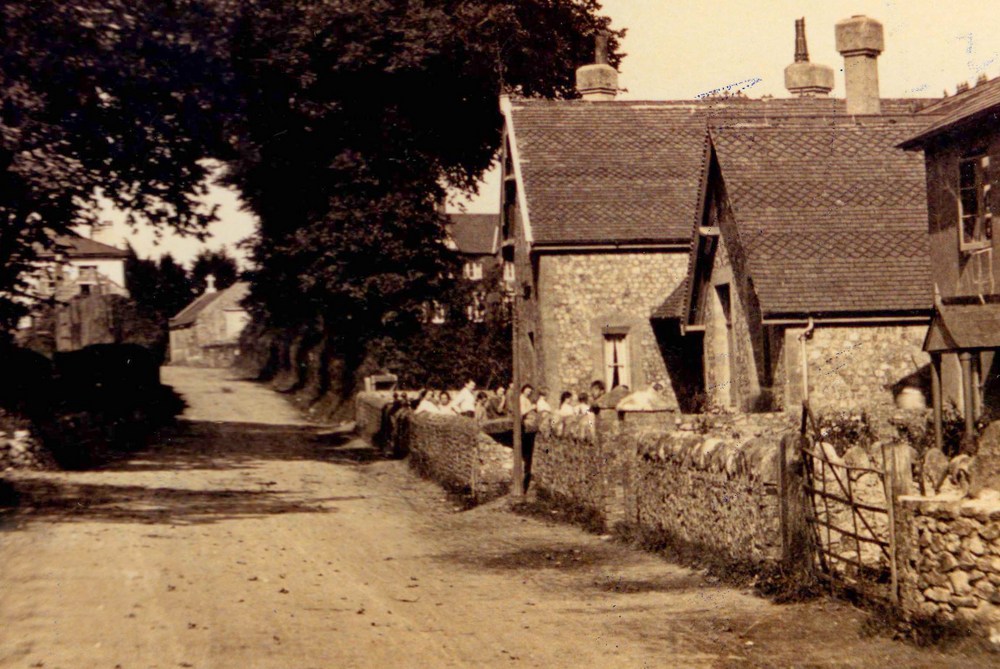
This picture also shows the cross on the building at the end of Lower Sea Lane which is now the chemist's. The playground was then at the front of the building and it is just possible to make out children in the lower photograph. Both pictures also show an entrance in a different position to the one used when the school closed. (See next picture.)


The large area in the middle of the main building, which measured 950 square feet, was originally split into two classrooms and therefore PE could only take place outside. Indoor PE was made particularly difficult after a glass partition was erected in October 1925. Even as late as July 1963 the H.M.I.s report states that the large room cannot be used for PE partly because of the immobility of the screen, which can only be moved by the caretaker, and partly because the locker desks were too heavy to move and couldn't be stacked. The desks were presumably the dual ones with cast iron frames.
From January 1964 the Youth Club Hall was used for 1 hour a day for PE and dancing. Later, with the introduction of the additional classroom and the temporary buildings in 1970, the hall, as it became, was used for many activities including PE, school assemblies, lunches, Under 5' Group and many others.
In March 1978 a climbing frame was installed in the hall and PE mats and other gymnastic equipment were stored in a wooden shed just outside the North East door. The climbing frame was transferred to the new school.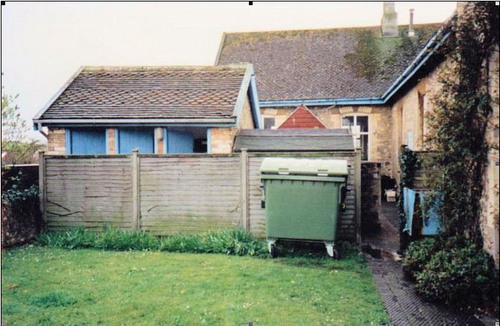
This photo shows the roof of the PE equipment shed between the main building and the girls' outside toilets. On 1 st February 1983 when a new fence was being erected between the school house garden and the girls' toilet a huge hole was discovered under the path leading to the toilets caused, over the years, by faulty plumbing. Two cubic metres of concrete was needed to fill the hole. It was fortunate that the hole was discovered before the path collapsed.
The photo was taken from the school house garden. This picture also shows the classroom that was added at the rear of the main building in 1881 following an H.M.I. Report of 30 th April 1880 that ‘another classroom and lights in the roof were much needed'. The sky lights weren't fitted until 4 th September 1908.
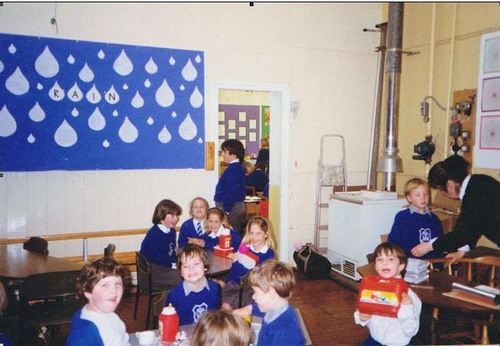
The School Meals service started in November 1943. A mobile canteen brought hot meals from the Bridport Centre until March 1953 when they came from Lyme Regis. These were eaten in the classrooms. From September 1946, when 50 children were taking lunches, until November 1959 school lunches were taken in Church Hall Club Room, opposite the school, but numbers fell so low there were no longer enough to warrant hiring the Hall. From this time until May 1970, when the children moved into temporary classrooms, meals were taken in the classrooms.
In April 1980 the price of school dinners was increased to 45p causing many children to bring a packed lunch. From September 1980 school lunches ceased to be provided in any Dorset Primary School.
The central heating boiler in the corner, originally solid fuel, was installed in June 1960 and updated in January 1973. It was converted to gas in September 1977. Prior to this the school was heated by solid fuel stoves which must have been very labour intensive because in May 1947 the cleaner resigned because of heavy work connected to the stoves. It was suggested then that they should be converted to gas, but in July 1949 new stoves were fitted because gas was deemed too expensive at £200.
The display boarding on the wall, to show off the children's work, was paid for by the PTA and erected by parents and staff in July 1977, and in September shelving was installed on the North wall of the hall for a reference library. In March 1993 the Library was reclassified in the Dewey system by Mrs Wiscombe.
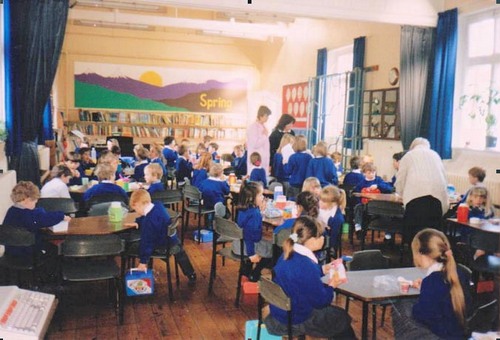
The lunches were held in two sittings, the younger children first. The tables used for the lunches had to be stacked along the sides of the hall. Dinner ladies put out the tables before lunch, assisted the children during their meal and cleared away afterwards. They also supervised the children on the playground during the lunch hour. A member of the teaching staff was also on duty while the children were eating their lunches.
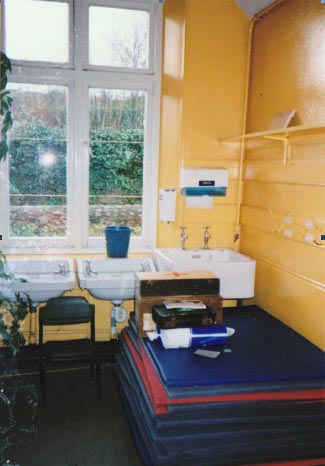
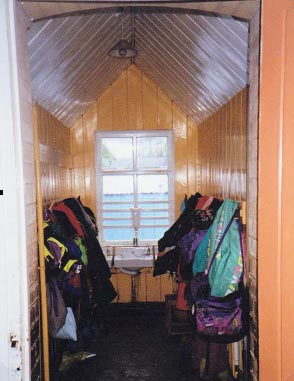
In January 1950 washbasins were fitted in the cloakrooms, but hot water wasn't installed until November 1964. The girls' cloakroom, on the left, was also used as overflow storage for PE equipment. The main door into the school building for visitors was through this cloakroom. The boys' cloakroom 9above on the right) was very cramped which made for difficulties on wet days.
The door in the South East corner of the hall lead into the classroom and from there into the boys' cloakroom. Unfortunately the classroom became a passage for people going from the hall to the temporary classrooms.
From the South West corner of the hall a door lead into the staffroom. This was also very cramped with seating for a maximum of seven people. A carpet was fitted in January 1972.
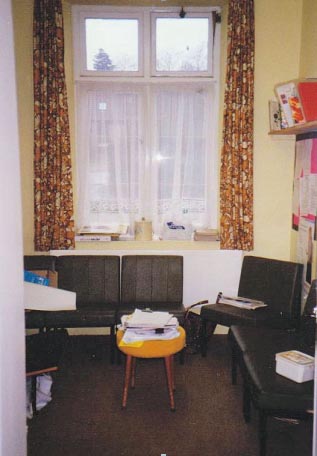
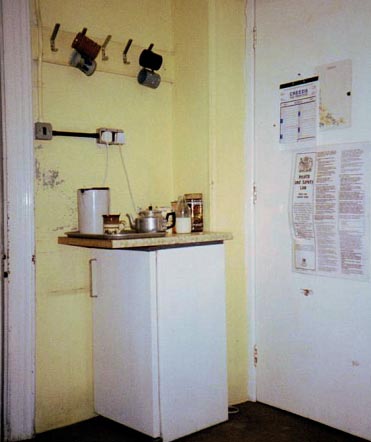
The door on the right of the picture lead into the staff toilet which was constructed in September 1971. Electricity was installed in March 1972 enabling the staff to have use of a fridge and tea making facilities. At one time this was also used as an office for the secretary who was appointed in October 1968 for 2 hours a week. These hours were increased to five and a half in September 1969.
Also leading off the hall was a kitchen with a hatch for serving lunches. The hatch, along with a sterilising sink, was installed in June 1979 only to become obsolete when lunches were stopped in September 1980. When school meals ceased the kitchen became a storage area for much of the equipment needed for the Under 5' Group. An electric cooker was also installed to allow classes to have cooking lessons. This room had also originally been used as a staffroom.
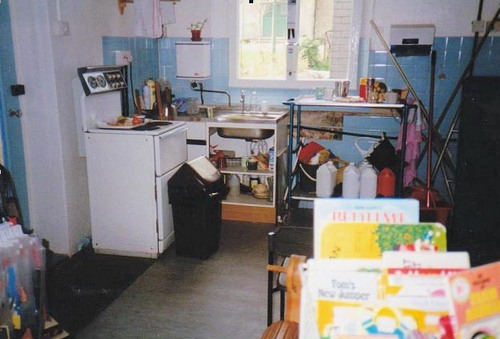
The hall was also used daily for school assemblies. These took place first thing every morning and had a moral or religious theme with a talk or story followed by a hymn and prayers taken by members of staff or occasionally a visiting speaker. One morning a week there was a hymn practice which the children and the staff thoroughly enjoyed.
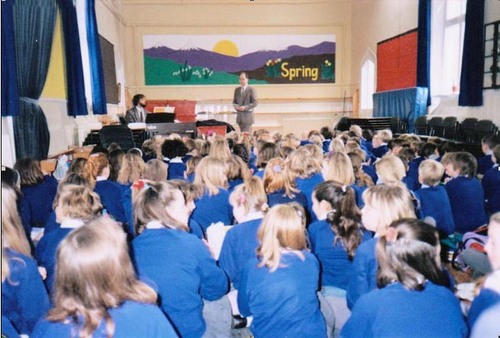
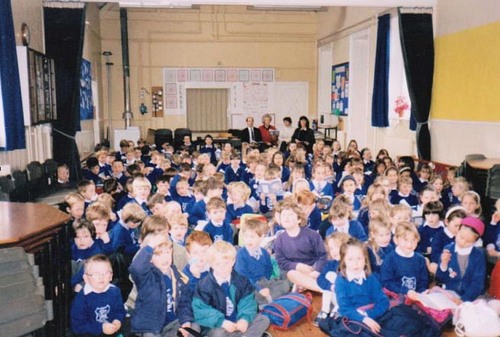
This was the last assembly held in the old building and gives a good view of the hall showing how the tables were stacked in readiness for lunches and other activities. It also shows the hatch at the far end between the kitchen and the hall which was installed in June 1979.
The hall originally had a semi permanent sliding glass partition across the middle dividing it into two separate classrooms. In April 1976 when the hall was no longer needed for classrooms a curtain was fitted to allow better TV viewing at the North end. The first television, a 23 inch Baird, had been purchased in January 1965. The curtain also created an extension area for the top junior classroom. Lighting in the three original classrooms must have been poor, because in November 1964 10 extra lights were fitted taking the number from 4 to 14.
The classroom off the main hall was comparatively small, 400 square feet. The maximum number of children in this class was 26 leaving little room for movement. It was usual to have the older children in this room, but that was sometimes governed by the number of pupils in the top year. It was always better to have the top year all together in one room, because of the separate activities solely for them, so if the number was more than 26 one of the temporary classrooms had to be used.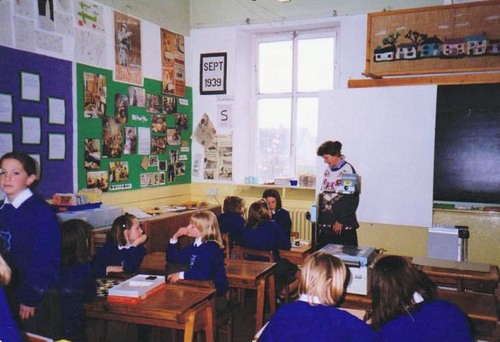
This picture shows the classroom and was taken during a wet lunchtime when the children stayed in their classrooms and played games. It also shows the locker type desks that the children preferred because they could keep all their belongings in one place. They also took up less space and eliminated children's excuse to wander around the room unnecessarily.
Prior to November 1972 the Head teacher had lived in the school house. After that it was used for valuable office and storage space. The picture below shows the front room which was originally used for remedial groups once night store heaters had been installed in September 1973. It later became the television room. It was also used for peripatetic music tuition, medicals, small groups and Governors and PTA meetings. It also housed the photocopier!
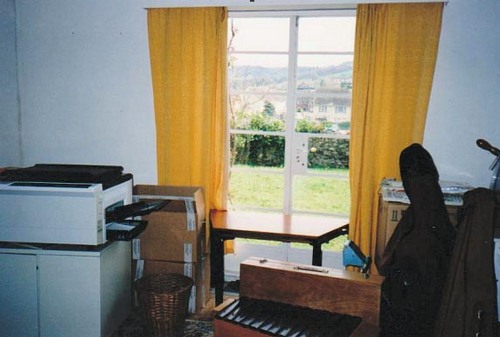
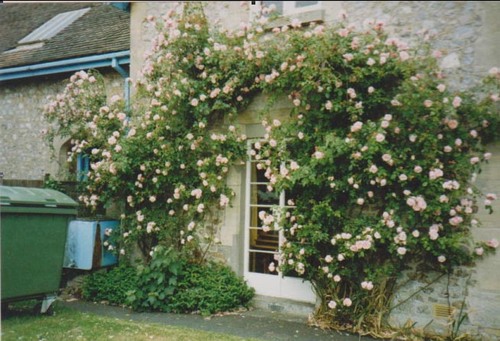
There were two other rooms on the ground floor. The room which had been a dining room and looked out onto Lower Sea Lea was the Head teacher's office (below). This was shared with the school secretary for a time, but this proved unsatisfactory, because of the need for confidential meetings to be held in the room, so the furniture in the old kitchen was removed and the room converted into an office. As there was a hatch through into the Head's office it was an ideal solution.
The telephone, which had only been installed in the school in September 1968, was extended into both offices. A security alarm system was fitted in October 1983.
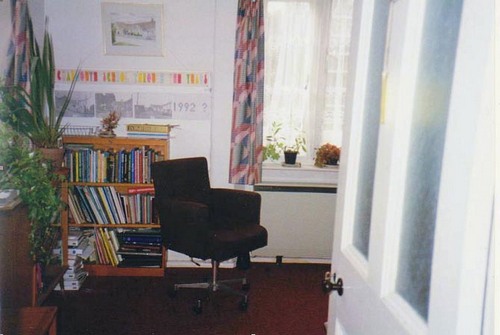
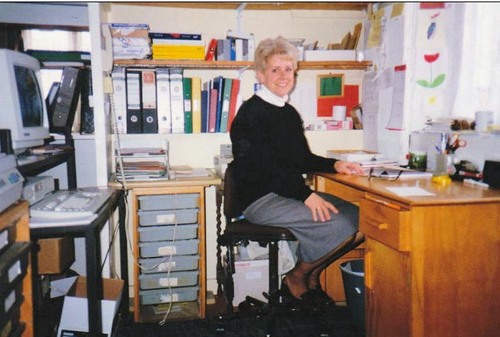
There were three upstairs rooms in the school house. These were left empty until 1977 when it was decided to use the space for storage. The school stationary stock was kept there as well as costumes and scenery used in Christmas Productions, Open Assemblies and Leavers' Concerts.
In October 1988 the bath, toilet and sink were removed from the school house bathroom and the room converted into an office for the Deputy Head teacher.
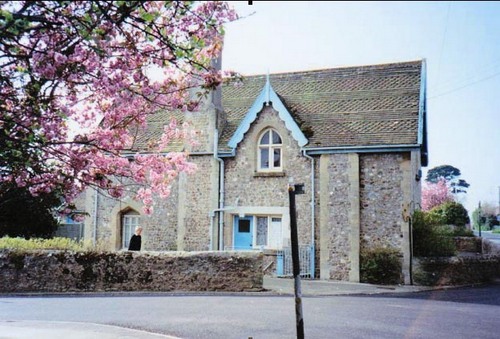
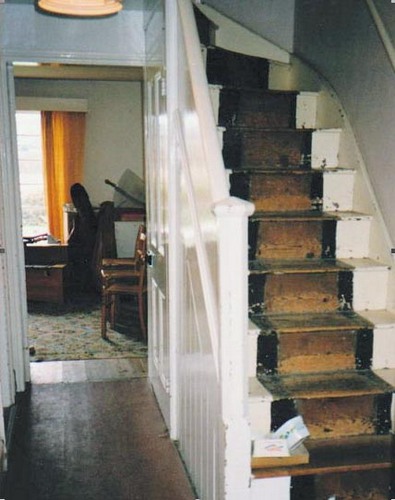
The front room viewed from the entrance and the stairs leading to the first floor. There was a door on the left into the secretary's office and the door on the right was to an under stairs storage cupboard.
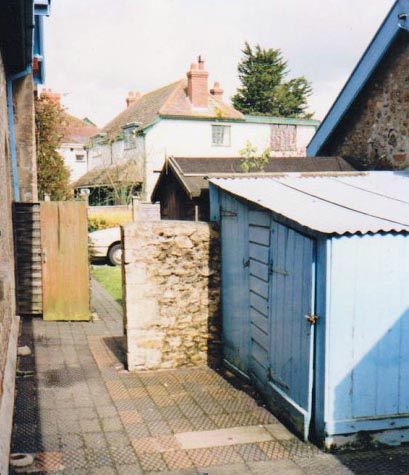
This was the path from the North East door of the hall leading to the boys' toilets and the temporary classrooms.
The shed was for PE equipment, easily accessible from the hall and the blue cupboard on the right was used as a solid fuel store until the boiler was converted to gas. It then became the caretaker's store for rubbish prior to being taken out on collection day.
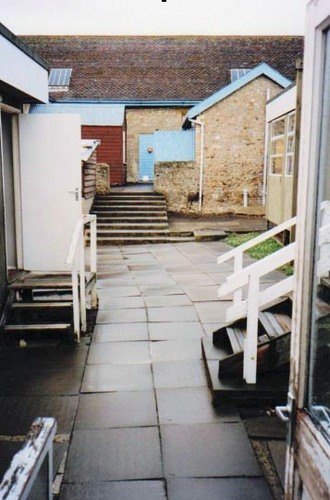
Here is a clear view of the path from the temporary classrooms to the main building. The brown extension in the background is the boys' cloakroom with the boys' toilet opposite. The sky lights in the main building were installed in September 1908. On the left in the foreground is the door to the boys' temporary toilet and on the right the steps to one of the temporary classrooms.
Before the mobile classrooms were installed parents had met with County Officials to discuss a covered way between the classrooms and the main building. Nothing ever came of this. It was brought up again in the 1980s, but was deemed impractical and expensive.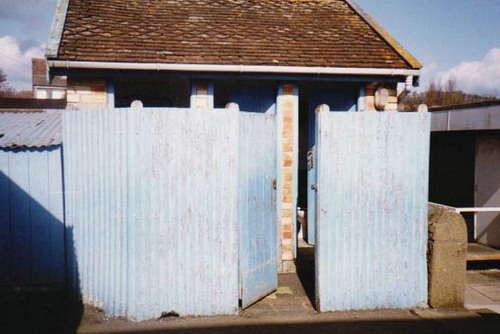
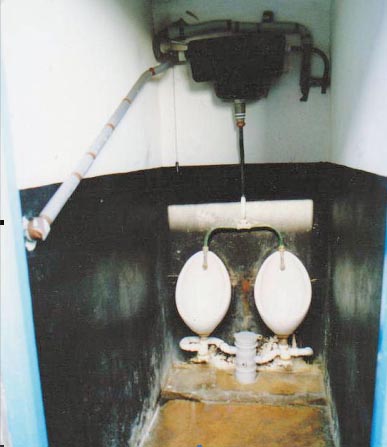
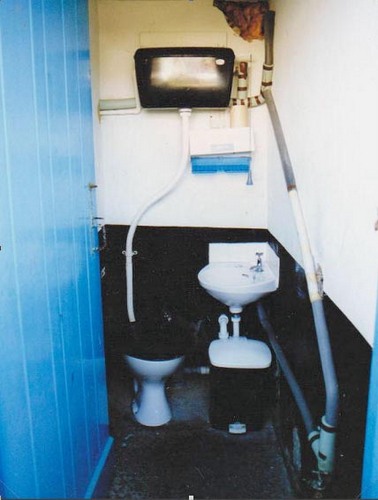
These are photos of the inside of the boys' toilets. The urinal on the left was permanently open to the elements and all the pipe work, although lagged, is on the surface, making it susceptible to even the slightest frost. This was a constant problem throughout the Winter months and during very cold spells the plumber came straight to the school on his way to work to enable the school to stay open.
The girls' toilets were even worse, as they were on the North side of the building.A water tank and fresh water were only connected in September 1906.
The toilets were renovated and fitted to the Charmouth main drainage system in June 1960. The Head teacher reported on the unsatisfactory toilet facilities in November 1967 and pedestal type toilets were fitted in the boys' toilet in January 1968, but sinks weren't fitted until June 1985, and even then not in the urinals.
On 4 th September 1885 the Clerk informed the Board that Thomas Fippin refused to flush out the closets more than once a week unless he was paid extra. His services were dispensed with and Amy Newton agreed to flush out the closets every day for 6 pence (2 ½ today) a week.
This construction, often referred to as ‘The Play Shed', next to the steps leading from the main building had to be used as a classroom at the beginning of the war when numbers increased due to the evacuees from St Peter's C of E School, Paddington, London. Although it was boarded up to make it weather proof, conditions must have been uncomfortable, cold, dark and difficult.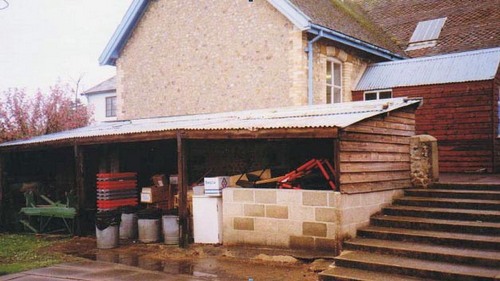
Charmouth is truly a combined or community school having taken in children from Monkton Wyld on 27 th April 1908, Stanton St Gabriel, Morcombelake, 15 children, on 10 th September 1946 and Whitchurch Canonicorum and Wootton Fitzpaine in 1970. Children were also admitted from private schools in June 1886 and February 1898. In both these cases the children were found to be backward for their age.
The closure of the first two schools seems to have gone fairly smoothly, but there was much opposition from all three schools to the closure of Whitchurch and Wootton. Plans for the temporary classrooms were delivered as early as September 1968, but the scheme was put on hold in early March 1969 because Charmouth parents had lodged an objection. On April 21 st 1969 the Minister of Education stated that the enlargement of Charmouth School would go ahead despite the protests. After that, much effort was put into making sure that the transfer took place smoothly.
The mobile classrooms and toilet block were completed on 23 rd April 1970. These were equipped with some new furniture and some transferred from the closing schools. On the 9 th September 1970 22 children from Whitchurch and 23 from Wootton were admitted to Charmouth School.
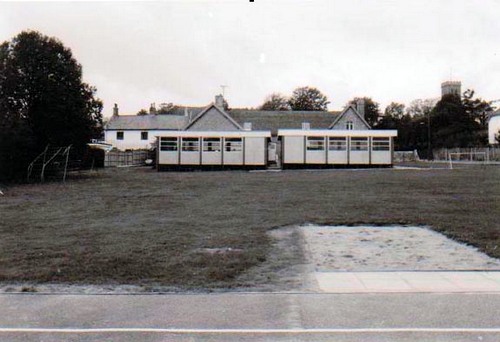
This shows the school from the East after the three mobile classrooms had been put in place.
The sand area in the foreground was the long jump pit.
Although there had been much opposition to the erection of mobile classrooms there were also major benefits. These units freed up the area previously used for classrooms and provided the school with a much needed hall. The advantages and uses of the hall have already been addressed. Several years after the amalgamation of the three schools it was generally agreed that the benefits far outweighed the disadvantages, and that all children could be provided with a much better all round education in a larger unit.
The transport, which had been one of the negative points, actually ran very smoothly until in September 1985 when the County decided to impose charges for children travelling from the villages. County Councillors and Education Department Officials attended meetings to discuss several parents' refusal to pay for school transport quoting the fact that, when the schools in Whitchurch and Wootton closed, transport would be provided. The County's argument was that they had agreed to provide transport, but not necessarily free. One parent removed his child from the school. A few years later free transport was reinstated for children from Whitchurch and Wootton, but those coming from Lyme Regis and Symondsbury had to provide their own transport. A mini-bus came from Lyme Regis, but children from Symondsbury came by car.
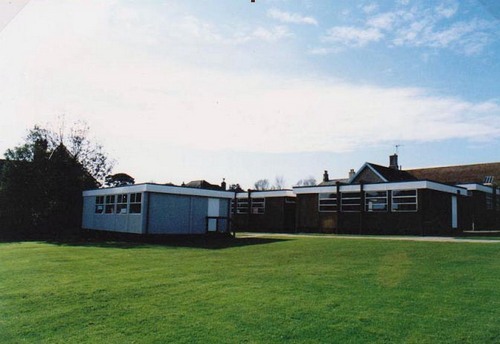
As numbers increased it became necessary to bring in a fourth mobile unit. This remained until the early eighties when it was removed because numbers were very low. It then had to be brought back in September 1987 at considerable cost! Because they were all off the ground the mobiles were cold in Winter and susceptible to freezing. The three original units were very expensive to heat, each having four 3 kw convector heaters using peak electricity. The fourth had an oil stove.
These classrooms were also a problem to maintain. On 4 th September 1980 the three original mobiles were reroofed. On 26 th September they had to be redone because the first job was unsatisfactory. By November the Infant room was leaking again and there were more similar problems in December. On 16 th January 1981 the Infant roof was redone, but by January 1982 further leaks were reported in the same room. In April 1986 the cleaner put her foot through the floor of one of the rooms and in September of that year the three original mobiles were strengthened externally by putting timbers up the sides and across the tops of the classrooms. These can be seen in the picture above. In April 1987 further leaks in the Infant roof had to be repaired. In September 1987 the three original mobiles were again reroofed and redecorated at a cost of approximately £20,000.
In October 1988 4in x 4in props were fitted to the centre of all the temporary classrooms for safety reasons. The photo opposite shows these props inside one of the classrooms. All these difficulties added weight to the arguments for a new school.
On a more positive note in November 1987all the temporary classrooms were carpeted. The carpets were paid for by the PTA at a cost of £1013. They made a big difference to the comfort, the warmth and particularly the noise.
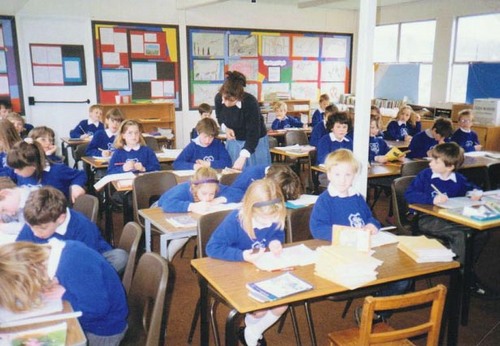
At one point in the late eighties the numbers were so large (41) in the Reception Class that, despite the fact that all available ancillary help was placed with that class, a large shed was purchased to use with small groups. There were windows in each wall and all the walls were lined for insulation then painted to allow pictures to be put around. Most importantly there was a fire extinguisher. A path was constructed from the classroom to the shed.
This facility was a novelty for the children and they loved being taken to work in it. They called it ‘The Cabin'.
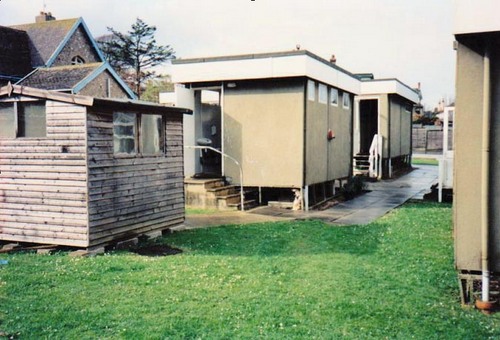
This picture also shows the girls' side of the temporary toilets with a drinking fountain just inside the door.
On the side of the toilet block is the red fire bell which was to alert the temporary classrooms in the event of fire. Because it was open to the elements it was not always as effective as it should have been despite the fact that fire practices were held each term. There was another similar bell on the wall of the main building. On one fire drill in October 1987 both fire bells were found to be faulty. The same problem occurred in April 1989.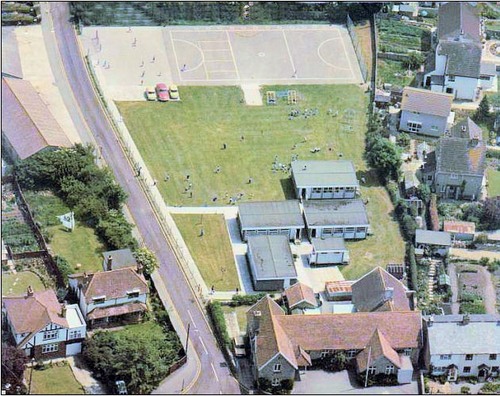
This aerial photo shows the positioning of the temporary classrooms. From September 1970 until the school closed in April 1993 Charmouth School was in the unusual position of having four fifths of its teaching area in temporary buildings. This was another major factor in support of a new school. Through the superb efforts of the teachers standards were very high despite the difficult conditions.
The small shed against the perimeter fence on the right of the picture was used to store the equipment for outdoor PE and games.
The picture shows the children on both the grass and hard areas. The grass area was only used during the Summer months: something the children really appreciated. It also shows the flagpole which was taken down in October 1980 for safety reasons and was not replaced.
Staff had previously parked their cars opposite the school on the tennis court car park. This facility was withdrawn by the Tennis Club and so, in September 1978, the Head teacher applied to the West Dorset District Council to be allocated some spaces on the central village car park off Lower Sea Lane. This was refused, a fact that was headline news in the local paper at the time.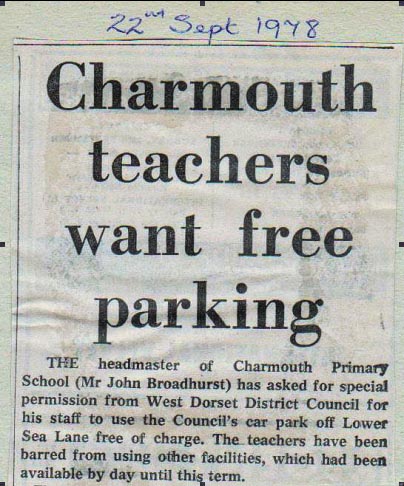
The County then provided the paved area, adjacent to the playground, for staff and visitors parking.
Grounds.
When the school opened the only play area was the small space at the front of the building. The earliest reference to this is 18 th June 1897 when gravelling was completed. Inadequacies in the playground are mentioned in the Log Book in September 1908 and in July 1909 it states that a start was made on a new playground which was completed in September of that year. By October this was considered dangerous to health because of drainage problems. One thing isn't clear is where this new playground is situated because the next reference to the playground is in March 1924 when land was purchased at the rear of the school, from the church, for £300.
This suggests that in 1909 the original playground at the front of the school was completely redone, most likely with tarmac, instead of the gravel, thus causing the drainage problem.
In 1926 a playground opened on the land purchased from the church. This was a grass area and therefore the small playground at the front still had to be used in wet weather. The remainder of the land between the new grass area and the Council Houses was purchased, at a cost of £1500, in September 1951. It was ploughed and became the new school garden in February 1952. Therefore the school no longer needed the allotments in Parkway.
Also in February 1952 the wall at the North West corner of the grounds was taken down and rebuilt nearer the school house. This enabled there to be a road built down to Wesley's Close. In April of that year the children planted potatoes on the new land, as a smother crop and a Bramley Apple tree was planted in the new field. In March 1953 fencing was installed around the new field.
On July 14 th 1933 a Sports Evening, from 5.30 to 7.30 pm was held in the village playing fields. The playing fields were also used for games.
Gardening was an important part of the curriculum and a gardening examination was held each term. Pests were controlled with paraffin emulsion. The allotments used by the school were where No 6 Parkway now is. On 1 st March 1948 all the 11+ boys and girls spent the day working on the allotments spreading manure and planting potatoes.
In March 1953 a fence was installed around the new field. On 12 th March that year an official drought was announced and the children worked every afternoon in the school garden. The hedge dividing the new field from the existing school land was removed and on 30 th September 1954 the field was ploughed and seeded using 84 lbs of grass seed. This must have cut down gardening sessions because they were only left with the allotment to the East of the school house garden. In May 1966 the fence dividing the allotment from the rest of the play area was removed and the ground seeded. The picture below shows the area previously the allotment. It also shows the props that were put to hold up the mobile classrooms.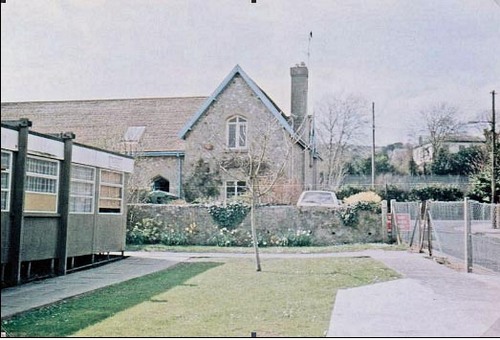
On November 16 th 1961 Netball posts were received and the field was marked out for football, but football posts were not erected until 2 nd May 1962.
A wooden boundary fence was erected on the South side of the playground in September 1962 and on 12 th March the following year the front playground was resurfaced. While the work was being carried out the children were taken down to the beach to play as the field was too wet to use.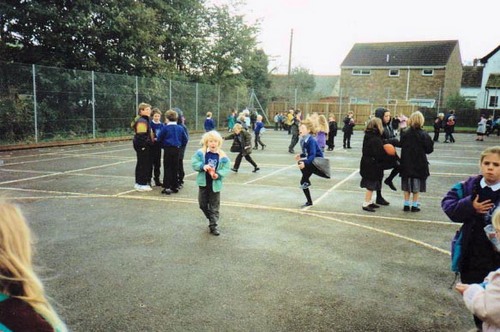
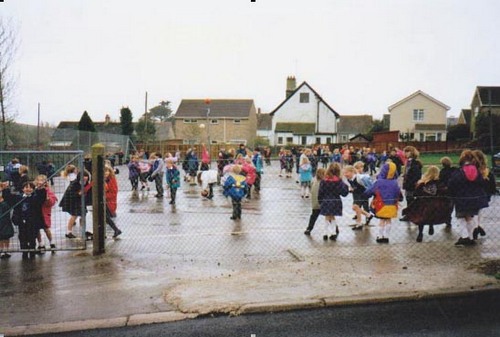
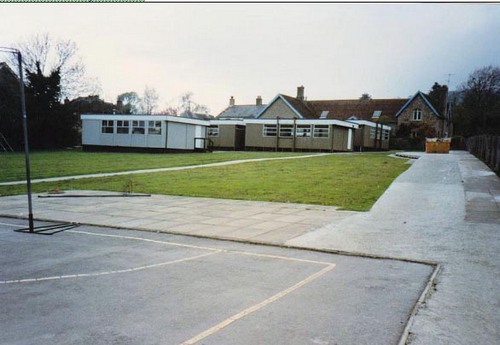
In October 1992 Wessex Water closed the lower part of Charmouth main street which meant that all traffic was re-routed down Wesley Close. For the safety of the children a wide concrete path was constructed parallel with the road, but inside the school fence, with a wider area for picking up and dropping of at the top.
This was solely for use by vehicles dropping off and picking up children with entry from the East end of the site. Another path had, therefore, to be constructed across the middle of the grass area for the children to go to and from the playground. The picture below shows the children using the original path while the new one, in the foreground, was being constructed.
The top picture also shows the outlet pipe for the oil stove in the southern end of the bottom mobile classroom which had been put on site 7 th September 1987. This outlet pipe is referred to later.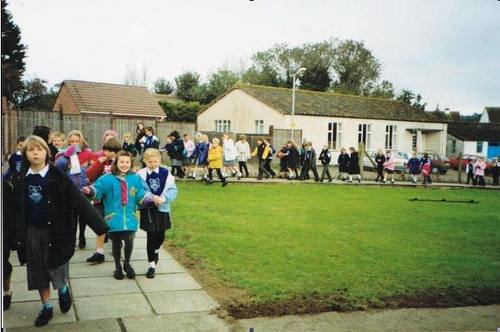
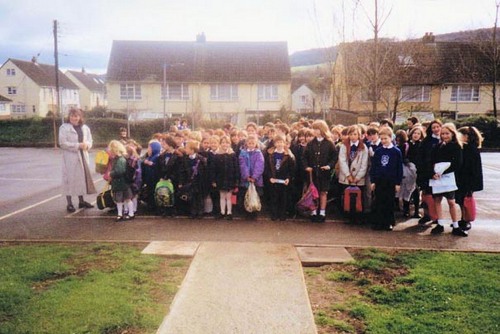
This picture shows the children lining up to come into school on the new path. It also shows the line of the newer tarmac, put down in April 1972, to the left of the yellow line behind the teacher.
In January 1969 a small gate was constructed on the North side of the chain link fence to give pedestrian access to Wesley Close. The front gate was no longer used for children to enter the school keeping them away from the busier Lower Sea Lane.
At the end of the school day the children lined up by the mobile classroom and were seen across Wesley Close, by a member of staff, to parents waiting on the opposite side of the road. The gate was padlocked at night and during the school holidays.
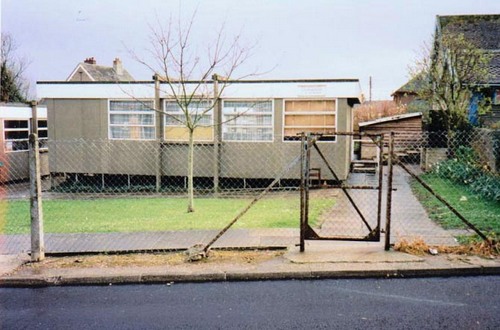
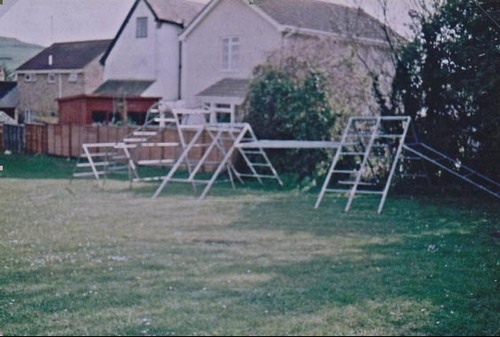
This climbing frame which the children were able to use, under supervision, was delivered on 1st February 1977. When the school moved to the new site it part of it was taken to the village playing field.
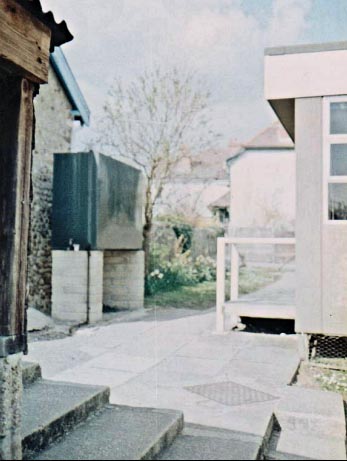
When the extra mobile classroom was installed in June 1972 it was found to be heated by an oil stove situated at the back of the room. The chimney outlet for the stove can be seen in the aerial photo of the school grounds. The oil tank shown here was placed on a concrete block platform against the wall of the outside toilets. When the mobile was reintroduced in September 1987 the stove was at the front of the classroom.
There was no protection around the oil tank and today it would, therefore, be considered a Health and Safety hazard.
The school could in no way be classed as ‘green', using oil in one mobile classroom, 3 kw electric heaters in the other three mobile classrooms, gas in the main building and electric night store heaters in the school house.
In the South West corner of the school site there was a small pond. This was constructed by simply making a pond shape out of concrete. This was left for 6 months to allow the acid to come out of the cement and then pond weeds and gold fish lived happily there and gave the children much pleasure. On one occasion when the weed was beginning to take over two senior girls were asked to remove some of it. Using a garden fork they plunged it into the weed and pulling it out they discovered the fork not only had weed on it, but they had also speared a fish. This only came to light when one of the young ladies in question was in her twenties!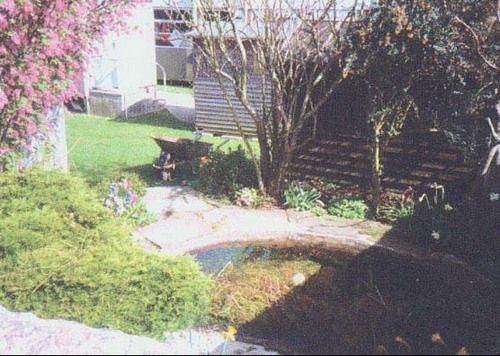
Pets are very rare in school today, but the Reception class had several rabbits before moving to the new building. The favourite was called Lightning and they also had a guinea pig called Huffy. The children loved their pets and it was good for them to learn to care for animals. The rabbits were not without their problems. The temporary classrooms were all sited off the ground and had netting around their bases. However over time this netting had developed holes in places and on several occasions when the rabbits escaped from their cage they made straight for these holes and took much persuasion to come out!
The rabbits had to be cared for during the holidays and were often looked after by members of staff. On one occasion when a parent was taking a turn to care for the rabbit it was unfortunately killed by the family dog. Below shows the double cage made to lessen the chance of escape.
Stick insects were kept for a time, which was fine until they also escaped!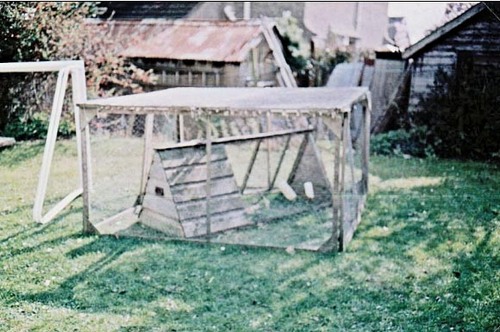
More Recent Special Occasions, Events and Initiatives.
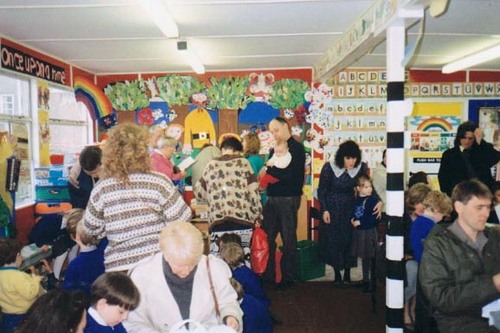
This picture shows parents in the Infant classroom following the class' Open Assembly. Once or twice a term each class presented an Assembly in the school hall to which the parents and friends of the children in that class were invited. The parents then went back to the classroom with the children to look at their work. This was not intended as an opportunity for a discussion about progress with the teacher, but purely an opportunity for children to show off what they had been doing in class to their parents.
Open evenings were held in the Autumn and Summer terms when parents had an allotted time to speak to the teacher about progress and any topic to do with the welfare of their child. The first Open Assembly was held on 30 th April 1968.
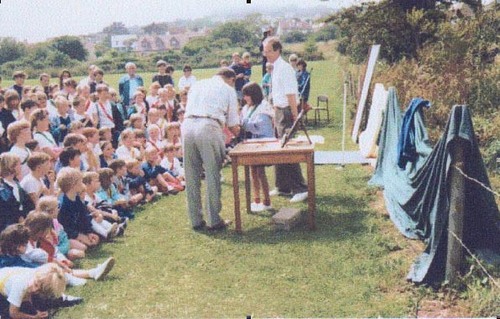
This picture shows children during the presentation, by Mr Tony Stevens, Chairman of Governors, at the school Sports Day held annually in late June on the ground on which the school now stands.
The Sports Day was a mixture of novelty races, flat races and shuttle relays. Long jump, high jump and throwing events were held prior to the actual day, but points scored for these events were added to the overall totals achieved by the four teams. The blackboard leaning against the fence showed the points achieved by each team as the event progressed. A loud speaker system was set up to announce the results after each race. The Mums and Dads races were never short of entrants and keenly contested.
This field was large enough for two football pitches parallel with the road and was first used for that purpose in September 1976. From 1982 to 1991 the Smiths Crisps 6-a-side football tournament was held on the field. Having two pitches close together made it an ideal venue.
Prior to this space being available the village playing field had been used for Sports Days and football. In 1933 the Sports Day was held in the evening. It was also used again during the time when the new school was being built as seen below. The cub hut is in the background.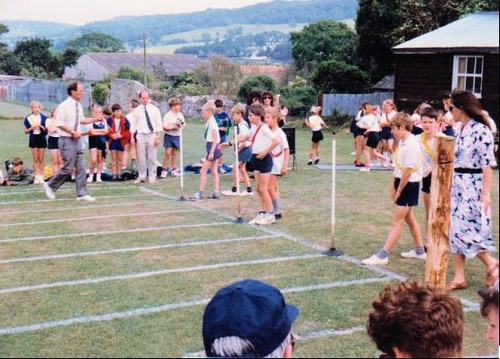
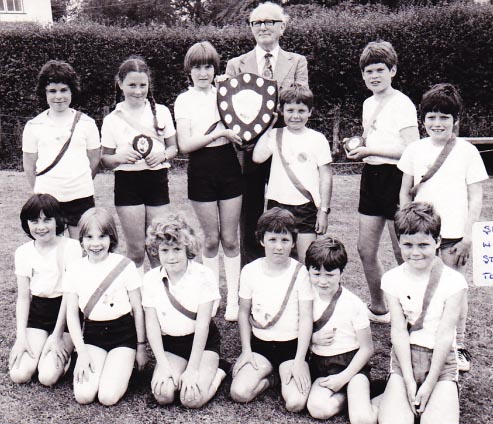
Back row: Sarah Harris, Rosalyn Day, Helen Smith, Mr Sturgess, Steven Broadhurst, Gary Smith, Kevin Butler
Front Row: Ruth Saphorghan, Georgina Bearpark, Karen Thomas, Paul Hill,
Keiron Harris, Tony Broadhurst.
On 17 th July 1976 the first School Fete was held in the school grounds. £280 was raised.
These became very popular events and many activities were held at the Fetes over the years often beginning with a children's Fancy Dress Parade. (Below) Other activities included a Dog Show, an inter pub Tug of War, a children's Magic Show, a Punch and Judy Show as well as games, competitions and various stalls.
Refreshments and ice creams were served throughout the afternoon
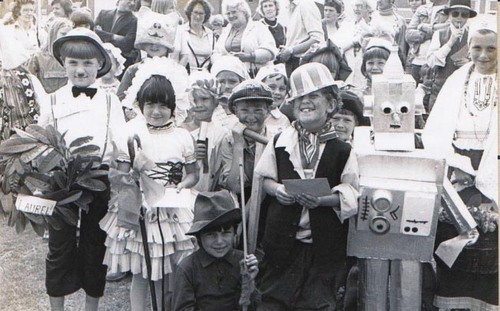
For the first few years much ingenuity and imagination was used by parents in the making of the costumes for their children and initially there were separate classes for younger and older children. Gradually, however, the numbers of children entering dwindled and unfortunately that part of the fete was dropped.
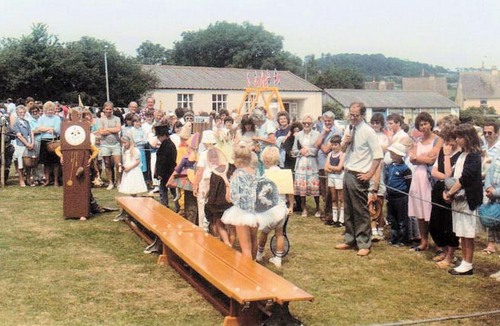
From 1983 a Fun Run for families and a Challenge for serious runners was introduced as part of the fete. The route of the Fun Run and Challenge went from the school, down Wesley Close to the main road, along the main road as far as Sonebarrow Hill. At the top of the hill the Fun Runners turned right to the cliff and then down the hill overlooking the sea and back up Lower Sea Lane to the school. The Challenge went on from the top of Stonebarrow Hill to the top of Golden Cap and then followed the coastal path down to Lower Sea Lane and back to the school. As is illustrated in the picture there were many different classes which were all awarded trophies. As well as the many trophies everyone who took part and completed the course was given a medal. Serious runners from all over the country came to take part in the Challenge and most brought their families with them which added considerably to the number attending the Fete.
The races were the idea of Mr Martin Young who organised that part of the event. Much extra help was needed for stewards around the course to direct participants, water stations and the recording of the results. All this increased the income from the day's event and by the time it moved to the new building over £3000 was being added to the PTA funds on Fete Day.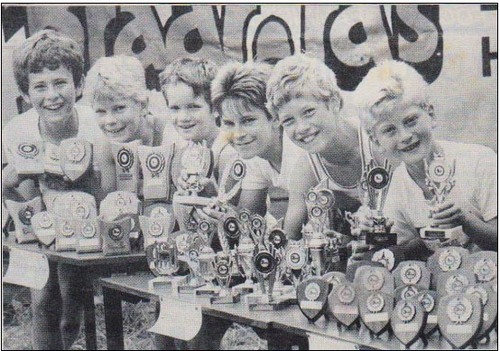
On 17 th October 1977 the first four day visit to London began. This was a joint venture with Symondsbury School. Those children from Years 5 & 6 who wished to take part spent three nights in a London hotel and visited many of the famous landmarks in the capital. They also had a conducted tour of the Houses of Lords and Commons, watched the Changing of the Guard from inside the railings of Buckingham Palace, had a trip on a Thames launch from Westminster Bridge to The Tower and went to a West End Show. These trips took place every other year and the first visit cost £34 per child. It was quite noticeably more tiring for the younger group due to the exciting, long days and their lack of sleep.
The photo below shows the group in the coach ready to leave for their trip in October 1981.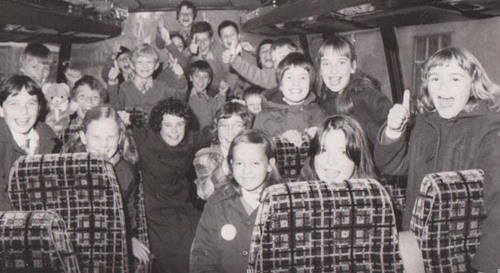
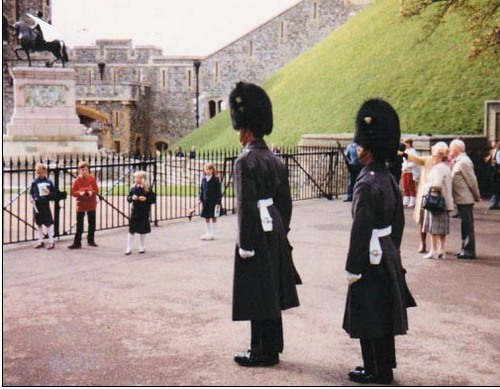
As prices increased the length of the visit was cut to three days to make it more affordable to all parents.
The pictures below show the children outside Number 10, Downing Street. Permission had to be obtained from the police to enter Downing Street. The middle picture shows the group on the steps at the entrance to the House of Lords under the Victoria Tower. The trip around the Houses of Parliament was organised by the local Member of Parliament, who also arranged for several guides to show the children around in small groups. The third picture is of the children having their packed lunch in the Education area of the Natural History and Science Museums.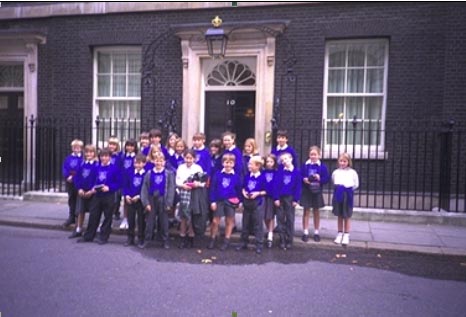
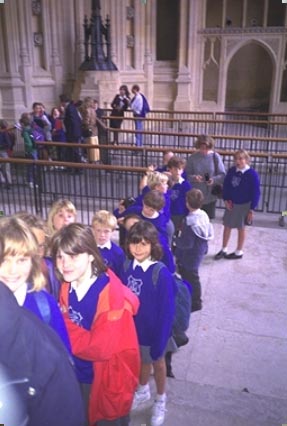
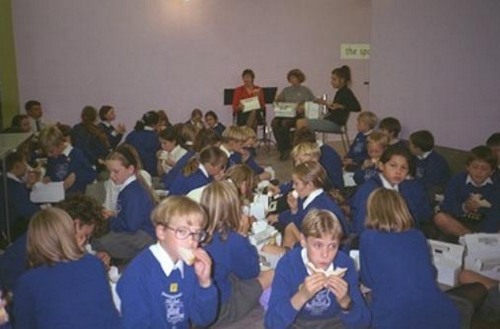
The PTA held many money raising events to support the school. One of these was the annual Jumble Sale, the first of which was held on 4 th March 1978 when £132 was raised. As seen in the next photo a vast amount of clothing was brought into school by the children. This created a problem of disposing of what was left after the event. For many years a Mr Steptoe from Crewkerne took away a van load. He only paid a couple of pounds, but saved the worry of having to dispose of unwanted clothing.
Later, in an attempt to encourage people to take more clothes, the PTA tried selling bin liners for £1 and allowing people to fill them with clothing. It never ceased to amaze how much some members of the public were able to cram into one bag! Eventually, due to the amount people were willing to pay reasonable amounts for items it ceased to be a viable event.
As well as the mountain of clothes there was also a stall selling White Elephant which was against the rear wall of the hall.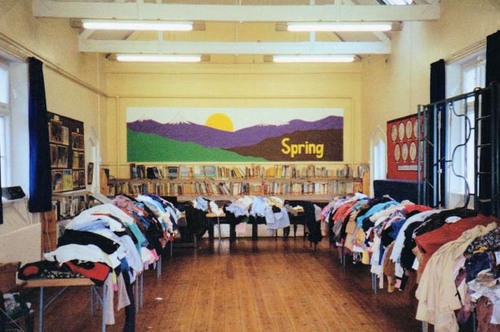
Brian Hooper was the UK's top pole vaulter from 1974 to 1980, competing in two Olympic Games and two European Athletics Championships. He also won six Superstar events including one world title.
‘Superstars' was a televised all round sports competition for elite athletes. On 27 th February 1984 he came to the school for a Super Schools Event.
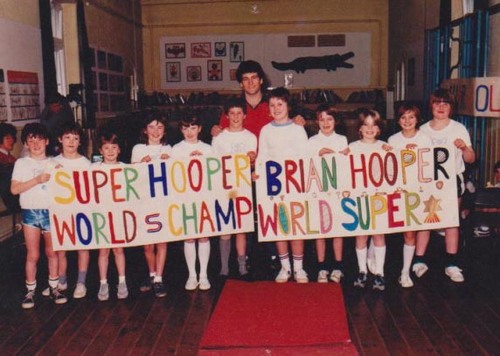
This picture shows Brian Hooper with a group of Year 6 boys and girls, after they had successfully completed their exercises. On the first occasion the school was the one which raised most money per pupil since Super School began.
On the day, all pupils were photographed individually with Brian Hooper and took part in four simple gymnastic exercises for which they had previously obtained sponsors. Afterwards there was a question and answer session with Brian Hooper. In subsequent Super School Events the superstars were Sharon Davies, the Olympic swimmer, a gymnast and a long jumper.
The picture below shows an occasion when the event was held in the Summer and took place outside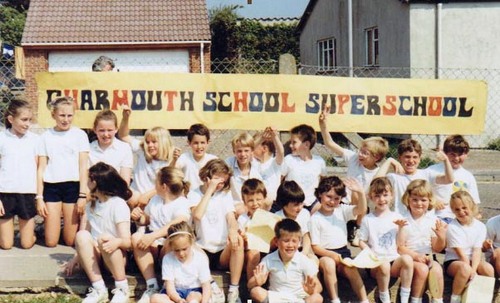
On 17 th November 1984 the first Christmas Bazaar and Coffee Morning was held in the school hall. Christmas gifts, wrapping paper, cards and craft items were on sale with Father Christmas in attendance.
This proved a very popular PTA event and the first occasion raised over £200. Tables were borrowed from the Village Hall opposite. In subsequent years it continued to attract good crowds on a Saturday morning.
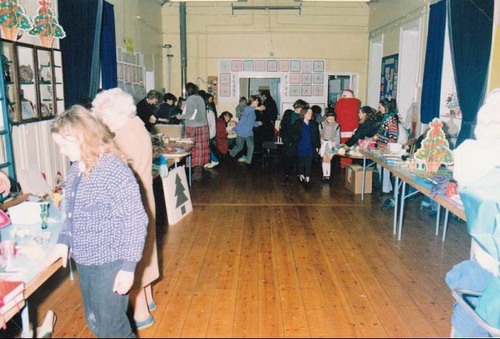
Another popular event was the Christmas Bingo held on a Friday evening at the end of November. This was primarily to raise money for the children's Christmas Parties which were held on the last Thursday of the Christmas Term. The Bingo was always well attended. Initially all the prizes were Christmas puddings, but later a variety of prizes were bought and many donated.
For the Bingo it was a tradition that all members of the PTA committee provided a dozen mince pies which were served with tea or coffee half way through the evening.
On the party afternoon the children changed into party clothes and played games in their classrooms before going over to the village hall where some of the parents had prepared a party tea. The younger children were provided with fancy hats, but the older children made their own in the classroom as in the photograph.
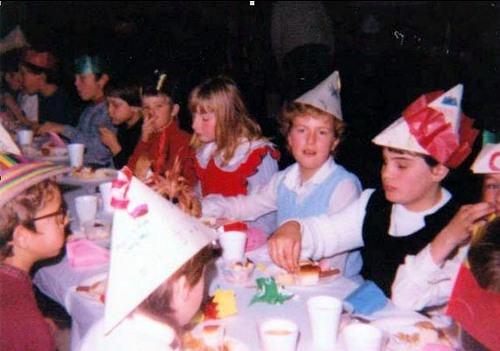
Later the children had games in their classroom, followed by cartoon films on video in the hall while parents came into the classrooms and assisted the staff in the preparation the party food. After the film the children returned to their classrooms and devoured the food. Father Christmas distributed gifts to all the Infant children.
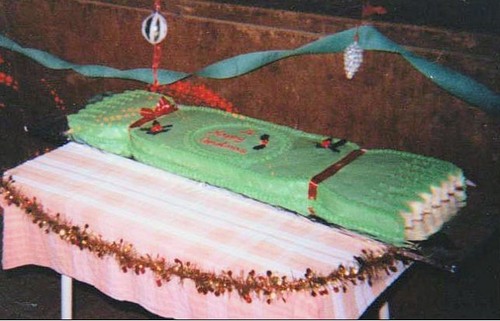
This is one of the huge cakes made by Mrs Peach when the party tea was held in the village hall. It was large enough for every child to have a piece.
On 9 th February 1981 an Under 5's group was started in the school hall taken initially by three parent volunteers. This was held on a Monday afternoon from 1.0pm to 3.0pm and enabled the children, due to start school during the following year, to come into school to become accustomed to the surroundings. The Reception Class teacher also spent a little time each afternoon so that she got to know the children and, more importantly they knew her.
This activity proved very successful and was later taken over by an ancillary member of staff assisted by volunteers. Much specialist apparatus was purchased by the PTA and stored in the school kitchen when it was no longer needed to serve school dinners.
Sometimes the children from the top class came in, during their playtime to spend time with little ones.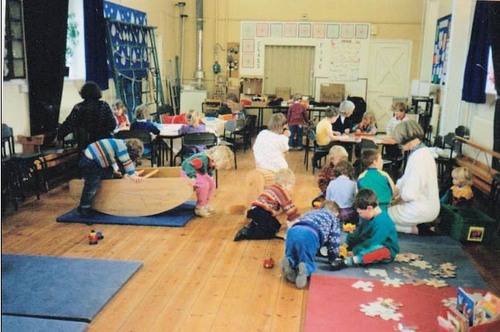
The photo below shows the children ready to be collected by parents at the end of the session and gives an indication of the number of children attending. The member of staff in charge, in the photo below, was Mrs Vivien Smith.
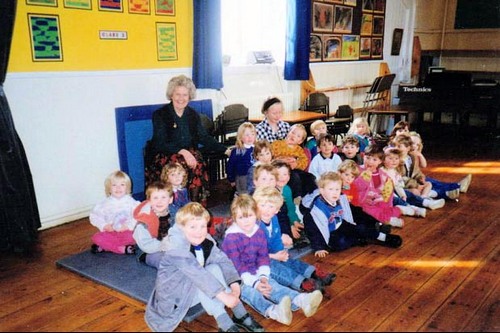
At the end of each Christmas term the whole school took part in a major production. This took place in the Church Hall opposite the school. A pantomime, story or theme formed the backbone of the show coordinated by a teacher. Each class took a specific part of the story enabling them to rehearse separately and the principal parts were taken by the older children working initially through the Drama Club. Holding the event in the Church Hall made full rehearsals difficult, particularly as the stage had to be enlarged for the event and as the hall was used for other activities such as badminton. It was sometimes necessary to erect the stage several times in the week leading up to the show. A matinee and two evening shows were performed.
This picture shows the whole cast of the 1977 production, Peter Pan. The school had some costumes, and gradually built up quite a wardrobe, but most of the costumes for each production were provided by the parents from instructions and suggestions from the teachers.
Each production relied quite heavily on music for singing and dancing and in this picture the orchestra can be seen on the left hand side at the front. The orchestra was made up of recorder players, glockenspiels and various percussion instruments accompanied by first, Mr Don Harris and later by Mr Paul Curtis, on the piano. Also at the front are acting boxes which formed a separate stage for parts of the play.
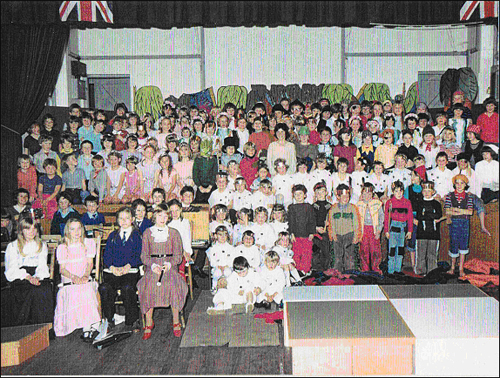
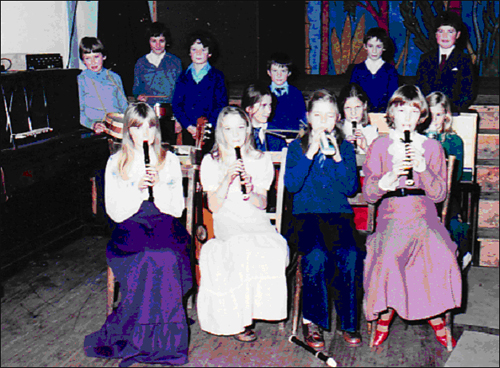
In 1980 a new method of presentation was tried, acting ‘in the round'. All the action took place on the floor of the hall with the audience at the back of the hall, the front and on the stage. This made it much easier from the point of view of not having to continually extend the stage and it also meant that the audience was nearer the action, some seated on the stage.
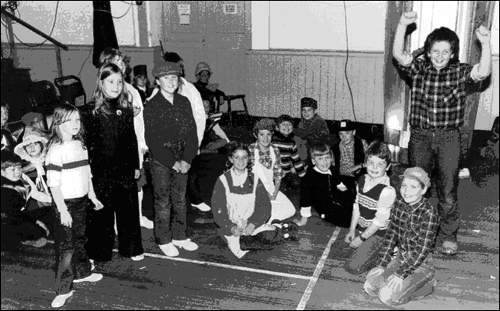
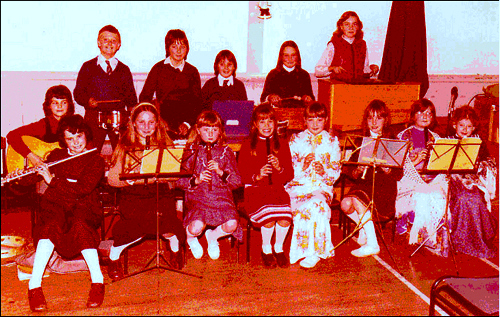
There was also a larger orchestra for this production, ‘Dinosaurs and All That Rubbish'. However the parents did not seem to take to this new approach and so the 1981 production, The Nativity, returned to the traditional format.
On 21 st December 1977 the school had held its first Carol Service in the Parish Church.
This service, held on the last day of the Christmas term, began with the first verse of Away in a Manger as a solo by one of the older children. Each class sang a carol of their choice, the Christmas story was read by the children, one from each class, there were congregational carols and a short talk by the Vicar. The service concluded with the last two verses of Away in a Manger.
The basic format for the service was always the same with different children and different music. A list of each year's readers was kept so that all children who wished would hopefully have a chance to read before they left the school.
Unfortunately in 1981, due to staff sickness, it was not possible to hold a Carol Service in the church. It was, therefore, decided to put on The Nativity as the Christmas Production in the Village Hall. On the next page is a scene from that production and the whole cast for the finale. There are far fewer children in the later picture as the numbers on roll were falling in the early eighties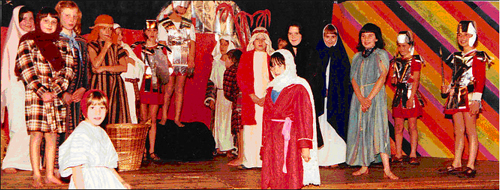
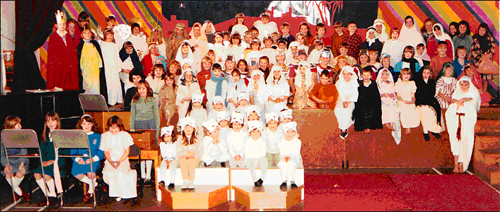
The scenery was usually painted by members of staff assisted by the children except, in 1989 when the production was The Four Seasons. For this Mrs Beverley Shaw painted four beautiful pictures photographed below.
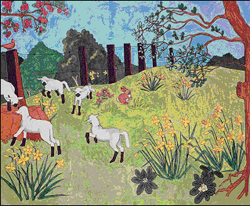
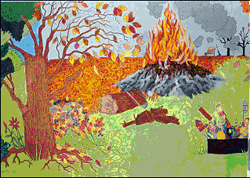


1975 A Christmas Happening.
1976 Carol Service.
1977 Peter Pan.
1978 The Pied Piper.
1979 Sleeping Beauty.
1980 Dinosaurs and all that Rubbish.
1981 The Nativity.
1982 The Grass is Greener.
1983 The Four Seasons.
1984 Sam's Magic Toy Shop.
1985 Granny's Christmas Treat.
1986 The Magic Snowflake.
1987 The Wizard of Oz.
1988 Cinderella.
1989 The Pied Piper.
1990 A King Forever - The Nativity.
1991 Snow White and the Seven Dwarfs.
1992 A Christmas Variety Show.
The school was fortunate in having teachers who were also first class musicians, firstly Mr Don Harris followed by Mr Paul Curtis. This was a tremendous plus when putting on major productions, which were all heavily dependant on music. Another major production was put on each Easter, held in the school hall as an Open Assembly. This was either a play of the Easter story, a series of songs telling the story with mime or a play which was based in some aspect of Easter, performed by one class
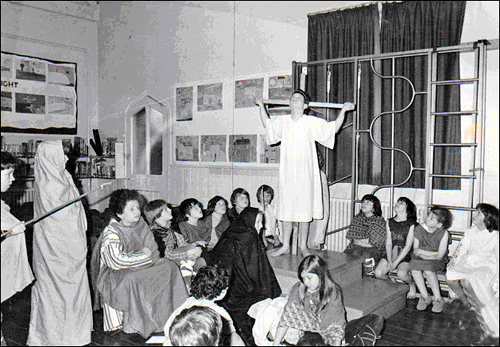
The above picture shows a scene from the Easter Story as portrayed by the top class with Gary Smith playing the part of Jesus.
The third important production of the year was a play put on by the Year 6 children for their Leavers' Concert. The play lasting about half an hour was performed in front of the leavers' parents, the Governors, the local vicar and a special invited guest. Below is a list of the guest speakers and the plays performed between 1978 and 1992.
Leavers' Concerts, Special Guests Number of Leavers.
1978 The Magic Fruit. Mrs H. Spicer. 30
1979 The Silver Penny and Sir John Colfox 28
The Apricot Tree.
1980 The Midnight Thief. Mrs P.J. Edwards. 19
1981 The Happy Prince. Major J.E. Nutall. 26
1982 The Moonrakers. Admiral Sir John Hamilton GBE 22
1983 Oliver. Vice Admiral Sir William Crawford KBE, CB, 22 DSC
1984 Robin Hood. The Lady Digby DL 23
1985 Little Lord Fauntleroy Vice Admiral Sir Fitzroy Talbot KBE, CB, 11 DSO, DL
1986 The Happy Prince. Lt-Col C.H. Gibson 17
1987 Noah's Wonderful Ark. Mrs O.E.S.I. Hole OBE 17
1988 Annie. Rear Admiral G. I. Pritchard CB 25
1989 Oliver. Mr P.W. Allsebrook CBE, DL 25
1990 Robin Hood. Mr T.B. Pearn OBE, MC 33
1991 Noah's Wonderful Ark Mr E.W. Ludlow, High Sheriff of Dorset. 19
1992 Murder on the Axminster Major General P.H. Benson CBE 34
Continental Express.
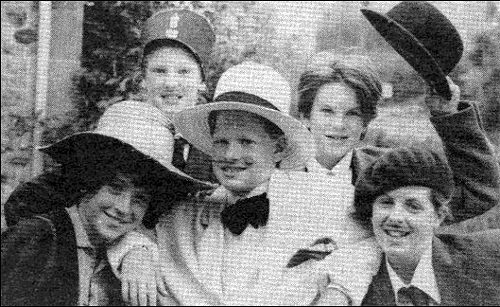
This picture, from the local newspaper, shows some of the characters from the last Leavers' Concert put on in the old building. The play was the idea of the children developed at the Youth Club in Wootton Fitzpaine based on Agatha Christie's Murder on the Orient Express. Their play included all popular sleuths from fiction.
A railway carriage was constructed by one of the parents at the end of the hall where all the action took place. The Year 5 children provided the choir to give backing to the singing and to show them what had to look forward to the following year when it was their turn.
The Leavers' Concert was designed to be a really special occasion to mark the great contribution each child had made towards the life of the school. It began with the play, followed by a brief talk by the special guest who then made the presentations.
All children who were leaving received an Observers Book of their own choice, and a Bible, given by the parish church. Cups and trophies were also presented to the winners of the various awards, academic, sporting, music and art. The event concluded with prayers, including the school prayer, lead by the vicar and the singing of the hymn ‘One more step along the world I go'. There were then light refreshments for all in the classroom.
The first Leavers' Concert was to have had Sir James Spicer, the local MP as special guest, but he was tied up with Parliamentary business at the time and so his wife filled in for him.
The strong music tradition, already mentioned, played a big part in the activities of the school. As well as teaching children to play the recorder, outside musicians came into school to give tuition in string, wind and brass instruments, violin tuition had started as early as July 1965. The school built up its own stock of musical instruments which were hired out for a minimal charge. These extra lessons were paid for by the parents. There was an annual Music Festival for all the primary schools in the Bridport and Lyme Regis areas held at Colfox School, Bridport. Each school provided 20 performers who sang various songs and there were some pieces played on recorders. The whole event was under the direction of Mr John Staff, the County Music Adviser accompanied by Mr John Tallon, Head Teacher of Symondsbury School.
Eventually as the Festival became bigger and more popular the Lyme Regis area primary schools had their own festival at the Woodroffe School. Charmouth played a big part in this event as it was mainly organised by Mr Paul Curtis, the school's music teacher. Children also took part in other instrumental concerts held at Colfox and Beaminster Schools and some children were involved with the Dorset Youth Orchestra. Groups of children also sang to the old people at the Elms and at other village events at Christmas.
On 7 th July 1992 the school held its own Musical Evening at which all who had been having individual music tuition played a small piece on their own instrument and then played together forming our own school orchestra. This event continued into the new school under the guidance of Mr Curtis.
On 15 th January 1991 the first session of Booked by Dorset began. This was a series of reading games played by the Infant children with their parents in the hall. Any children whose parent could not attend would either join another group or play with a member of staff or other volunteer helpers. Initially most of thegames were made in sessions when parents were asked to come and help make them. The sessions took place in the TV room. An advisor came from county to give guidance and supply kits and other materials.
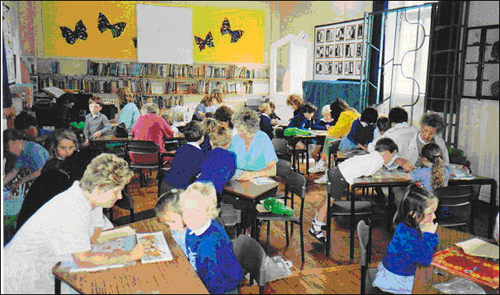
Being a seaside resort the school attached particular importance to teaching the children to swim. It was felt that the younger they learnt the better and various swimming pools were tried, but the one used most belonged to Mrs Lawrence, a former schools inspector. Mrs Mallabone, the Head of Infants, had a loyal band of parents helpers who came to school on Thursday mornings and accompanied the children to the pool, going in the water with them to give them confidence. The children soon grew in skill and confidence in the water.
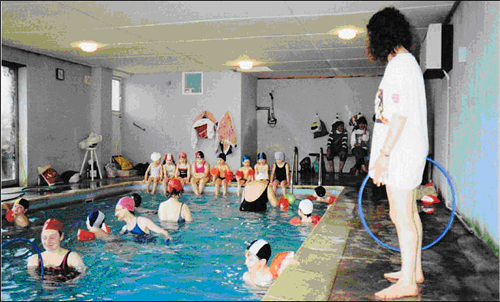
At the older end of the school on 2 nd June 1987 the Year 6 children lead by Mrs Kathy Foot did an exchange trip with children from a school in Exeter. They spent four days in Exeter and slept on the school premises. This gave the Charmouth children an idea of city life and those from the city an opportunity to sample life in the country.
This lead later to the Year 6 Activities Weeks beginning in May 1991 when Mr Mark Stratta took the Year 6 children from school and walked them up across Stonebarrow and down to St Gabriels. He was assisted by a team from the Outdoor Education Centre at Weymouth and Mrs Mandy Wiscombe. They carried everything they would need with them, (clothes, food, sleeping bags etc.) This they found very hard because they had had no prior training. They carried out several trust and team building exercises and cooked their food on meths stoves. In the evening, after they had done the washing up, they had story telling around the camp fire before retiring to their sleeping bags inside ‘crackly orange survival bags' provided by the Outdoor Centre. The toilet was on a trailer loaned by one of the parents. The punishment for any unacceptable behaviour was the threat of having to empty the chemical toilet! Mrs Wiscombe took over the event from Mr Stratta and there were a few changes. The children only took with them their packed lunches on the way to St Gabriels and they carried out orienteering exercises in groups on the way to the camp site. All the gear and food was transported in the Education Centre Van. Meals were still cooked on stoves, but meals had been pre-planned in the classroom the previous week, and washing up was done in communal bowls. Tents were provided by the Centre and the children learnt how to put them up and then share them. To encourage the group to speed up on the way home there was a promise of a barbecue and ice cream when they reached the beach. Mrs Wiscombe was assisted by parent helpers.
If the weather was unsuitable for outdoor camping the children were taken to the Outdoor Centre at Weymouth where they could do rock climbing among other things. They also went to the Ancient Technology Centre at Cranborne. Here they did cob wall building and grinding corn to make bread which they then ate. There was also blacksmithing and an ancient round house for story telling. All these activities proved to be a high light for many children lucky enough to be involved and one of the best things they remembered about school, along with the London visit. The Activity Week is yet another example of dedicated teachers giving their own time to provide wonderful experiences for the children in their care.
Reading was a big priority for the school, as with all primary schools, and the school was most fortunate to have exceptional Heads of Infants in the old building who started the children on the road to literacy.
One initiative, started on 2 nd November 1976 to help the older children with their reading, was the introduction of Listeners' Groups. Parents and friends of the school, many who were pensioners, but interested in children, were each allocated a small group of children. They came into school for the last lesson in the afternoon once a week, either Wednesday or Friday, and heard the children read. The sessions took place in the television room and the listeners heard the children read and discussed with them what they were reading. A bond was formed with the children that they enjoyed and it also benefitted their reading progress. If, for some reason the adult could not attend, the children just remained in the classroom in the normal way. This was also a useful because the Listeners would report back to the teacher if they felt anychild was having difficulties.
Another reading scheme, begun in the late 1970s by Mr John Foot, was the ‘Home reading scheme'. It was piloted with the older children and it entailed each child taking home their reading book in the normal way, but they also took home a small notebook. Parents were asked to sign in the notebook to show that they had heard their child read. For every five signatures the children received a credit, and small prizes were awarded at the end of each term. It was realised that this system was open to abuse if parents signed when they hadn't heard their child read, but this must have been a very small minority, if any, because the improvement shown in children's reading, when tested at the end of the first year, was astounding, and the scheme was therefore adopted by all the junior classes.
Charmouth as a village was fortunate to have its own policeman, Constable Monty Harris, who lived in a Police House, situated near the fire station. In June 1977 Constable Harris started Cycling Proficiency sessions with the older children to train them how to use their bicycles safely on the road. This was particularly important in Charmouth which has such heavy traffic during the Summer months, mainly when the children are on holiday and likely to be using the bicycles.
At the end of the training sessions, some held on the road and some on the playground, an external assessor came into school to examine the children. Those able to pass the test, and there was nearly always a 100% success rate, were awarded a National Cycling Proficiency Certificate and Badge, presented either in an Open Assembly or at the Leavers' Concert. The Cycling Proficiency Test Scheme was run by the Royal Society for the Prevention of Accidents.(RoSPA)
The PTA held its inaugural meeting on 19 th November 1975. There was a committee made up of interested parents with a secretary and treasurer. The chairman of the committee was the Head Teacher. Originally the AGM was held in January, but from 1980 it was held in September to tie in with the school year. Two or three meetings were held each term depending on forthcoming events. On the build up to the Summer Fete moremeetings were necessary.
The PTA held many social events which were not intended to raise money raising, but just to give an opportunity for parents, teachers and children to get together. One of the most popular of these was a farm evening at Higher Abbott Wootton Farm, Whitchurch, the home of Mr Tony Stevens. Mr Stevens was treasurer of the PTA for many years and also a school manager/governor, serving for several as Chairman. Visitors were taken around the farm on tractors and trailers, stopping at different points around the farm to learn about the different aspects of farming and to enjoy the beautiful views of West Dorset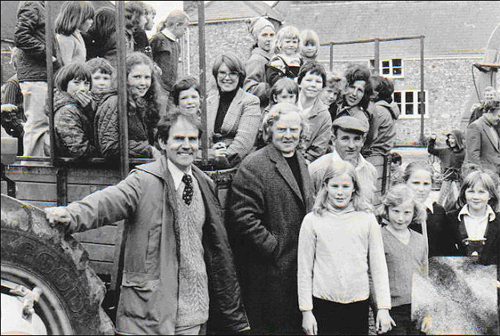
On this occasion in May 1980, 160 attended the evening filling 5 trailers. Extra trailers had to be brought in from neighbouring farms. After the tour of the farm everyone enjoyed a ploughmans supper provided by Mr & Mrs Stevens. The parents enjoyed cider and the children fresh milk. This picture shows the group preparing to set off. Mr Stevens is in the cap; also attending was the local vicar, the Rev Robert Raikes, who was Vice Chairman of the Managers and had four children at the school, and Mr John Broadhurst, the Head Teacher.
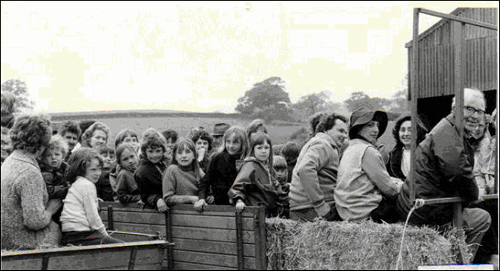
On a subsequent farm evening at Abbotts Wootton in May 1982 the tour around the farm was followed by hot dogs served by parents, for which there was a small charge. Sadly, due to health and safety and the cost of public liability insurance such an event would not now be possible as the trailers were all open and some of the fields are very steep. On one occasion one of the trailers slid slowly down a field and finished up at right angles to the gate it was supposed to be going through. Fortunately no-one was hurt and the children, not realising the possible danger, thought it was great fun.
One similar event, which was just as enjoyable, was held at another farm, Upcot Farm, Morcombelake, the home of Mr and Mrs Smith. Mrs Smith had a long association with the school, first having two boys at the school and as a Manager and classroom helper. She was then appointed as a welfare assistant for an individual child and later as an ancillary in the Reception Class taking over from Mrs Murial Edwards who had worked at the school for 28 years. Upcot Farm is owned by the National Trust and has beautiful views across Golden Cap and the lovely Dorset coast.
The evening consisted of a walk around the farm followed by a barbecue and the picture shows some of the eager children being served over one of the farm's trailers. This picture was taken in June 1983 and the PTA held similar events in May 1985 and June 1989.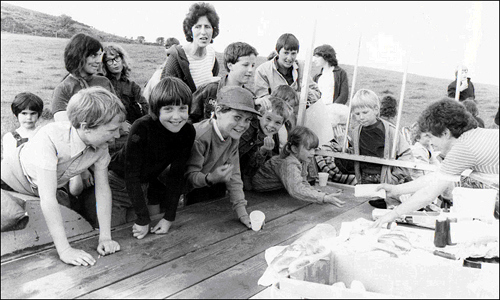
Upcot Farm was also the venue for several class visits by the Infant classes. The children were taken around the farm and spent time with the various animals learning how they are cared for. They were always made very welcome by Mr and Mrs Smith.
The PTA organised several other outdoor events which were purely for enjoyment. There was a nature quiz around the lanes of Wootton Fitzpaine where children competed in teams identifying various wild flowers and plants.
Treasure Hunts around Charmouth Village proved very popular. A sheet of clues, written by Mrs Ann Peach, took the contestants around different parts of the village in a circular route, starting and finishing at the school where light refreshments were waiting while the winner was decided.
Being a combined school it was important to have events around the area and Barn Dances were held in Whitchurch and Wootton Village Halls and one was actually held in a large barn at Befferlands Farm, the home of Mr and Mrs Andrews, which is between Charmouth and Whitchurch. At all PTA events parents and friends came willingly into Charmouth to take part, but it did not work so well the other way around.
In the school itself the Beetle Drives were well attended and thoroughly enjoyed, with some amazingly imaginative beetles designed by the participants, both adult and children. Prizes were awarded for the most original designs as well as the highest, and lowest, scores.
Quiz Evenings were tried, but were not quite so popular or well attended. People are often seem worried by the possibility of showing their ignorance. The school supported several charity events, most notably Comic Relief, or Red Nose Day. Here, in February 1983, Mr Paul Curtis is being sponsored to have his beard removed delicately by Miss Judith Reed, supervised by Anna Wiscombe, Mrs Mallabone, Zoe Buttling, Matthew Carey, Jo Bloxham, Clare Phillips and all suitably dressed and made up as clowns.
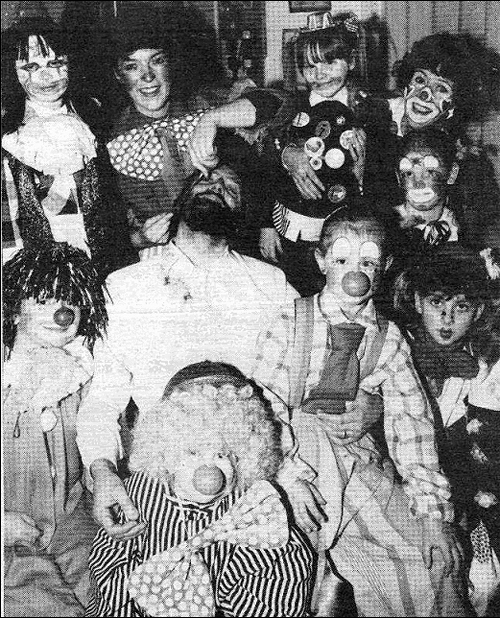
School club activities were open to the older children, Years 4 onwards. That decision was mainly made because of numbers involved, but also, as they were mostly after school, it would make it a long day for the younger children. The following clubs were held after school: football, netball, drama, gymnastics, rounders, short tennis, cricket, swimming, art, orchestra and athletics.
A stamp club for Year 6 children was taken by Mr Don Dampier, who was Chairman of the Managers, in the early 1980s and recorders groups were held at lunchtimes. With the exception of the stamp club all these were taken voluntarily by members of the teaching staff in their own time. The school was very fortunate to have dedicated teachers who were willing to provide these extra curricula activities. It often gave some children who were not particularly academically inclined the opportunity to shine. The school worked on the basis that the more activities there were the more likely it was that all children would find something they enjoyed and were good at.
The school enjoyed considerable success in the sporting field both locally and at county level. The girls won the local netball tournament on a number of occasions and once finished runner up at the county finals in Weymouth. The boys won the Randall Shield, the Smiths Crisp Tournament, held for many years on out two pitches where the school is now situated and the Kenway Cup, an eleven a side tournament for all primary schools in the area.
Success was also achieved in the Short Tennis Tournament, and the boys and girls teams were winners in the area athletics tournament at different times.
Alison Chiplin achieved a top award in an assessment scheme run by the Sunday Times in conjunction with the Amateur Gymnastic Association in January 1980. (See picture on the next page.
After any sporting event, win or lose, a member of the team would give a report on the event at the following morning's Assembly. This task was shared around during the season, organised by the captain of the team. This would enable the whole school to take pride in the achievements of their fellow pupils and also learn to lose in an honourable way. The teacher involved would be present to give back up and support to the ‘reporter'. If certificates had been awarded they would also be presented at the Assembly
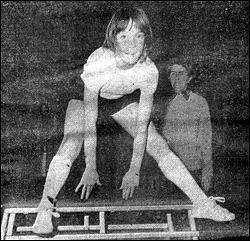
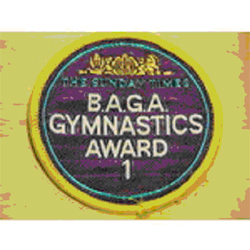
This picture of Alison Chiplin with her gym teacher, Miss Eleanor Ackroyd, who had been Head of PE at Colfox School, appeared in the local newspaper in January 1980. The material badge is similar to the one awarded to Alison.
There were badges awarded, starting at Grade 4, as the children progressed through the scheme. Every child achieved at least Grade 4, but Alison Chiplin, and later Joanne Craddock were the only ones to achieve Grade 1.
The gym club, for Year 6 pupils only, had been made possible by a grant of £700 made by Dorset Education Committee which enabled the school to purchase portable and fixed climbing frames, vaulting boxes and mats.
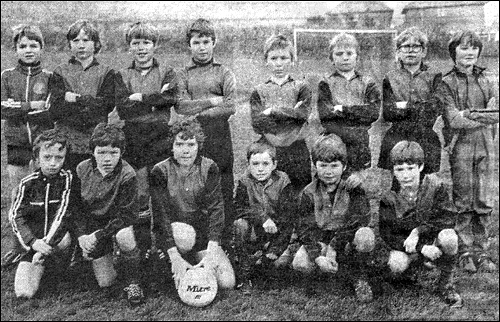
A few boys were chosen each year for the joint West Dorset football team. Exceptional children were selected by each school and the team chosen at a practice session before the first match. Paul Eaton is 4th from the left at the back and Steven Broadhurst is 2nd from the right in the front. They came up against teams from Poole and Bournemouth and lost their matches fairly heavily, but it was useful experience for them.
The teams usually played home and away so quite a few matches were held throughout the season. This joint team ceased to function soon after this photo was taken because of the practicality of getting the team together on a Saturday morning when children and staff became involved in so many activities.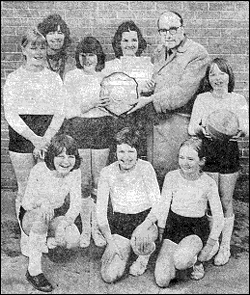
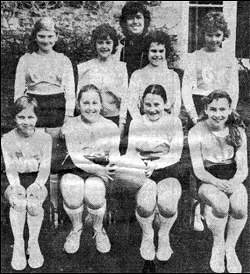
1979 Thorncombe Netball Trophy winners
Back row : Clare Matthews, Miss Rosemary Giles, teacher in charge of netball, Sally Peach, (Captain), Michelle Knapman,Mr Leonard Starkey, retired Head of Burton Bradstock School,
Front row : Rosalie Miller, Donna Cozens. Michaela Healy.
1981 West Dorset Champions and runners up in the County
Finals at Weymouth to Hill View School, Bournemouth
Back row : Claire Walker, Samantha Barron, Miss Giles, Sarah Harris,
Front row : Heather Fry, Vicki Holmes, (Captain),Rosalyn Day, Trina Aburrow.
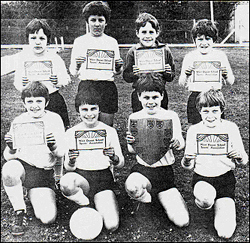
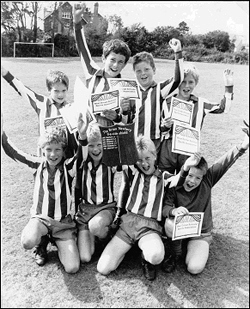
A seven a side competition held annually at Colfox School, Bridport
Back row : James Gorfin, Paul Hill, Geofrey Bulgin, Jonathan Butler.
Front row : Richard Poulton, Daniel Saphorghan, Tony Broadhurst, (Captain) Darren Smith.
A seven a side tournament held annually at Charmouth. The Smiths Crisps competition.
Back row : Jimmy Cook, Oliver Fortescue Simon Forsey, Adam Clark.
Front row : David Young, Alex Brooks, (Captain) William Parker, Robert Wickes
These are just a few of the football and netball tournament winners, successful thanks to the devotion and enthusiasm of their teachers and support of their parents.
The boys' pictures show them with their certificates awarded for West Dorset Schools Events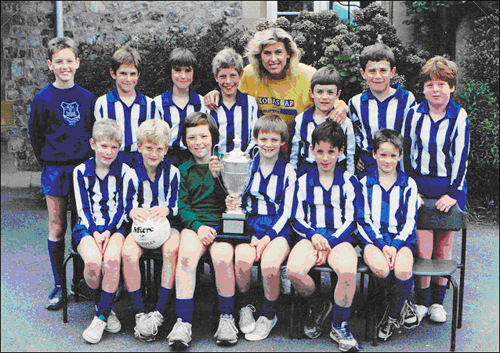
This 1987 team was a hugely successful side. They won the Kenway Cup open to all primary schools in the area and also the West Dorset Smiths Crisps Tournament, locally the Newbery Shield, They were then runners up in the Dorset County section of that competition at Wareham.
They are pictured here with Sharron Davies MBE, Double Gold Medallist at the Commonwealth Games and Silver Medallist at the Olympic Games in Moscow. She was at the school as the celebrity for the Superschools Event. She kindly agreed to be photograph with the winning football team.
Back row : Scott Colbert, Robert Pitt, Cian Pettitt, David Young, Sharron Davies,
Paul Chapman, Oliver Fortescue, Simon Forsey.
Front row : Alex Brooks, William Parker, Jamie Clark, Mathew Curtis, (Captain)
Stewart Hunt, Jimmy Cook.
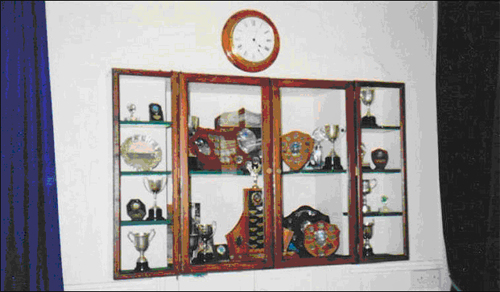
With the number of trophies won by teams and individuals increasing it was decided to have a special trophy cabinet made which was put on the wall in the centre of the hall. The Sports Day Shield and individual cups and shields presented at the Leavers' Concert were also kept in the cabinet. Several trophies were donated for specific academic or sporting excellence.
The Transformation of the Old Building.
Since the school moved to its new premises the old building has been converted into four habitable units and two blocks of terraced affordable homes built on the rest of the site. The terraced houses are in two blocks, one of five dwellings and one of eight. The School house is now one unit, the hall which was 950 square feet plus the kitchen is two units and the classroom off the hall, 400 square feet is the fourth unit. The pictures on the following pages show how that transformation took place.
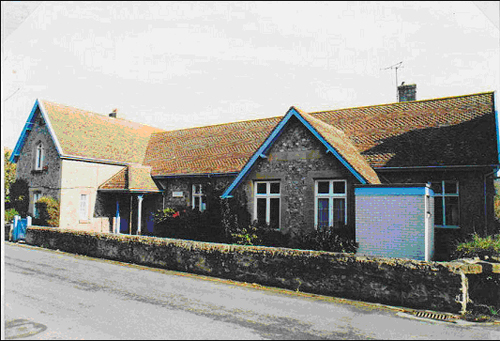
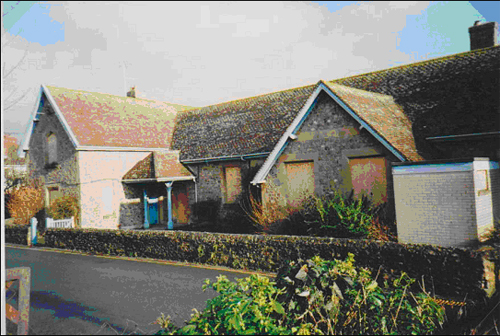
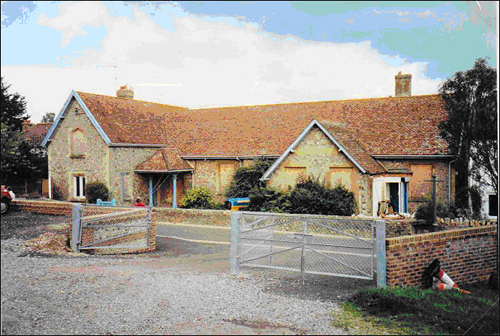
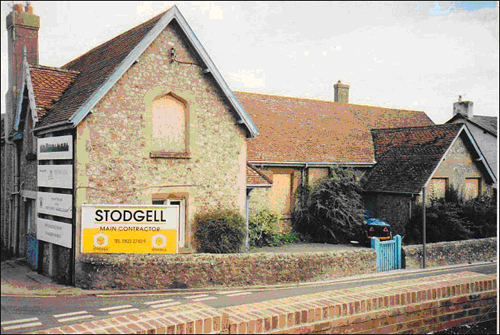
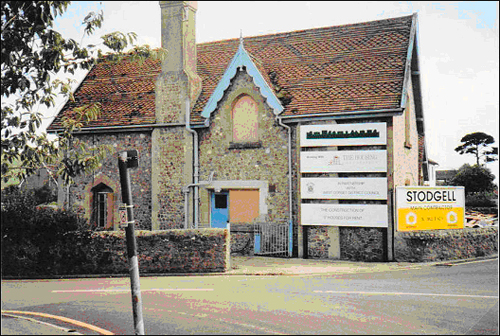
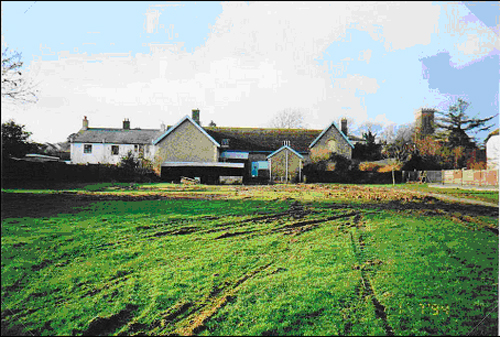
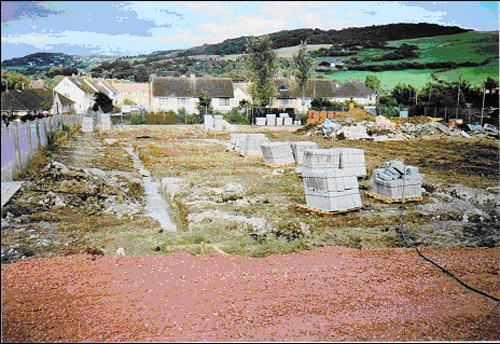
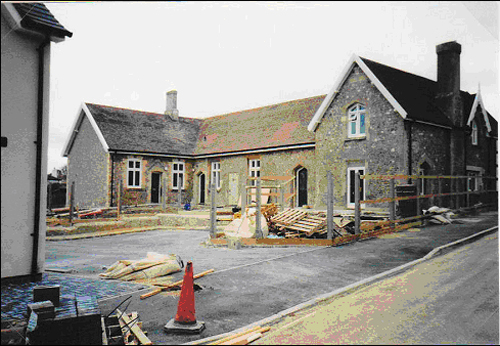
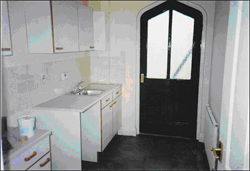
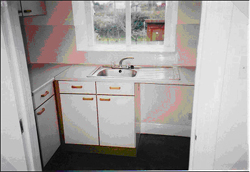
These pictures were taken in 2012 and show the old school and the properties that were put onto the area where the mobile classrooms and the playground had been; 17 dwellings in total.
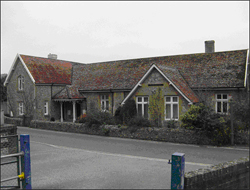
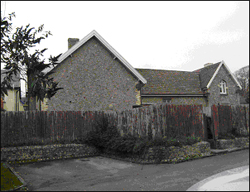
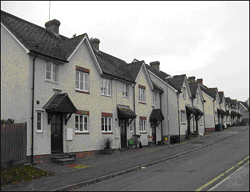
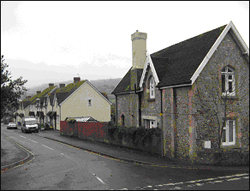
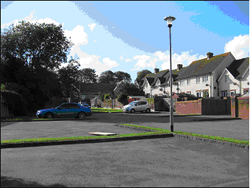
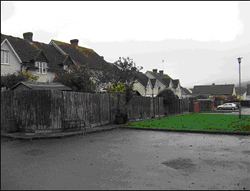
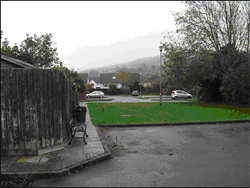
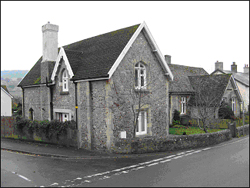
This is the site of the present school. Pictures taken during a Sports Day show the layout of the whole field. For Sports Day the County ground staff marked out lanes for the events. The width of the field was approximately 70 metres. The senior flat races and relays were from that distance. Other races were shorter, but all finished at the same place. There was quite a dip, just visible on the bottom right picture, which didn't prove much of a problem for the children, but caused an occasional pile up in the parents' races. The children were positioned, in teams, on the West side of the field and the parents and friends watched from the East side. The picture doesn't show all the spectators because they tended to congregate around the finish line.
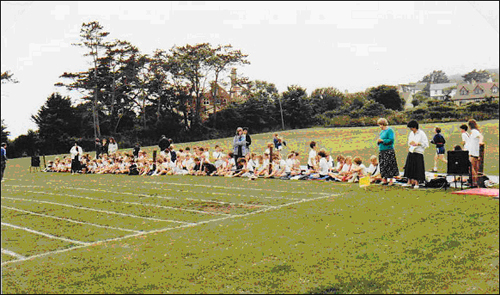
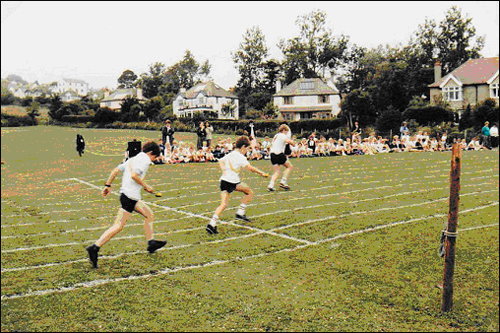
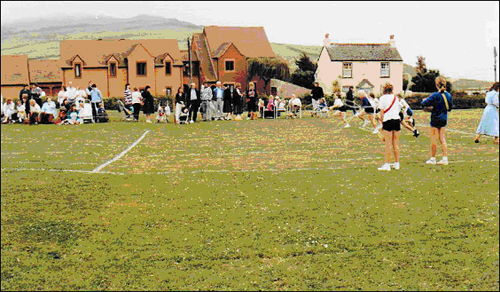
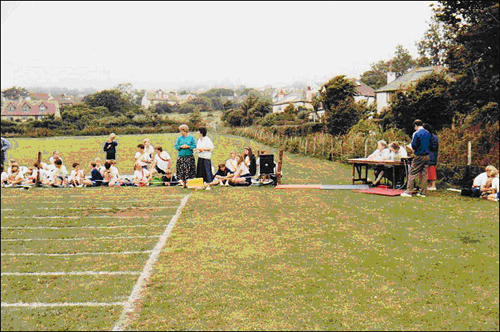
Since the above photos were taken much has changed on the playing fields!
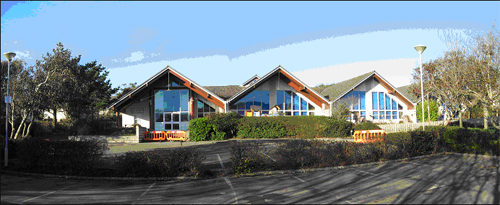
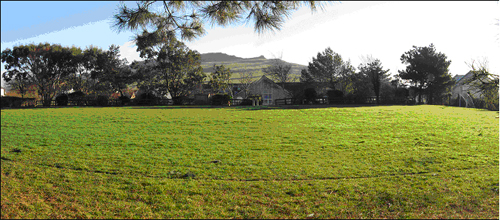
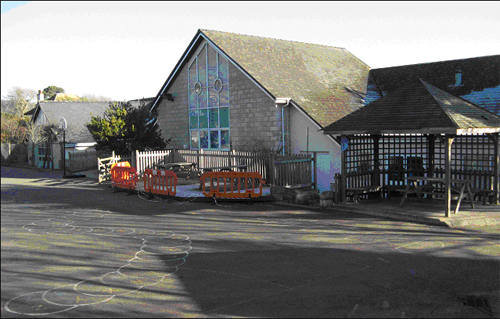
The same thing has happened at the new school as happened at the old building. Due to lack of space an extra classroom has been added in the North West corner.
There have been several other alterations and improvements since the building was first opened in 1993. Mezzanine floors have been added to the Library area and the original Deputy Head's office. The kitchen has been enlarged to cater for school lunches and a new staffroom has been added next to the girls' toilets.
The original staffroom has also been enlarged to provide a teaching area. Alterations have also been made to the Secretary's office to make room for additional staff and the increased administration now necessary.
Outside attractive sitting areas have been added to the playground without taking up any of the original play area, as can be seen in the picture above.
Also added are four raised beds to encourage the children to take an interest in gardening.
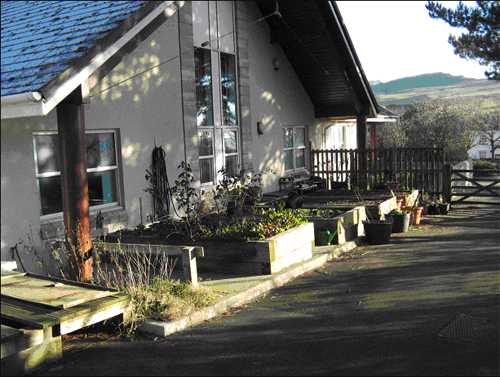
The grounds have changed considerably in the, almost, 20 years since the school opened as is shown below. Photos taken in similar positions in:-
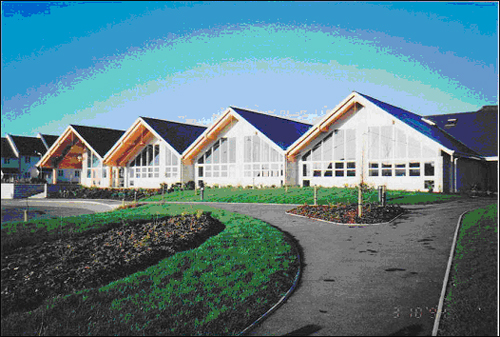
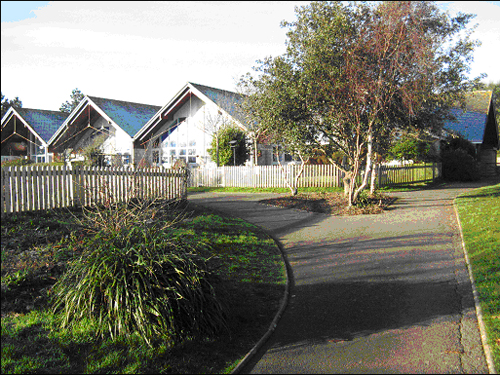
1993
2012
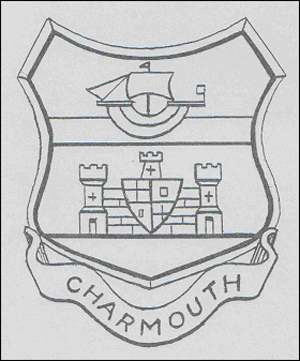
Mr Don Dampier, Chairman of the Manager's in the 1970s and 80s, found the above design on a postcard whilst on holiday in Wales. The crest was adopted by Charmouth Parish Council as the official emblem for Charmouth. The school also decided to adopt the crest and it appears on all the children's T shirts and sweatshirts as well as the school headed notepaper. The crest was also etched onto the huge pain of glass over the main entrance. There is a carved wooden version of the crest in the Parish Council Office.
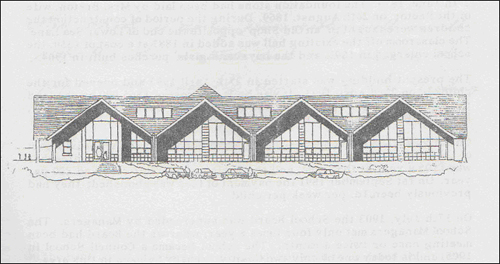
The last group to spend a whole year in the old building, transferring to secondary school in September 1992, wrote down some of their thoughts about the school. Below are some of those ideas, written for a book to be put into a time capsule. The book also contained pictures by the children and photographs of the activities they particularly enjoyed during their time at the school. Unfortunately the construction firm omitted to create a space for the capsule. The selections below are from children of all abilities. It was interesting that, although these children appreciated how the new building would be better in many ways, they were not sorry they were not going there, because they preferred to be able to remember the school as they had always known it.
.jpg)
.jpg)